

Coral Ocean
- 73m | Lurssen | 1994 (2022)
- captain & crew
- specifications

An iconic 73m superyacht delivered as Coral Island by Lürssen back in 1994 (one of the yard’s biggest projects at the time) with an exterior profile designed by the godfather of modern yacht design Jon Bannenberg, Coral Ocean was purchased by Malouf in 2020 and, having recently undergone a 35million euro refit in 2022 at the Astilleros de Mallorca shipyard, she is now one of the most in-demand charter yachts on the market.
No stranger to large-scale refits – the Malouf family also transformed their 52.5m Baglietto motor yacht Mischief in 2016, which is now based in Sydney, Australia – Ian, Captain William Kaye and their team worked meticulously to ensure no detail was overlooked during the almost two-year refit, which is clear as soon as charter guests step on board and are engulfed by an aura of calm and serenity.

Be it an intimate family vacation or a charter with friends, Coral Ocean is set up to offer an unparalleled experience of elegance, class and sophistication, serviced by 22 crew members. Perhaps the most impressive space on board, her sundeck was rebuilt entirely during the refurb to create a more open and flexible space great for both relaxing and entertaining. At the same time, her old communications domes were removed, allowing the deck to be extended in size and increasing her total volume by 120GT.
Allowing for unobstructed views without compromising on safety, the huge open space is surrounded by glass balustrades, while the sunlounge also comes complete with a large umbrella creating the perfect spot for an afternoon siesta. It’s here you will also find the impressive glass bottomed spa pool, cleverly designed by the team behind the Four Seasons’ spas.

When it’s time to cool off, head on over to the stylish skylounge housing a full-service bar and aft balcony, with a high-tech sound system and an 85-inch TV doubling as an open-air cinema.
The largest dining space can be found on the aft deck, which is home to a stunning Paolo Lenti table seating up to 12 guests. Large sunbeds on each side also convert into dining tables for 10, while sliding glass doors and ceiling heaters provide protection from the wind while offering a dual indoor-outdoor experience. Ideal for foodie charters, it’s also home to two bars, a pizza oven and a teppanyaki grill where chefs can whip up delicious meals throughout the day. For more formal occasions, the elegant dining room was designed by renowned interior designer Blainey North with seating for 14 guests.
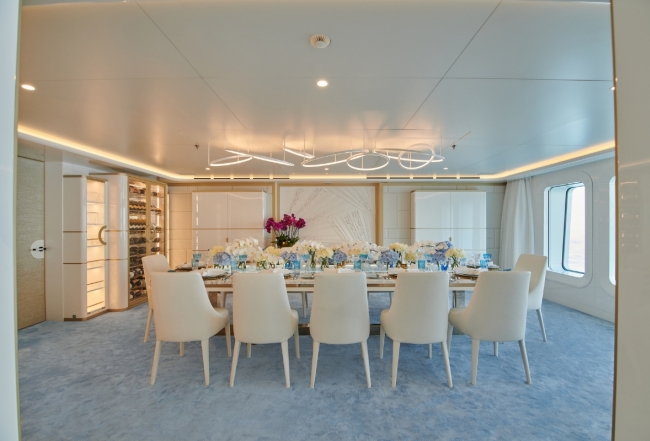
Step inside Coral Ocean and every space is fresh and bright, with white reflective surfaces and ocean-inspired accents of marine blues and greens. She sleeps up to 12 guests in six beautiful cabins, with a master suite to impress even the most discerning of charter guests, complete with panoramic views, a super-sized Hastens bed, his and her en suite bathrooms, a hair salon, an infra-red sauna and a private lounge.
Not to be outdone, the VIP suite is just as impressive, complete with a lounge that doubles as a cinema room or office, and four further cabins boast kingsize beds – one of which can be converted to Hollywood singles.
Coral Ocean is also an excellent choice for a wellness charter. Home to a Four seasons spa, indoor/outdoor gym and steam room, she also has her own private treatment room with an onboard therapist offering massages, facials, mani-pedis, waxing, tinting and LED light therapy. What more could you wish for?
Other Yachts You Might Like
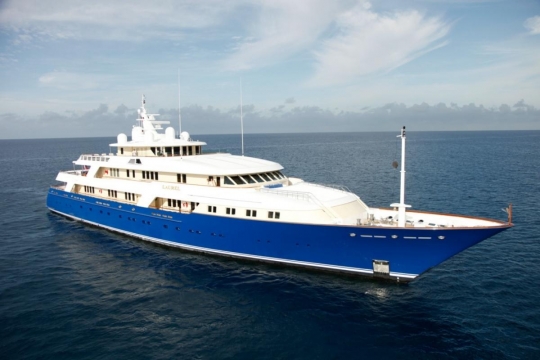
73.2m | Delta Marine | 2006 (2014)
from $525,000 per week + expenses

Quantum of Solace
72.6m | Turquoise | 2012
from €560,000 per week + expenses

Coral Ocean
12 Day Guests /
12 Overnight Guests /
From $650,000
CORAL OCEAN is an iconic 73m Superyacht, built by Lurssen and designed by the revered Jon Bannenberg. Formerly known as Coral Island, this is the yacht that changed Superyacht design forever. CORAL OCEAN underwent a transformative refit in 2022 with no expense spared, and no detail overlooked.
Whether an intimate family charter or cruising with friends, CORAL OCEAN offers an unparalleled experience of elegance, class and sophistication on the water. At 73m, CORAL OCEAN crosses into the elite megayacht class, an exclusive club of only 60 vessels available for charter.
The Main Saloon features its original 5m opening shell door, creating a balcony over the sea for breathtaking sunset cocktails. The Bridge Deck Aft offers a dining capacity for 32 guests, with sunpads converting into tables for 10. The deck is complemented by two fully serviced bars, pizza oven, teppanyaki grill and full service kitchen to allow for the ultimate Chef’s entertainment experience.
The Master suite is complete with every amenity you could desire. This home away from home comes complete with his and her ensuites, hair salon facilities, infrared sauna, ample hanging space for your outfits and a private lounge. It also boasts two magnificent skylights and panoramic 180-degree views to ensure you enjoy stunning views from the moment you wake. Five other spacious cabins, including a VIP suite, have all been elevated to be of equal quality leaving every guest onboard feeling like the owner. In addition there is one supernumerary cabin with ensuite.
The onboard spa therapist is on hand to provide guests with a multitude of treatments any time of the day. The spa menu includes, massages, manicures, pedicures, facials, waxing, tinting, light therapy… the list goes on.
Owned by a very active family, she is equipped with all the latest and greatest toys, amenities and entertainment; including flite boards, sea bobs, go cycles, water slide, 15m Funair pool extension, infrared sauna, steam room, hair salon and treatment room, Xbox, sundeck cinema, disco deck, JBL speakers, Crestron and Kaleidoscope entertainment systems.
Tender & Toys
With so many activities onboard you will never have a dull moment –
- Jet skis x 2
- Seabobs x 2
- Stand-up paddle boards x 6
- Flite board x 3
- Sea scooter x 2
- 12m Pardo 38 Chase boat
- 6m & 8m RIBs
- Funair Slide
- Clear-bottom kayak
- Assortment of towables
- Sundeck Cinema
- Glass bottom spa pool
- Electric bikes x 4
- Fishing gear
- Snorkelling gear
- Gym equipment
CORAL OCEAN needs to be seen to be believed, so get in touch to get onboard and see for yourself.
Rates start from: $650,000
Because rates are flexible per season or type of experience, please enquire today and our team will be straight in touch.
| Coral Ocean | |
| 73m / 238ft | |
| 12 | |
| 12 | |
| 7 (Master, VIP, 3 x King, 1 x King convertible, 1 x Nanny room) | |
| Mediterranean | |
| Caribbean |
Enquire about Coral Ocean
Tell us a little about what you want your experience onboard Coral Ocean to be, and one of our team will get back to you today!
Experiences
Enhance your adventure with unique experiences by The Superyacht People.
Laser Clay Shooting
Private dining room, whisky masterclass, dj/live musician, yacht branding, long table lunch, photography/drone.
- Ordered by Shipyards & Yacht Brands
- Ordered by Date
- Yacht Designers
- About and Contact
- Yacht Support Vessels
- Tenders & Toys
- Some interesting other sites in the superyacht world
Coral Ocean // Lürssen Yachts // Jon Bannenberg
The 22-year old coral ocean (also built by lürssen and launched as coral island) had an extensive refit. the yacht was designed by the legendary jon bannenberg ..
Pictures: Jeff Brown
During her life, Coral Ocean got several refits, so the owner enjoyed a well-maintained yacht. In the last winter, the yacht got some updates to meet charter regulations. It is now the first charter season.

She has six staterooms for 12 guests in total and an accommodation for a crew of 20. Her Caterpillar engines power her up to 17 knots, her cruising speed is 14 knots with an operating range of 6,000 nautical miles.
By the way, last winter 8 yachts paid a visit at Lürssen for upgrades or maintenance. Among others Phoenix², Global, Radiant and Quantum Blue.
The yacht is for sale with an asking price of €31,950,000. Offers are encouraged. Moreover, Coral Ocean is available for charter for €700,000 per week.
SHARING IS CARING - THANK YOU!
Bering yachts b120, am 37 – the yacht addition to your aston martin car, a88 gransport // officina armare, 60m supernova // vripack, extra 86 fast // isa yachts // guida design, bijoux // moonen yachts, tetrosomos 45 // green yachts, big fish // mcmullen & wing.
About Publisher

Using a minimum of third party cookies for YouTube, Vimeo and Analytics.
Privacy Preference Center
Privacy preferences.
Google Analytics
CORAL OCEAN
- Description
CORAL OCEAN
Uncover uncapped opulence and adventure aboard CORAL OCEAN, one of the most iconic superyachts available for charter. A symbol of unparalleled luxury and timeless elegance, CORAL OCEAN offers an exceptional experience for those who desire the very best. A 72-meter (236 feet) masterpiece, CORAL OCEAN is the epitome of luxury yachting. Designed by the legendary Jon Bannenberg, this yacht is celebrated for its bold lines, innovative design, and impeccable attention to detail. From her striking exterior to her meticulously crafted interiors, every aspect of CORAL OCEAN exudes sophistication and style. Originally built in 1994, CORAL OCEAN was loved by private hands for most of her life and has undergone an amazing 35 million Euro rebuild, delivering an unparalleled charter experience.
World-Class Amenities
Step aboard, and you’ll find yourself immersed in a world of refined elegance. The yacht’s interiors are a blend of contemporary design and timeless luxury, featuring rich woods, sumptuous fabrics, and custom furnishings. With accommodation for up to 12 guests across six exquisitely appointed staterooms, CORAL OCEAN ensures that every guest experiences the utmost in comfort and privacy.
The jewel in the rebuild crown is the new Sundeck which has been entirely rebuilt to create an amazingly open and flexible space equipped with the latest must have features such as surrounding glass balustrades that enable unobstructed views. The Sky lounge on the Sun deck is ultimate relaxation space and has it all. The full-service bar, round dining table, aft balcony and observation area is an amazing combination suitable for any meal or social occasion. It is further equipped with a full range of gadgets including an indoor and outdoor sound system, in-built electric skylight roof and in-ceiling retractable 85-inch TV.
The yacht also features a fully equipped gym, a wellness area with a sauna and massage room, and a beach club, ensuring that every moment aboard is filled with indulgence.
Luxurious Accommodations
The Master Bedroom situated on the new Owner’s deck boasts a newly built private area complete with every desired amenity and equipped with two magnificent skylights looking into the sundeck ensuring an abundance of natural light, which can then be closed for block-out closure. To the aft of the Owner’s suite is a completely revitalised space that can host events of any format and size. Sliding glass and ceiling heated panels provides protection from the wind and offers a dual indoor-outdoor experience ideal for those beautiful Mediterranean days and evenings. As the largest level on the boat, the main deck boasts an impressive array of spaces that can be tailored for any private or public occasion.
On the lower deck, guests will discover four generous bedrooms complete with king beds, Analu bedding and each with its own luxurious ensuite. All cabins are fully equipped with Totti toilets, Dior soaps and perfumes, Ikou organic products, Oribe hair products and Hermes and Chanel toiletries. These incredibly designed cabins with fully equipped amenities will ensure that everyone on board will experience the ultimate in style and comfort within their very own private sanctuary.
Tender & Watersports
For those who love the thrill of adventure, CORAL OCEAN is equipped with an array of water toys and tenders. Explore hidden coves on a jet ski, dive into the crystal-clear waters with snorkeling gear, or experience the exhilaration of waterskiing and wakeboarding. The yacht’s professional crew, including expert guides and a dive master, are on hand to assist with all activities, ensuring that your adventures are safe, exciting, and tailored to your preferences.
CORAL OCEAN has multiple tenders and the 38-foot shadow vessel, LITTLE CORAL, is the ultimate way to exit the yacht when visiting ashore, providing the best comfort if you feel like cruising close to shore exploring your new destination.
Water sports are all part of the fun and having all the toys is an essential part of the yachting experience. CORAL OCEAN takes your holiday to the next level with the sea pool floating off the back of the yacht complemented by the paddle boards, Flite boards, jet skis, sea bobs, water slide and much more.
Exceptional Service & Bespoke Experiences
At the heart of the CORAL OCEAN experience is a commitment to exceptional service. With a dedicated and professional crew, including a highly experienced captain, gourmet chefs, and attentive stewards, you can expect nothing but the highest standards of hospitality. Every detail of your charter is customized to your desires, from the menu and itinerary to the activities and entertainment. Whether you’re planning a romantic getaway, a family holiday, or a corporate retreat, the crew of CORAL OCEAN will go above and beyond to ensure that your time aboard is truly extraordinary.
Don’t miss out on this unrivalled superyacht, contact our expert charter team to discover more now!

Specification
| Stock Number 1694 |
| Yacht Type Power Monohull |
| Year Built 1994, Refit 2022 |
| Day Guests Please Enquire |
| Summer Cruising Area Caribbean |
| Yacht 73M Lürssen |
| Length 239’6” | 73M |
| Display Price POA |
| Overnight Guests 12 |
| Winter Cruising Area Mediterranean |
Enquire for Yacht Charter
More About CORAL OCEAN
CORAL OCEAN Yacht For Charter
Status: For charter Price:
Motor Yacht CORAL OCEAN for Charter
At 237.9 ft / 72.5 m, the CORAL OCEAN yacht for charter was built by Lurssen , and launched in 1994, and refit in 2022. Accommodating 12 guests in 7 staterooms, her exquisite interior styling is by IBL Design , while her exterior lines were drawn by Jon Bannenberg , resulting in an elegant, and stately yacht ready to welcome guests. Serviced by 22 crew, she has a beam of 42.7ft / 13m, and a draft of 12.1ft / 3.7m, along with engines that power her up to 13 knots at cruising speed, while maximum speed is at 15 knots.
Download PDF Brochure ,
Download PDF Brochure
- Specifications
| Length |
| 237.9 ft / 72.5 m |
| Builder |
| Lurssen |
| YEAR/REFIT |
| 1994/2022 |
| Guests |
| 12 |
| Staterooms |
| 7 |
| Gross tons |
| 1,528 |
Page Contents
- Yachts for charter
Contact: Merle Wood & Associates | web(Contact us at)merlewood.com | +1.954.525.5111
Related How To Charter A Yacht | Luxury Charter Yacht Events | About Luxury Yacht Charter | What Is A Yacht Charter
Photos Of The CORAL OCEAN Yacht For Charter
View the photo gallery page to browse all photos of the CORAL OCEAN yacht for charter , including interior and exterior images.
CORAL OCEAN Yacht Video
View the CORAL OCEAN yacht video . ,
CORAL OCEAN Yacht For Charter Price
Eur usd gbp sar cny brl chf rub aud.
select a currency
CHARTER PRICE
Send Enquiry
ASKING SALES PRICE
For additional charter price information, including winter and summer charter rates and similar yachts for charter, view the CORAL OCEAN yacht for charter price . To see if the CORAL OCEAN yacht is offered for sale and its asking price, view the CORAL OCEAN yacht price .
Not offered for sale or charter to U.S. residents while in U.S. waters unless under a boat show bond or in an FTZ.
Amenities Aboard The CORAL OCEAN Yacht For Charter
Water Sports & Tenders
Features & Entertainment
For a complete list of amenities available or for a first-hand review of the CORAL OCEAN yacht, simply request assistance from our qualified luxury yacht brokers. Our team of yacht specialists travel the world visiting and experiencing yachts for charter and not for charter. Because of this, they have expert knowledge about every luxury yacht for charter, and can provide further details about the features, amenities and condition of the most notable yachts on the water.
Related Yacht With A Helipad | Yacht With A Submarine | Yacht With A Jacuzzi | Huge Yacht Water Slide
CORAL OCEAN Yacht Specifications
| 12GUESTS | 7STATEROOMS | 22CREW | 15KNOTS |
| BUILD DATA | |
| BUILDER | BUILDER LOCATION |
| Lurssen | Germany |
| NAVAL ARCHITECT | BUILT |
| Lurssen | 1994 |
| EXTERIOR STYLIST | REFIT |
| Jon Bannenberg | 2022 |
| INTERIOR STYLIST | |
| IBL Design |
| HULL & DIMENSIONS | ||
| LENGTH | BEAM | DRAFT |
| 237.9 ft / 72.5 m | 42.7 ft / 13 m | 12.1 ft / 3.7 m |
| GROSS TONNAGE | FLAG | |
| 1,528 | Marshall Islands | |
| HULL | DECKS | |
| Steel | Teak | |
| CLASSIFICATION | ||
| Lloyd's Compliant |
MORE DETAILS
| Builder : | Country : | Built : | Refit(s) : | Naval Architect : | Exterior Stylist : | Interior Stylist : |
| Lurssen | Germany | 1994 | 2022 | Lurssen | Jon Bannenberg | IBL Design |
| Length : | Beam : | Draft : | Gross Tonnage : | Hull : | Flag : | Classification : |
| 237.9 ft / 72.5 m | 42.7 ft / 13 m | 12.1 ft / 3.7 m | 1,528 | Steel | Marshall Islands | Lloyd's Compliant |
We provide accurate specifications, details and current information on yachts for charter around the world. Read the complete CORAL OCEAN yacht for charter specs and analysis.
CORAL OCEAN Yacht Position
Charters in: update coming soon.
View more details about the winter or summer itinerary, cruising regions and the last known CORAL OCEAN yacht position .
CORAL OCEAN Yacht For Charter Enquiry
For more information and expert knowledge about the CORAL OCEAN yacht for charter, from a qualified yacht charter broker , simply contact the luxury yacht brokerage firm of Merle Wood & Associates for assistance.
- 1-954-525-5111
- web(Contact us at)merlewood.com
- About us
I'm interested in:
Chartering a yacht Buying a yacht Selling a yacht Charter marketing Building a yacht Other
Please leave this field empty.
More Yachts For Charter & Sale
CORAL OCEAN Yacht For Charter
The CORAL OCEAN yacht for charter has been displayed to provide our visitors the most current and accurate data for this luxury yacht for charter. If you would like to report an error or submit additional information on the CORAL OCEAN yacht, please contact our luxury yacht intelligence team .
At Merle Wood & Associates, we focus on providing the best user experience throughout our website for our visitors. We achieve this by using cookies, which store a little information from your browser. If you would like to learn more, please see our privacy and cookies policy .
- Yacht Search
- Charter a Yacht
- Buy A Yacht
- Build a Yacht
- Sell a Yacht
Your Name (required)
Your Message
Please call me Please email me
Your Phone (required)
CANCEL Please leave this field empty.
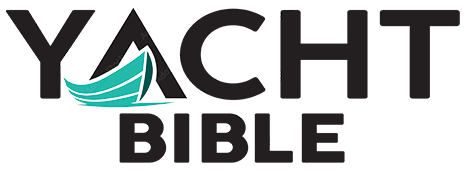
The Best Yacht Concepts From Around The World

The Stunning Ritz Carlton EVRIMA Yacht

Gliding Across Tokyo’s Sumida River: The Mesmerizing Zipper Boat

CROCUS Yacht: An 48 Meter Beauty by Admiral
- Zuretti Interior Design
- Zuretti Interior
- Zuccon International Project
- Ziyad al Manaseer
- Zaniz Interiors. Kutayba Alghanim
- Yuriy Kosiuk
- Yuri Milner
- Yersin Yacht

- Superyachts
CORAL OCEAN Yacht – Phenomenal $50M Superyacht
Previously known as CORAL ISLAND, CORAL OCEAN yacht is an immaculate superyacht built in 1994 by world-renowned Lurssen in Germany.
Measuring in at a length of 72.5 meters she has previously been featured on display at the Monaco Yacht Show, Miami Yacht Show, and Palm Beach International Boat Show.
| Coral Ocean | |
| 73 m (238 ft) | |
| 12 in 6 cabins | |
| 19 in 9 cabins | |
| Lurssen | |
| Jon Bannenberg | |
| Jon Bannenberg | |
| 1994 | |
| 17 knots | |
| Caterpillar | |
| 1,379 ton | |
| 1004833 | |
| US$ 50 million | |
| US$ 3 – 5 million |

CORAL OCEAN yacht interior
The stylish interior of the CORAL OCEAN yacht was designed by English designers Bannenberg & Rowell.
She features 6 suites that can comfortably accommodate up to 12 guests. The suites are comprised of two twins, two doubles, one VIP, and one master suite.
To cater to the guest’s needs are 19 highly trained crew members to provide optimal service.
CORAL Ocean features impressive facilities built for leisure and entertainment. It features a pool as well as a well-equipped gym.
CORAL OCEAN yacht Specifications
CORAL OCEAN measures a total length of 72.54 meters (238 ft). Her beam is 13.05 meters (42.8ft) long, and her draft measures 3.26 meters (10.7ft).
She weighs in at an impressive 1,379 tons. Powered by 2 Caterpillar engines she can reach top speeds of 17.4 knots, although her average cruising speed lies closer to 16 knots.

CORAL OCEAN yacht exterior
The sleek exterior of this vessel was designed by none other than Bannenberg & Rowell Design.
They are no strangers when it comes to designing luxury superyachts having been responsible for the design of the 16th largest superyacht in the world, RISING SUN .
When it came to the design of CORAL OCEAN it’s obvious they brought the same level of workmanship and quality to the project.
The upper decks are white which contrasts beautifully with the sandy-white beige hull.
CORAL OCEAN yacht price
CORAL OCEAN was last refit in 2016 and now has an estimated value of US $50 Million with an annual running fee of $3-5 Million.
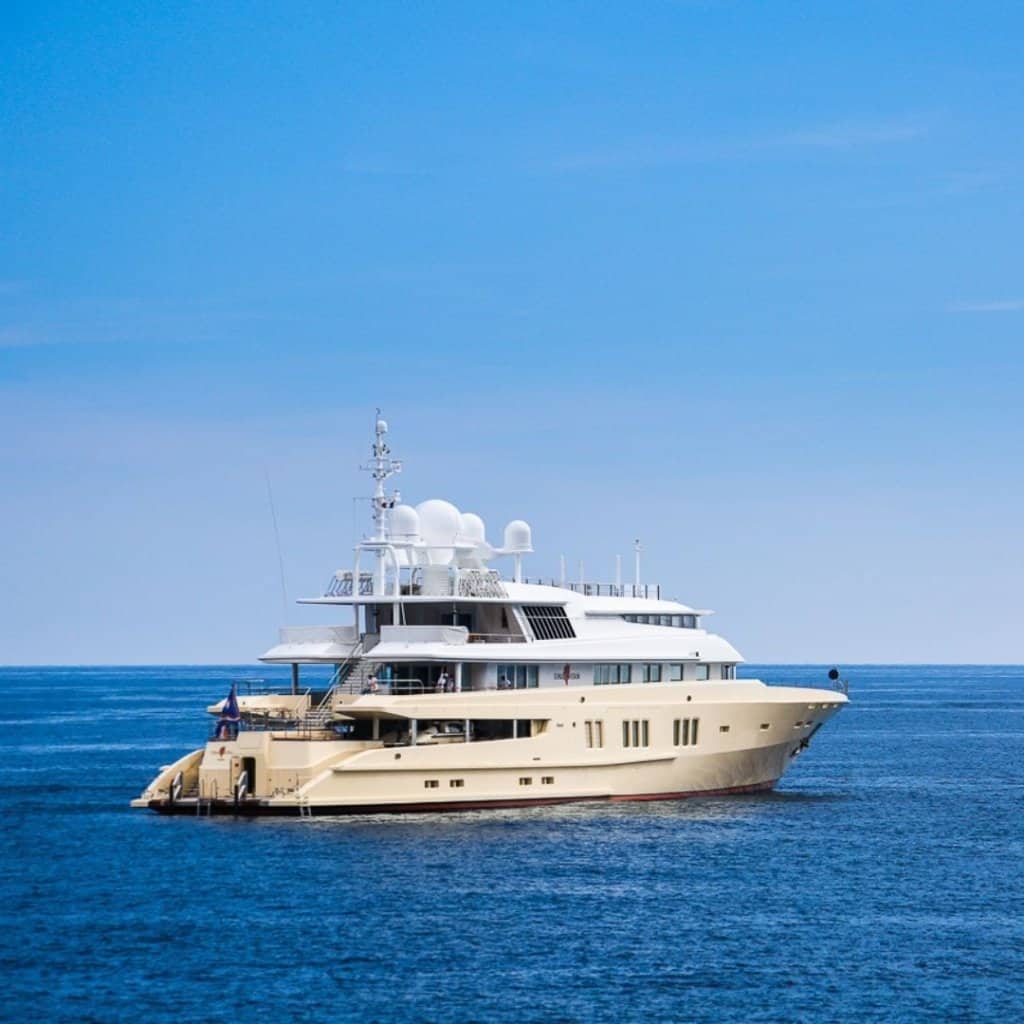
CORAL OCEAN has a wide array of water toys and accessories to keep guests entertained. She is home to two F5S SEABOBS as well as Jobe Defiant waterskis that are a pleasure regardless of the experience level.
In addition, she has a wide range of wakeboards, paddleboards, snorkeling equipment, and four Tenders to transport guests to their destination.
Do you have anything to add to this listing?
- Caterpillar Engines
- Coral Ocean Yacht
- Jon Bannenberg
Love Yachts? Join us.
Related posts.

YACHTI ANA Yacht – Inside The $2.69 Million Superyacht
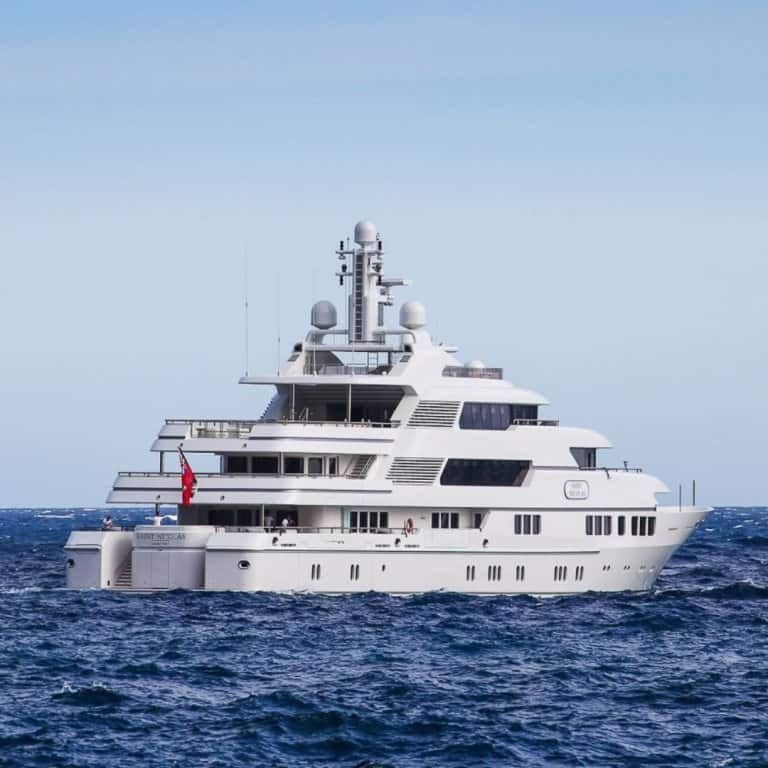
SAINT NICOLAS Yacht – $70M Superyacht

MADSUMMER Yacht – Phenomenal $250M Superyacht

AHPO Yacht -The Amazing New $300 Million Superyacht
- Yacht Sales
- Destinations
- Monaco Grand Prix
- About Ahoy Club
- Meet The Team

CORAL OCEAN
Charter Price
Low EUR 495,000
High EUR 790,000
Yacht Length
73m (240ft)
Sleeping Capacity
Low EUR 27,500
Cruising Capacity

CORAL OCEAN is an iconic 73m (238ft) superyacht, built by world’s leading shipyard Lurssen and designed by Jon Bannenberg. Formerly known as Coral Island, this is the yacht that changed the superyachts’ design forever. CORAL OCEAN underwent a transformative refit in 2022 with no expense spared, and no detail left incomplete. Whether an intimate family charter or cruising with a larger group, Coral Ocean offers an unparalleled and world-class experience of elegance and sophistication on the water.
The Famous Refit
The sundeck has been rebuilt to create an amazingly open and flexible space equipped with the latest “must have” features, such as the surround glass balustrades that enable unobstructed views. The refreshed spacious sun lounge provides ultimate sunbathing along with full umbrella coverage and the stunningly redesigned spa pool, with complimentary glass bottom, will ensure relaxation in style. Coral Ocean represents the ultimate and unforgettable yachting experience. With all the modern attributes submersed in absolute luxury and comfort, we also provide world-class service coupled with the most opulent and fine-dining cuisine.
Entertaining Areas
From full-service bar, round dining table suitable for anytime of the day to aft balcony and observation area, indoor and outdoor sound system, in built electric skylight roof, in ceiling retractable 85-inch TV and to top it off, the unique convertible indoor sunbed complete with opening sunroof. The upper deck dining can host events of any format and size. With its sliding glass to protect from the wind, this space offers a dual indoor and outdoor experience ideal for those beautiful Mediterranean days and evenings, capable of seating 30 guests and complete with a full range of entertainment options including bars, kabana style seating, adjustable tables and day/evening beds. The Main Deck, which provides another incredible and unique option for a couple to live and entertain on their very own level. Spacious outdoor areas can later be converted into an outdoor disco and dance floor for those fun evenings on board. Heading inside you can find another spacious lounge, with the very unique 6 metre wide side opening door that makes this lounge the perfect place for either relaxing evenings or casual drinks before dinner, which can be enjoyed right next door in the truly exquisite dining room, where the most eloquent of dinner parties can be savoured.
Guest Accommodation, Sauna & Spa
The Master Bedroom has two magnificent skylights and panoramic 180-degree views, including his and her en-suites with infrared sauna, hair salon facilities, as well as a private lounge area. The treatment room provides an adjoining private sanctuary for all your health and beauty needs. After unwinding in the infrared sauna, and spoiling yourself at the hair salon, you can enjoy a relaxing massage, manicure, pedicure and facial from your very own onboard highly experienced and beauty therapists. It is rare on any yacht for the VIP Suite to be considered the equivalent of the owners cabin, but this is what has been delivered aboard Coral Ocean. Adjoining the VIP Suite, is its own full size private lounge room, which has multiple uses, as a movie cinema, general lounge, and coffee area as well as an integrated office space. Coral Ocean has four lavish guest bedrooms, each with its own luxurious en-suite. Each Room is furnished with king beds, and one of them can be converted into holly wood singles.
Water Toys & Activities
Water sports are all part of the fun and having all the toys is an essential part of the yachting experience. Coral Ocean takes your holiday to the next level with the sea pool floating off the back of the yacht complemented by the paddle boards, flite boards, jet skis, sea bobs, water slide, and much more. Coral Ocean has multiple tenders and the 38-foot shadow vessel, Little Coral, is the ultimate way to exit the yacht when visiting ashore, providing the best comfort if you feel like cruising close to shore exploring your new destination.
Specifications
Build Year 1994
Rebuild 2022
Flag Marshall Islands
Registry Port BIKINI
Gross Tonnage 1528
Builder Lurssen
Architect Jon Bannenberg/H2
Interior Design Custom by iBL Design
Cabin Layout
Master Suite: 1 Master (own level, super king bed, his & her ensuites)
VIP Suite: 1 VIP (own level, study & lounge)
Guest Cabins: 4 Super King Rooms (1 room convertible into king singles)
Single Cabin: Suitable for supernumeraries (single bed and ensuite)
Beam 13.05m
Draft 3.80m
Accommodation
Cabins 6 + 1 Supernumerary
Crew Members 22
Cruising Capacity 12
Static Capacity 200
Performance
Cruise Speed: 13 knots
Max Speed: 15 knots
Fuel Consumption: 400l/hr / 12 knots cruising
Low Season: May, June 1 - 15, September: €650,000 p/wk
High Season: 16th May - 31st Aug €790,000 p/wk
Hourly Rate
Peak: May - Oct €27,500
Toys & Tenders
2 x Jetskiis
2 x Seabobs
3 x Fliteboards
1 x Indio Indio Endurance DAB - Surfboard
1 x Windfoil
10 x Tow Lines
1 x O'Brien Sombrero (4 Riders)
1 x JOBE Chaser (3 Riders)
1 x JOBE Storm (2 Riders)
1 x JOBE Hotseat (1 Rider)
1 x JOBE Shark Trainer (1 Rider)
4 x Inflatable SUPs - HALA Carbon Stand Up
2 x Hobie Mirage Eclipse Dura
5 x Tow Lines with Wakeboarding Handle
1 x JOBE RELOAD & RECHARGE
1 x JOBE CONFLICT 142 & CHARGE
1 x JOBE CONFLICT 138 & CHARGE
1 x JOBE VANITY 136 SET with Bindings
1 x JOBE ACCELERATE Wake Surfer
1 x JOBE PACE Wake Surfer
1 x JOBE EXCEED Wakeskate
1 x JOBE MODE Waterski with Bindings
1 x JOBE ALLEGRE Waterski Beginner Set with Bindings
1 x JOBE BARON Slalom Waterski
1 x JOBE PROPHECY Kneeboard
Kayak with See-Through Bottom
4 x GoCycles (Electric Bikes)
1 x 6 Person Flamingo Float
1 x 1 Person Swan
1 x 1 Person Unicorn
1 x 1 Person Flamingo
10 x Noodles
4 x Pool Floats for Small Kids to Play in the Pool Selection of Balls & Beach Toys; 2 x Football, 2 x Rugby Ball, Frisbee, Beach Bat Set, Spike Ball Set
Selection of Balls & Beach Toys; 2 x Football, 2 x Rugby Ball, Frisbee, Beach Bat Set, Spike Ball Set
FunAir Slide
SunAir Marine Pool Extension
Fishing Gear: 2 x Shimano Tiagra 50LB, Shimano Tiagra Hyper Stand-Up
Fishing Gear: 2 x Jigging Set: Shimano Stella 10000, Penn Battalion Jig 1.58m 50
Fishing Gear: 1 x PowerPro Depth Hunter 1600mtr 0,36mm
Fishing Gear: 1 x Gaf Aftco, Lures, Spare Hooks
12m Pardo, 38 Chase Boat
8m Guest RIB
6m Watersports RIB
4.5m Rescue Boat
Pardo - Little Coral
77 - TT Coral Ocean
60 - TT Coral Ocean
Jetski - TT Coral Ocean
Rescue Tender - Zodiac Ribo
Gym Equipment
Reformer Pilates Machine
Fitbench One - Classic
6 Sets of Dumbbells (2, 4, 7, 10, 12, 14kg)
2 KettleBells (8, 14kg)
1 Slam Ball (7kg)
Rowing Machine, Concept 2 Treadmill - Folding Treadmill Maskall Home 888
Treadmill - Folding Treadmill Maskall Home 888
Bands & Mats
Sundeck Cinema
Treatment Room
Infrared Sauna
Lutronic LED light therapy
Hydra Facial machine
Entertainment
PlayStation
4 x Large Disco Lights
6 JBL Speakers
Crestron & Kaleidoscode Entertainment Systems
Toto Toilets
Additional Equipment
Impact Vests - Various Sizes
Wetsuits - Various Sizes
Masks & Snorkels - Various Sizes
Snorkel Fins - Various Sizes
2 x Sea Scooters
Main Menu View Details
CLIENT REVIEWS
"Such Wonderful Memories were made!"
January 2024
What a truly memorable week. A huge thank you to the Coral Ocean team. Such wonderful memories were made.
"Coral Ocean is truly spectacular."
What can we say, Coral Ocean is truly spectacular. We had such fun with friends. Thank you so much.
"Everything was easy, impeccable, and very enjoyable! "
"I want to thank you and your staff for an incredible charter experience. We all thoroughly enjoyed ourselves and really look forward to next year where we hope to repeat the experience on a different route with Coral Ocean. Everyone, especially the deckhands and water sports crew, was incredible with the kids and everything was easy, impeccable, and very enjoyable! The girls were so accommodating. Your chef was the best!"
"Beyond awesome experience"
“It was a way beyond awesome experience. Your attention to detail & hospitality is truly fantastic. The Coral Ocean crew were so friendly & professional.”
"Such a welcoming and helpful crew."
We have never ever been on a yacht with such a welcoming and helpful crew, the Coral Ocean crew is next level, and leaves the others in their wake.
"Absolutely incredible!"
Just to say that your crew was absolutely incredible last night! They are honestly a different league.
"The whole experience is almost indescribable"
The whole experience is almost indescribable….. I mean, cruising the Côte d'Azur on an outstanding, iconic Mega Yacht with flawless service and amazing facilities. Relaxing in absolute luxury whilst sipping on fresh cool cocktails, enjoying world class cuisine surrounded by beautiful family, friends and breathtaking views . The holiday and time spent coming together connecting and laughing with loved ones in such a beautiful place was a thing of pure beauty and a joy and a holiday I will treasure forever.
"Coral Ocean was perfection."
Coral Ocean was perfection – The yacht, the toys, the accommodation, the staff and the service was out of this world. The décor, aesthetics, design, linens, effort and presentation of everything was just exquisite.
"Inside the multimillion-euro refit of legendary 73m Lürssen Coral Ocean."
Coral Ocean pulling into a port or marina is still an event celebrated by yacht fans the world over.
Andrew Johansson, BOAT International

"Coral Ocean reborn: Iconic 73m Lürssen superyacht completes €35 million refit."
Coral Ocean has been transformed on similar principles of perfection, oozing luxury and elegance in every way.
Francesca Webster, Superyacht Times

" Meet ‘Coral Ocean,’ the 240-Foot Superyacht That Just Got a $35 Million Makeover."
Coral Ocean is one of those names that has a special place in the hearts of superyacht aficionados.
Michael Verdon, Robb Report Boat of the Week
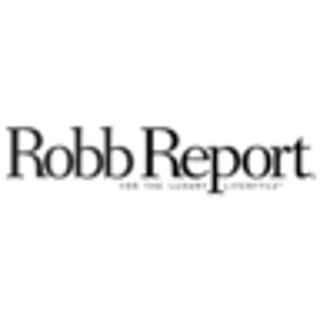
"The Coral Ocean: An Iconic Superyacht Worth Over $100 Million."
CORAL OCEAN is an iconic superyacht that was built by the world’s leading shipyard Lurssen and designed by the godfather of modern superyacht design—Jon Bannenberg.
Forbes, Inside Coral Ocean

READ MORE ABOUT CORAL OCEAN

Coral Ocean is an Award Winning Yacht
Coral Ocean Refit

The Coral Ocean Experience

The 72 Hour Sale of Coral Ocean
Request a quote, make an enquiry.


Coral Ocean
CORAL OCEAN, the 73m superyacht by Lürssen delivers unmatched elegance, class, and sophistication for intimate family charters or cruising with friends.
73m / 240'
From EUR 650,000 to 790,000 /wk
Rate: From EUR 650,000 to 790,000 /wk ----------------------------------------------------- Length: 73m / 240" ----------------------------------------------------- Beam: 13.05m ----------------------------------------------------- Draft: 3.80m ----------------------------------------------------- Built/Refit: 1994 / 2022 ----------------------------------------------------- Builder: Lürssen ----------------------------------------------------- Speeds: Cruising 13 knots ----------------------------------------------------- Crew: 22
CORAL OCEAN accommodates 12 guests + 1 Supernumerary in 7 cabins.
Master Suite: 1 Master (own level, super king bed, his & her ensuites)
VIP Suite: 1 VIP (own level, study & lounge)
Guest Cabins: 4 Super King Rooms (1 room convertible into king singles)
Single Cabin: Suitable for supernumeraries (single bed and ensuite)
- State-of-the-Art beauty amenities for pampering.
- Luxurious designer homewares and amenities.
- 5m opening shell door, creating a balcony over the sea.
- Extensive assortment of toys and entertainment options suitable for all ages.
- 12m Pardo 38 Chase Boat
- 8m Guest RIB
- 6m Watersports RIB
- Jetskiis x2
- Sea Scooters x2
- Flightboard Pro
- Flightboard x2
- Indio Indio Endurance DAB - Surfboard
- Inflatable SUPs - HALA Carbon Stand Up x4
- Hobie Mirage Eclipse Dura x2
- Inflatable/Floaties
- Wakeboarding and Water-ski equipment
- Fishing Gear
- Snorkeling masks and fins

Formerly known as Coral Island, CORAL OCEAN has redefined superyacht design. After undergoing a refit in 2022, it remains at the forefront of setting the benchmark for luxury and sophistication on the water.

In addition to luxurious Master bedroom, VIP suite and 4 guest cabins, CORAL OCEAN also offers a private treatment room for your health and beauty needs.

CORAL OCEAN elevates the charter experience with an array of endless toys and amenities, such as multiple tenders, inflatables, fishing gear, land electric bikes, gym equipment, and much more.
Contact us for information about this boat or the charter process →
Destinations for this yacht

Cote d'Azur

Corsica and Sardina

Balearic Islands
Other vessels like this

© 2023 37South. All right reserved.
CORAL OCEAN
CABINS: 7 | GUESTS: 12 | CREW: 22
Coral Ocean is the iconic 73m (238ft) superyacht charter, built by world’s leading shipyard Lurssen and designed by Jon Bannenberg. Formerly known as Coral Island, this is the yacht that changed the superyachts’ design forever.
The luxurious Coral Ocean superyacht charter has recently completed a remarkable transformation in 2022, sparing no expense and ensuring no detail is left unfinished. Whether you're seeking an intimate family getaway or cruising with a larger group, the Coral Ocean luxury yacht charter promises an unmatched world-class experience of elegance and sophistication on the water.
Experience the enhanced Sundeck of the Coral Ocean mega yacht in Greece, meticulously redesigned to offer an incredibly open and versatile space. Equipped with the latest features, such as surround glass balustrades for unobstructed views, this area boasts a refreshing sun lounge with full umbrella coverage, a redesigned spa pool with a glass bottom for relaxation in style. Moving to the Sky lounge, you'll find a full-service bar, a round dining table suitable for any time of day, an aft balcony with an observation area, indoor and outdoor sound systems, an electric skylight roof, a retractable 85-inch TV, and a unique convertible indoor sunbed with an opening sunroof.
The Owners deck of this luxury yacht charter in Greece & Mediterranean offers a newly built private area with every amenity imaginable. The Master Bedroom features magnificent skylights and panoramic views, along with his and her en-suites, an infrared sauna, hair salon facilities, ample storage space, and a private lounge area. Relax in the treatment room, providing a sanctuary for all your health and beauty needs.
As you unwind in the infrared sauna and indulge in the hair salon, you can further pamper yourself with onboard massages, manicures, pedicures, and facials from experienced beauty therapists. The Upper Deck Dining space, next to the VIP Suite, is a versatile area for hosting events of any size, offering sliding glass protection from the wind for indoor and outdoor experiences. Each guest onboard the Coral Ocean luxury yacht in Greece enjoys private, well-appointed cabins and access to a spa, gym, and a range of water sports equipment for an unforgettable yachting experience.
Featuring exquisite interiors and top-notch facilities, Coral Ocean yacht redefines luxury living at sea. Advanced engineering ensures stability and comfort, with amenities like Wi-Fi connectivity and air conditioning for a seamless experience. Powered by twin Caterpillar engines, Coral Ocean achieves speeds of up to 17 knots with a cruising range of 6,000 nautical miles, offering exceptional performance and efficiency.
To enhance the onboard experience, Coral Ocean superyacht offers a wide array of water toys and accessories, including Flyboards, FunAir waterslides, Jet Skis, towable toys, waterskis, and more. With a dedicated crew of twenty-two, guests are treated to personalized service and unforgettable moments on the Mediterranean waters. Book your charter aboard Coral Ocean for an unparalleled yachting adventure filled with luxury, comfort, and endless entertainment options.
PRESS "Coral Ocean pulling into a port or marina is still an event celebrated by yacht fans the world over." - Andrew Johansson, BOAT international "Coral Ocean had been transformed on similar principles of perfection, oozing luxury and elegance in every way." - Francesca Webster, Superyacht Times "Coral Ocean is one of those names that has a special place in the hearts of superyacht aficionados." - Michael Verdon, Robb Report "Coral Ocean is an iconic superyacht that was built by world's leading shipyard Lürssen and designed by the godfather of modern superyacht design - Jon Bannenberg." - Forbes AWARDS WINNER - 2022 Antigua Yacht Show Chef Competition FINALIST - 2023 BOAT International World Superyacht Awards, Best Refit/Rebuild
view all luxury super yachts for charter
Coral Ocean Yacht Charter Specifications
Length: 73.00 metres (239' 6")
Beam: 13.00 metres (42' 8")
Draft: 3.7 metres (12' 2")
Number of Guests: 12
Number of Crew: 22
Built: 1994
Refit: 2022
Builder: Lurssen
Naval Architect: Jon Bannenberg/H2
Hull Configuration: Displacement
Air conditioning, Approved RYA water sports centre, Deck Jacuzzi, Gym/exercise equipment, Stabilisers at anchor, Stabilisers underway, WiFi connection on board
Accommodation at Coral Ocean Superyacht
Coral Ocean is a 72.55m/238' superyacht available for charter, accommodating up to 13 guests in 7 cabins. Boasting lavish decks, luxurious amenities, and exceptional service, Coral Ocean promises an indulgent experience for all who step aboard. With a range of activities including sauna sessions, spa treatments, pool dips, and gym workouts, guests can enjoy a blend of relaxation and recreation in utmost comfort.
Number of guests: 12
Number of cabins: 7
Cabin configuration: 1 Single Cabins, 5 Double Cabins, 1 Convertible Cabins
Bed configuration: 5 King Beds, 3 Single Beds
Engines: 2 x CATERPILLAR 3516 - controllable pitch propellers 2864 kW
Generators: 4 x CATERPILLAR 3xC9, 1xC7 / 3x215 kW, 1x125 kW
Stabilizers: 2 x QUANTUM QC2200 Hydraulic Zero Speed
Cruising Speed13 knots
Fuel Consumption:400 Litres/Hr
TENDERS & WATER SPORTS
• 12m Pardo 38 Chase Boat
• 8m Guest RIB
• 6m Watersports RIB
• 4.5m Rescue Boat
• 2 x Seabobs
• 2 x Jetskiis
• 2 x Yamaha sea scooters
• 1 x Flightboard Pro
• 2 x Flightboard
• 1 x Indio Indio Endurance DAB - Surfboard
• 1 x Windfoil
• 4 x Tow Lines
• 1 x O'Brien Sombrero (4 Riders)
• 1 x JOBE Chaser (3 Riders)
• 1 x JOBE Storm (2 Riders)
• 1 x JOBE Hotseat (1 Rider)
• 1 x JOBE Shark Trainer (1 Rider)
• 4 x Inflatable SUPs - HALA Carbon Stand Up
• 2 x Hobie Mirage Eclipse Dura
• 4 x Tow Lines with Wakeboarding Handle
• 1 x JOBE CONFLICT 142 & CHARGE
• 1 x JOBE CONFLICT 138 & CHARGE
• 1 x JOBE VANITY 136 SET with Bindings
• 1 x JOBE ACCELERATE Wake Surfer
• 1 x JOBE PACE Wake Surfer
• 1 x JOBE EXCEED Wakeskate
• 1 x JOBE MODE Waterski with Bindings
• 1 x JOBE ALLEGRE Waterski Beginner Set with Bindings
• 1 x JOBE BARON Slalom Waterski
• 1 x JOBE PROPHECY Kneeboard
• 1 x 1 Person Swan
• 1 x 1 Person Unicorn
• 1 x 1 Person Flamingo
• 10 x Noodles
• 4 x Pool Floats for Small Kids to Play in the Pool
• Selection of Balls & Beach Toys; 2 x Football, 2 x Rugby Ball, Frisbee, Beach Bat Set, Spike Ball Set
• FunAir Slide
• SunAir Marine Pool Extension
• 4 x GoCycles (Electric Bikes)
►►Fishing Gear
• 2 x Shimano Tiagra 50LB, Shimano Tiagra Hyper Stand-Up
• 2 x Jigging Set: Shimano Stella 10000, Penn Battalion Jig 1.58m 50
• 1 x PowerPro Depth Hunter 1600mtr 0,36mm
• 1 x Gaf Aftco, Lures, Spare Hooks
►►Additional Equipment
• Impact Vests - Various Sizes
• Wetsuits - Various Sizes
• Masks & Snorkels - Various Sizes
• Snorkel Fins - Various Sizes
• 2 x Sea Scooters
✔ Recently undergone a €35,000,000 rebuild ✔ Award-winning yacht and chef ✔ Extensive toy and entertainment collection or all ages ✔ Onboard spa therapist ✔ 5m opening shell door creating a balcony over the sea ✔ Loyal and experienced crew
UPON REQUEST
Yacht provisioning Helicopter/airplane charter Concierge services Private chef Luxury cars & transfers
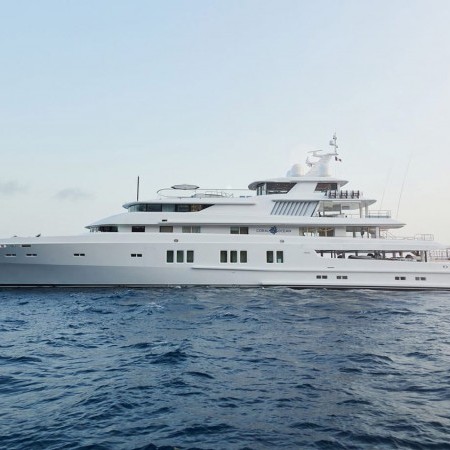
- Environment
Coral Reefs Are Getting Sick, and This Human Medicine Might Help
Antibiotics, it turns out, are a useful tool for keeping caribbean ecosystems alive., benji jones.
- Share on Facebook
- Share on Twitter

Stony coral tissue loss disease is destroying reefs. P. Sutter/DPA/ZUMA
This story was originally published by Vox.com and is reproduced here as part of the Climate Desk collaboration .
Several meters underwater off the coast of Bonaire, a small island in the south Caribbean, Danielle de Kool floated in place in front of a large head of boulder brain coral. The pattern across its surface looked like the maze you might find on the back of a cereal box.
From a plastic syringe, de Kool, an ecologist at a local environmental group, squeezed a toothpaste-like substance into her hand. She then pressed the paste onto the surface of the coral around the edge of a large white splotch that had recently appeared.
The coral was sick. And this paste might help heal it.
In the last decade, a mysterious illness called stony coral tissue loss disease has been ravaging coral in reefs across the Caribbean. The disease—which is likely caused by a bacterium or virus—targets a number of hard, reef-forming coral species. It essentially pulverizes the soft coral tissue, killing centuries-old colonies in a matter of weeks.
The outbreak is quite literally threatening Bonaire’s way of life, the primary source of income for its residents.
The plight has now spread to at least 30 countries and territories in the Caribbean, where corals were already suffering from pollution, climate change, and other threats. In regions hit by SCTLD, the disease has reduced the area of coral by anywhere from 30 percent to 60 percent .
Researchers say that SCTLD is now likely the worst coral disease outbreak ever recorded.
Last spring, the disease was spotted in Bonaire—one of the few spots in the Caribbean where you can still find an abundance of healthy coral . The island, like many others in the tropics, is deeply dependent on its reef. Tourism is the engine of Bonaire’s economy, and the majority of visitors come to scuba dive and snorkel. Plus, large coral structures dampen waves that hit the shore, lessening flooding during big storms.
SCTLD has already killed off more than 90 percent of some coral species in Bonaire, including boulder brain and maze corals, according to preliminary data from STINAPA, a local organization working to protect the reef. The outbreak is quite literally threatening Bonaire’s way of life, the primary source of income for its residents, and the island’s ability to defend itself from destructive hurricanes.
With the stakes so high, ecologists across the Caribbean are trying desperately to ease the spread of SCTLD. And on that morning in July, de Kool, who works for STINAPA, was doing one of the few things that seems to work: smearing sick corals with antibiotics.
Each bit of coral is a colony of animals, comprising hundreds to thousands of tiny creatures called polyps. Those polyps produce skeletons made of calcium carbonate—the same material found in sea shells—which forms the hard structure of the reef.
And like other animals, corals can get sick. Over the last century, a number of diseases have decimated coral populations worldwide. White band disease, for example, first appeared in the 1970s and has since killed more than 80 percent of staghorn and elkhorn corals in the Caribbean. These iconic species, named for their antler-like appearance, were once so abundant in the shallows that fishermen would have to cut them down in order to clear a path for their boats.
“I’ve never seen a disease like this…” In Bonaire, it’s something close to an “extinction-level event.”
SCTLD, meanwhile, is relatively new. Scientists first observed the disease a decade ago in Florida, and there are still many unknowns, such as where it first came from and even what SCTLD is. It could be a bacterium or a virus, or both working together. Some kinds of bacteria, for example, could be making coral more susceptible to a virus, said Blake Ushijima, a microbiologist at the University of North Carolina Wilmington.
Scientists also aren’t sure how SCTLD has moved around the Caribbean. The spread generally seems to follow ocean currents, but it sometimes jumps between distant places, said Marilyn Brandt, a coral scientist at the University of the Virgin Islands. In some cases, cargo ships are likely responsible for the spread, she said. As ships load and unload cargo, they fill and empty ballast tanks that help stabilize the vessels. These tanks could be inadvertently transporting SCTLD-causing pathogens. (There are now regulations and technologies designed to minimize the spread of disease and invasive species in ballast water, though not all ships adhere to them, Brandt said.)
On that morning in July, I was diving with de Kool on a reef just off the northwest coast of Bonaire. The view underwater was stunning: a messy tapestry of colorful corals and sea sponges home to all kinds of sea creatures. About 20 minutes into our dive, a hammerhead shark swam by.
Yet there were also signs of SCTLD everywhere.
Reefs get their signature bright coloring from a symbiotic algae that lives inside the live coral tissue. The sickened colonies, though, had big white spots where the disease had apparently destroyed the tissue, exposing the coral’s bone-white skeleton. Many of those spots were already turning green from different kinds of algae that grow on dead sections of coral.
“I’ve never seen a disease like this,” Caren Eckrich, an ecologist at STINAPA, told me. In Bonaire, it’s something close to an “extinction-level event,” she said, meaning it’s nearly wiping out some of the island’s coral species.
But scientists are not totally powerless against it. They have a weapon.
For years now, companies and hobbyists who grow coral in aquariums have used various antibiotics to treat sick sea creatures, including coral, Ushijima told me. They essentially dip pieces of coral into antibiotic washes or put medicine directly into the fish tanks.
When SCTLD began spreading several years ago, scientists tried a similar approach—and it worked. They brought sick corals infected with SCTLD into the lab and treated them with antibiotics, including amoxicillin, the same drug humans use for bacterial infections. Most of them recovered.
“It seems very likely that the bacterial component is at least very important in the infection process.”
Treating corals in the wild, however, is a different challenge altogether. That’s where that toothpaste-like substance de Kool was using comes in. Through trial and error, scientists figured out that they could mix powdered amoxicillin with a biodegradable putty, made by the company Ocean Alchemists , that sticks to the surface of coral underwater. When you apply the antibiotic paste around a SCTLD lesion, it can, as studies have shown , stop or slow the disease from spreading through the colony. “It is very effective,” Brandt said.
That amoxicillin works is actually a bit peculiar. While it’s still not clear what pathogen causes SCTLD, there’s some evidence suggesting the disease is viral, Brandt said. How would amoxicillin, which kills bacteria, stop a viral disease? One theory, she said, is that if it is indeed viral, the pathogen may still require bacteria to cause disease. (In humans, bacteria and viruses sometimes cooperate with each other .) Another possible explanation, she said, is that the pathogen targets the symbiotic algae living within coral tissue. Antibiotics often kill those algae without killing the coral, essentially removing the target of infection and stemming the spread. Or perhaps SCTLD is caused by bacteria after all, as other scientists suspect. No one knows for sure.
“It seems very likely that the bacterial component is at least very important in the infection process,” said Karen Neely, a research scientist at Florida’s Nova Southeastern University who first trialed the antibiotic paste in the wild. “But regardless, the amoxicillin does work. It’s keeping corals alive.”
Back on the reef, I watched de Kool and a handful of other divers, including dive instructor and educator Carmen Toanchina, cruise around the reef and treat corals. They’d spot a colony with white lesions, unclip a syringe from their vest, squirt out some paste, and then, somewhat awkwardly, try to apply it to the coral’s surface. It was like watching someone stick strips of Play-Doh on weird-looking rocks but underwater—where masks fog up, sharks swim by, and one deep breath threatens your buoyancy. The work was slow going.
These treatments appear to be working, said Jeannine Toy, who oversees a squadron of STINAPA volunteers like Toanchina who apply the antibiotics. They’ve been treating reefs in Bonaire for more than a year now. “About 70 percent are healed after we treat them,” Toy told me after the dive.
The goal isn’t to treat every coral around the island, Toy said—that’d be nearly impossible. Rather, STINAPA wants to treat enough colonies so that there are plenty of live corals to spawn, or sexually reproduce, and create the next generation of corals in Bonaire.
The bad news is that SCTLD is unlikely to disappear anytime soon. It’s now endemic, or consistently present, in some regions, like Florida and the US Virgin Islands. Scientists also fear that it will soon spread to the Pacific, home to the Great Barrier Reef and, in general, a much higher diversity of corals. It’s not clear how susceptible Pacific corals will be. “The scary part is that we don’t know,” Ushijima said.
Against the enormity of the ongoing outbreak, antibiotics are sorely inadequate. While amoxicillin can stem the growth of lesions, it doesn’t prevent infection. And applying the paste is incredibly labor intensive, Brandt said. “It requires tons of divers,” she said. “I have four people and that’s all they do.”
Some scientists, including Ushijima, are also concerned that the bacteria it kills might eventually develop a resistance to amoxicillin, making the treatment less useful. (So far there are no signs of antibiotic resistance, Neely says.)
Reefs that are already weakened by extreme heat or pollution are more likely to get sick, just as it’s easier to catch a cold when you’re stressed.
For now, Brandt points out, giving sick corals antibiotics is the best option available. “It was the only effective solution that we were able to deploy in a large way,” she said, referring to her conservation work in the US Virgin Islands. Her team, she said, “has saved quite a lot of coral.”
Meanwhile, scientists like Ushijima are also working on other potential treatments, such as coral probiotics. Some corals appear to be naturally resistant to SCTLD; the microbes found in and around them may have something to do with this resistance. Certain kinds of bacteria, for example, help corals fight off disease, Ushijima said. Biologists are trying to identify those defense microbes so they can inoculate wild coral with them.
This approach points to something hopeful: Some corals are doing just fine.
Again, this could have to do with those microbes or with genetics; resistance to disease can be rooted in coral DNA. But it also has to do with the environment, Brandt said, and the other threats corals are exposed to. Reefs that are already weakened by extreme heat or pollution are more likely to get sick, just as it’s easier to catch a cold when you’re stressed. What’s more, Brandt said, is that reducing local sources of stress gives corals a better chance of growing back after they suffer a loss from SCTLD.
If any reef can survive the impacts of SCTLD, it’s Bonaire. The island has protected its reef from threats like overfishing for more than half a century, longer than pretty much any other region worldwide. And the corals here have demonstrated that they can bounce back from major die-offs, as I recently reported .
As de Kool and I cruised around the reef, she wasn’t only treating sick corals but also monitoring colonies that have so far resisted infection. There were a lot of them, including big heads of brain coral and even some pillar corals, which have been hit especially hard by SCTLD in the Caribbean. Perhaps these colonies are resistant to the disease. Perhaps they will seed the next generation of corals around the island, helping this once-vibrant reef recover.
If not, doctors are standing by with medicine.
“I spent a good part of my career monitoring corals to death,” Neely told me. “We can’t do that anymore. We have to be active. We are part of the reason that reefs are dying and to not do something about it is really just unacceptable at this point.”
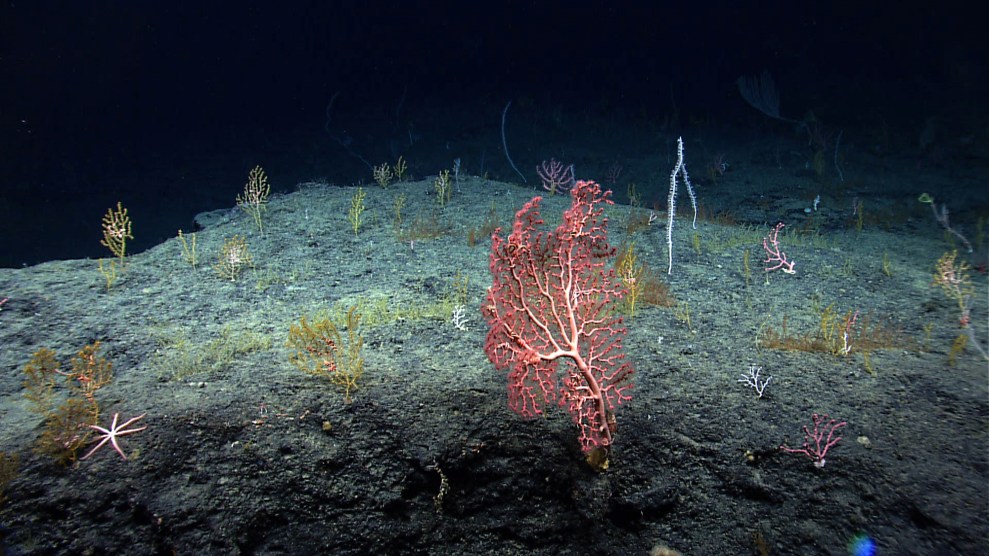
One of the World’s Healthiest Coral Reefs Is Hiding in a Gulf Coast Oilfield
Jesse Nichols

These Scientists Tried a Coral-Breeding Moonshot—and It Worked

Fish Species Communicate With One Another in Coral Reefs. Can They Save These Threatened Ecosystems?

That Time a California Lawmaker Tried Getting Rid of Gas-Powered Vehicles
Scott W. Stern
We Recommend

How Elon Musk Is Tying His Love for Trump to His Fight in Brazil
Anna Merlan

“Our Job Is to Make Sure They’re Safe”: America Confronts Election Intimidation
Peggy Dodd, Pierce Gentry, Shelby Rickert, and Olivia Talkington

JD Vance Has Yet Another Connection to Project 2025
Julianne McShane

John McCain’s Son Puts Trump on Blast for Cemetery Stunt

Derision and Danger: The Democrats Figure Out How to Attack Trump

Trump Is Threatening to Jail Political Enemies. He’s Not Alone.
Jeremy Schulman

Months Before It Happened, Hersh Goldberg-Polin’s Mother Was Haunted by His Death
Jackie Flynn Mogensen

US Squandering Billions on Unproven Climate Solutions, Critics Say
Nina Lakhani
Sign up for our free newsletter
Subscribe to the Mother Jones Daily to have our top stories delivered directly to your inbox.
By signing up, you agree to our privacy policy and terms of use , and to receive messages from Mother Jones and our partners.
Get our award-winning magazine
Save big on a full year of investigations, ideas, and insights.
Support our journalism
Help Mother Jones ' reporters dig deep with a tax-deductible donation.
Independent. In print. In your mailbox.
Inexpensive, too! Subscribe today and get a full year of Mother Jones for just $19.95.

Bold. Brave. Beautiful.
Award-winning photojournalism. Stunning video. Fearless conversations.
Looking for news you can trust?
We noticed you have an ad blocker on..
Can you pitch in a few bucks to help fund Mother Jones' investigative journalism? We're a nonprofit (so it's tax-deductible), and reader support makes up about two-thirds of our budget.
We noticed you have an ad blocker on. Can you pitch in a few bucks to help fund Mother Jones' investigative journalism?
Don't let an algorithm decide what news you see.
Sign up for the free Mother Jones Daily newsletter and follow the news that matters.
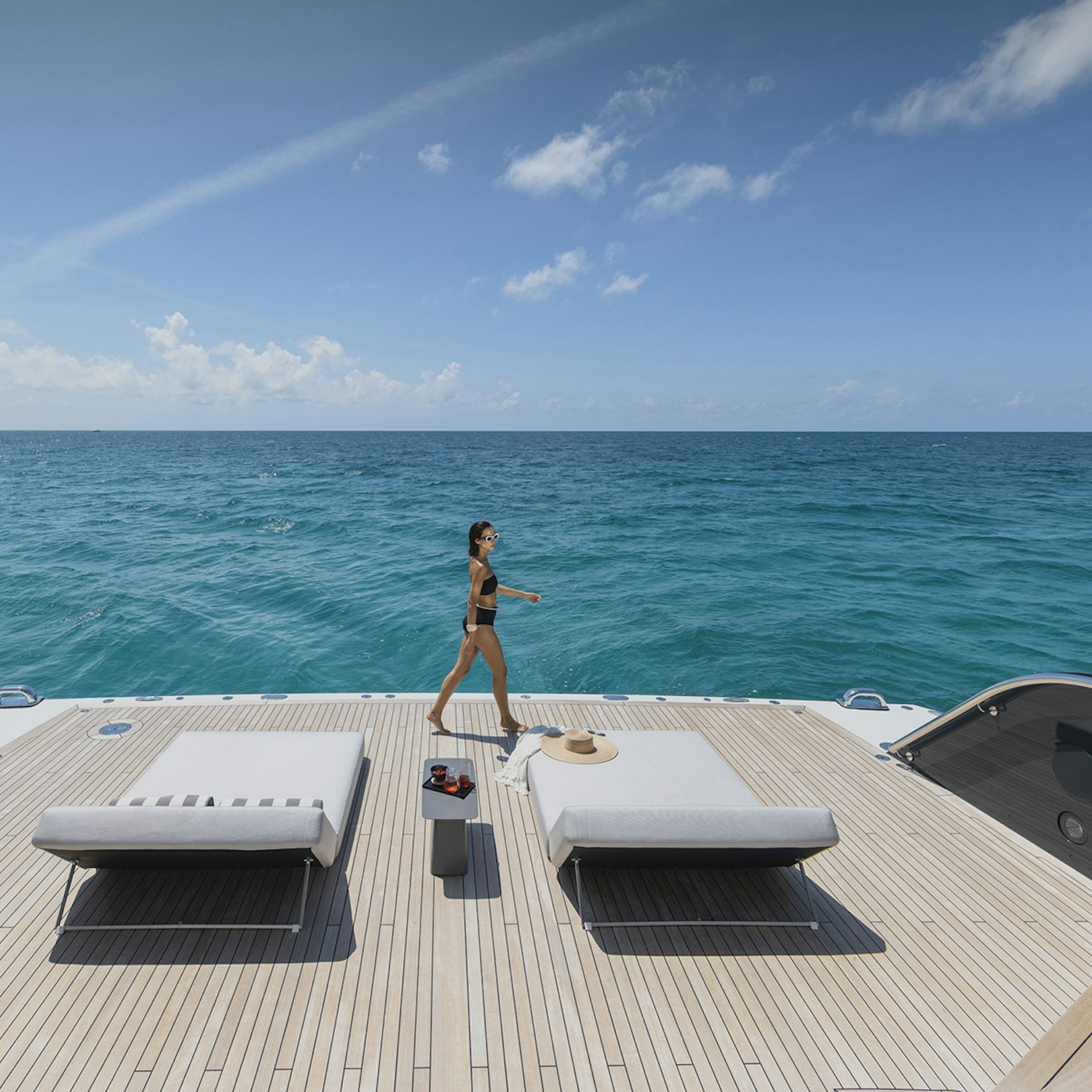
Superyacht Sales, Charter, Construction & Management
Yacht Sales, Charter, and Construction Experts
Moran Yacht & Ship is proud to be considered one of the world’s best yacht companies; a leader in luxury yacht sales, construction, charter, and management. Whether you are interested in buying a yacht , selling your yacht , luxury yacht charter , or new yacht construction , our super yacht brokers and yacht managers are here to assist. Family-owned and operated, our luxury yacht brokerage has been the preferred choice for yacht buyers, sellers, and charterers for over three decades.
Featured Yachts For Sale
Interested in buying? Moran is proud to have the most impressive fleet of all the world’s brokerage companies. With over three decades of experience in yacht sales and purchase, along with countless time spent at sea, our knowledgeable luxury yacht brokers will guide you through the process of purchasing or selling a yacht. Learn more about our featured luxury yachts for sale here.
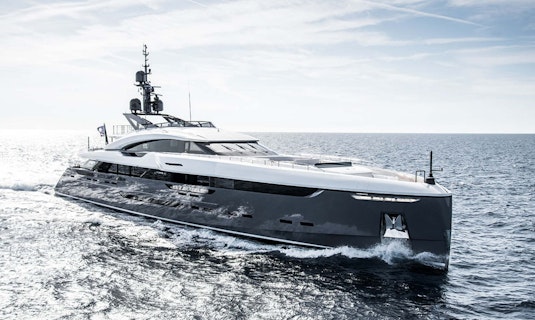
Our Approach
Our experience is what sets us apart from other yacht companies. The Moran team is made up of marine industry experts, including veteran Captains and engineers, meaning that we are uniquely positioned to provide world-class superyacht services. Our team’s wealth of luxury yacht knowledge is what first draws people to us, while our straightforward approach is what keeps clients coming back time and time again. We Do What We Say, honoring our promises and commitments to clients and fellow brokers above all else. By providing honest, specialist, yet unbiased advice to everyone who passes through our door, we maintain an extraordinarily high rate of repeat business.
Featured Yachts For Charter
Want to charter or know more about how to charter a yacht ? Moran Yacht & Ship is considered one of the very best yacht companies in the world for luxury yacht charter , with an expert team who will always go the extra mile to provide you with the right itinerary, vessel, and superyacht crew . Learn more about our featured luxury yachts for charter here.

LADY KATHRYN V
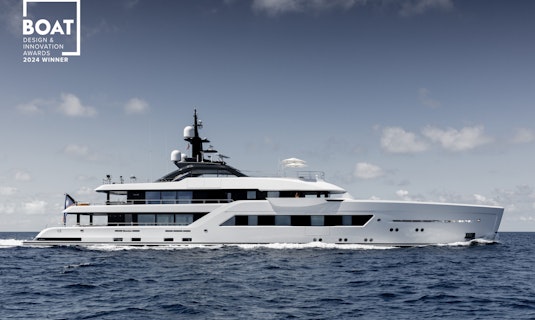
Integrity and the relentless pursuit of the deal defines Moran Yacht & Ship - I am grateful that you were on this journey with me. This magical machine KISMET is the second yacht I’ve had built with Moran Yacht & Ship. KISMET has brought joy, hope, and the gift of discovery to many lives - including my own. You have made this world a better place! Owner, KISMET
By way of background, my business interests include controlling stakes in 3 publicly traded companies which operate vessels in the 500 to 5000dwt range. On average, one new vessel a year would be added to the fleet. As a result, I have access to in-house marine architects, engineers and construction supervisors. Consequently, when I decided to build my first large motor yacht, I did not feel I needed the services of a company like Moran Yacht & Ship. In any event, I was persuaded to let them negotiate on my behalf while I simultaneously held discussions with other building options. Moran Yacht & Ship understands yachts, their incredibly complex systems, and what constitutes a practical solution to various owners’ ideas. In short, I would not consider building another yacht without engaging Moran Yacht & Ship to provide the services they are so good in delivering. Former Owner, NORTHERN STAR
Latest Yachting News
Want to find out what we’ve been up to? View our latest yachting news, including recent yacht sales, price reductions, and completed custom yachts . Offering a full selection of yachting services, the Moran Yacht & Ship team is always busy working on our next big project. Discover our latest updates here.

Sailing Sardinia & Corsica in Style

15% Discount on New England Charters Aboard UTOPIA IV

Dining Michelin-Style in the Mediterranean Part 2

The global authority in superyachting
- NEWSLETTERS
- Yachts Home
- The Superyacht Directory
- Yacht Reports
- Brokerage News
- The largest yachts in the world
- The Register
- Yacht Advice
- Yacht Design
- 12m to 24m yachts
- Monaco Yacht Show
- Builder Directory
- Designer Directory
- Interior Design Directory
- Naval Architect Directory
- Yachts for sale home
- Motor yachts
- Sailing yachts
- Explorer yachts
- Classic yachts
- Sale Broker Directory
- Charter Home
- Yachts for Charter
- Charter Destinations
- Charter Broker Directory
- Destinations Home
- Mediterranean
- South Pacific
- Rest of the World
- Boat Life Home
- Owners' Experiences
- Conservation and Philanthropy
- Interiors Suppliers
- Owners' Club
- Captains' Club
- BOAT Showcase
- Boat Presents
- Events Home
- World Superyacht Awards
- Superyacht Design Festival
- Design and Innovation Awards
- Young Designer of the Year Award
- Artistry and Craft Awards
- Explorer Yachts Summit
- Ocean Talks
- The Ocean Awards
- BOAT Connect
- Between the bays
- Golf Invitational
- BOATPro Home
- Superyacht Insight
- Global Order Book
- Premium Content
- Product Features
- Testimonials
- Pricing Plan
- Tenders & Equipment

The rising interior design firm behind some of latest eco-friendly superyacht refits
When turning superyacht dreams into reality, finding the right yacht designer is crucial. US-based Verge Yacht Design , founded in 2021 by principal interior designer Anita Rivera Turcotte, has quickly proven itself as a leader in the industry despite its relatively young age. The firm has already worked on an impressive array of projects, collaborating with renowned shipyards such as Feadship , Amels and Heesen , among others. Currently working on two new builds and two refits, with three additional refits scheduled for 2024-2025, Verge Yacht Design specialises in full-service superyacht interiors and personalised furnishings, all while being committed to using environmentally conscious materials in its work.
Bespoke superyacht interiors
At Verge Yacht Design, innovation is at the heart of every project. The firm collaborates closely with yacht owners and crew to create stylish and functional spaces that cater to the client’s lifestyle and taste. Verge is known for pushing the boundaries of traditional yacht design, offering creative and customised solutions that are truly one-of-a-kind. A hallmark of Verge’s approach is the incorporation of biomimicry, drawing inspiration from nature to enhance the design.
A prime example of Verge’s expertise is on board the 54.3-metre, Amels-built Revelry , which underwent an extensive eight-month refit at Thunderbolt Marine from May to December 2022. Verge Yacht Design led the complete interior transformation, which included bespoke furnishings, reupholstery, curated artwork, custom Roman sheers and blackout window shades, custom lighting and technical upgrades. The sundeck was also reimagined with an LED-backlit quartz bar top, bespoke seating, spatial reconfiguration, custom barware and a soft refit of the bridge deck and crew areas.
“Anita and the Verge team channelled their many high-end talents to produce a refitted interior beyond our owner’s dreams,” praises the captain. “From design to fit, Verge paired yacht practicality and sustainability into their aesthetic design. As with all projects, when challenges present themselves, it’s the commitment that excels a team to the finish line.”
Service that goes beyond design
Verge Yacht Design has significantly expanded its scope beyond yacht interiors to offer a full suite of services, including project management, furniture design and product engineering. The firm oversees every aspect of a project, from the initial design phase to final implementation, ensuring smooth execution through a trusted network of collaborators and vendors.
The studio’s designs are distinguished by their engineering precision. To bolster this technical expertise, Verge has been collaborating with renowned naval architect Nick Eremic on structural engineering. Eremic’s knowledge in engineering and construction ensures that superyacht concepts are both realistic and functional, while also facilitating an organised process for contractors during the build phase.
Eremic will be joining the Verge Yacht Design team on a full-time basis in September 2024. His expertise will enhance the firm’s capabilities, allowing them to offer 3D models and renderings, engineering drawings comprehensive project management services.
Leading the way in eco-friendly yacht design
Committed to staying at the forefront of eco-friendly innovation, Verge Yacht Design strives to integrate technologies and practices that minimise environmental impact into every aspect of its designs. The firm actively sources materials that reduce weight to lower emissions, as well as carbon-neutral decking and upcycled components.
A key focus for Verge is understanding the origins and production processes of the materials it uses to ensure they are environmentally certified. By selecting marine-grade materials that are reusable and biodegradable, particularly for closed-loop systems, Verge minimises environmental impact while adhering to the highest standards of sustainability.
Verge also prioritises the full lifecycle of each material, carefully evaluating its impact on the marine environment. This involves assessing energy consumption, waste production and the potential for recycling and reuse. Looking to the future, Verge considers the long-term impacts of its material choices, emphasising biodegradability, recyclability and positive end-of-life outcomes. But sustainability in yacht design at Verge extends beyond material selection. The firm also focuses on reducing its carbon footprint throughout the entire logistics and procurement process. This includes maintaining transparency in the supply chain, consolidating shipments, optimising routes, partnering with green carriers, and sourcing locally whenever possible.
Verge Yacht Design is currently developing a yacht-specific furniture line in collaboration with a luxury brand, as well as a marine fabric line, both set to launch in 2026. These exciting ventures position Verge as a brand to watch in the world of superyacht design.
Contact the team at Verge Yacht Design to bring your superyacht design vision to life.
Sponsored content created for Verge Yacht Design
Sunrise Yachts Sponsor 2011 Moscow International Boat Show (MIBS)
- Inspiration
Related News
Popular news this week, popular news this month, latest news.
- Yacht Charter & Superyacht News >
Written by Mike Smith
Sunrise Yachts, a luxury yacht building company which is based in Turkey, has been made a main sponsor of next year’s 2011 Moscow International Boat Show (MIBS). The four-day Russian yacht show event is currently scheduled to run from April 14-17 at the Moscow’s Crocus exhibition centre.

moscow boat show
MIBS is organised by the ITE Group and it is one of Russia’s leading boat shows and is an internationally recognised superyacht event. The show covering everything from small parts and accessories to large superyacht with over 9,000 people and 178 exhibitors attended the last year show.
The Paolo Scanu-designed Sunrise 45 yacht is an ocean-going cruising yacht that was released in 2009 to much acclaim at this was the group’s first-ever model.
Sunrise Yachts was founded in 2007 by the German entrepreneur Herbert P Baum along with the French-British yacht builder Guillaume Roché. The luxury yacht group is based in Antalya, Turkey and utilises a 10,000sq m shipyard facility. Sunrise has two sheds measuring 100m (328ft) x 16m (53ft), as well as a 70m (230ft) x 16m (53ft) fully acclimatized paint shed that can accommodate new-build and refit projects up to 65m (213ft) in length and 1,200 tonnes displacement.

The sunrise 45m superyacht by Sunrise Yachts
Along each side of the yacht-building facility, space is available for long-term sub-contractors with the latest equipment and logistics capabilities, along with air-conditioned storage, ventilation and extraction plants. The shipyard is organized as an “assembler,” based loosely on the car industry’s model, with a small, yet powerful project management team charged with running all the in-house long-term sub-contractors.
Please contact CharterWorld - the luxury yacht charter specialist - for more on superyacht news item "Sunrise Yachts Sponsor 2011 Moscow International Boat Show (MIBS)".
- Charity & Fund Raising
- CharterWorld News
- Classic Yachts
- Coronavirus
- Cruise Ship
- Ecological Yachts
- Expedition Yachts
- Expert Broker Advice
- Feature Superyachts
- Interior Design
- Legal & VAT Yacht Issues
- Luxury Catamarans
- Luxury Gulet
- Luxury Phinisi
- Luxury Trimarans
- Luxury Yacht Design
- Luxury Yachts
- Marinas & Harbours
- Marine Ecology
- Marine Electronics
- Marine Equipment
- Mega Yachts
- Modern Yachts
- Motor Yachts
- New Launch Yachts
- New To Charter
- Open Style Sports Yachts
- Private Jets
- Sailing Yachts
- Social Media
- Sports Yachts
- Superyacht Crew
- Superyacht Photographers
- Superyacht Products & Supplies
- Superyacht Refits
- Superyacht Reviews
- Superyachts
- Uncategorized
- Yacht Builders
- Yacht Charter
- Yacht Charter Destinations
- Yacht Charter Picks
- Yacht Charter Specials
- Yacht Delivered to Owner
- Yacht Designers
- Yacht Events & Boat Shows
- Yacht Fashion
- Yacht Industry News
- Yacht Photos
- Yacht Racing
- Yacht Racing & Regattas
- Yacht Safety Equipment
- Yacht Support Vessels
- Yacht Tenders
- Yacht Videos
- Yachting Associations
- Yachting Awards
- Yachting Business
- Yachts For Charter
- Yachts For Sale
Quick Enquiry
Superyacht news:.
Email Your Yachting News to: news @ charterworld.com
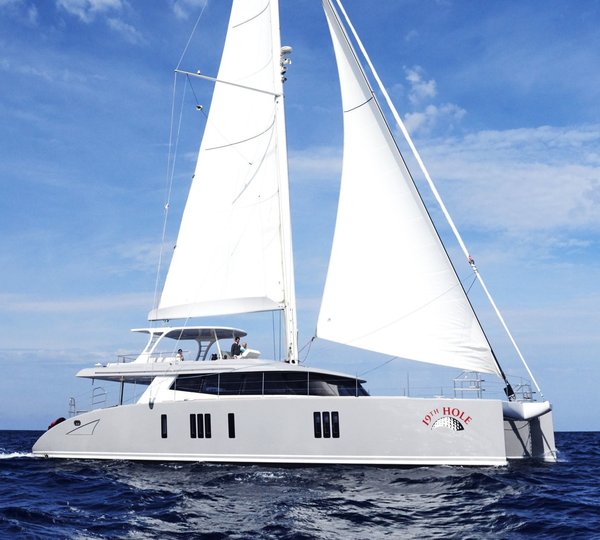
Sunrise Yachts

63M CUSTOM SUPERYACHT

Recently delivered 63m Sunrise Super Yacht IRIMARI to make world premiere at MYS 2015
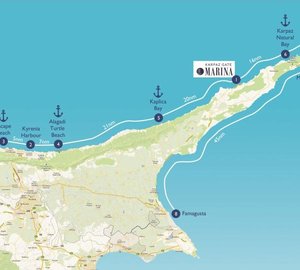
New Savings and Benefits for Russian Yacht Owners in 2014 announced by Karpaz Gate Marina

5th Moscow Boat Show, March 20-25, 2012

5th International exhibition of boats and yachts Moscow Boat Show a Huge Success

Van der Valk Shipyard announce 35m explorer yacht SAMBA
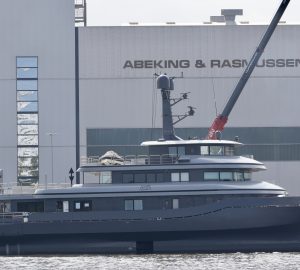
Abeking & Rasmussen’s 41-meter superyacht NURJA relaunched after refit

Aegean Yachts unveil 26m explorer yacht HEKATE

Late summer special offer on board 72m superyacht ARBEMA in the Western Mediterranean

The International SeaKeepers Society will host its 2024 annual Founders Event in October

OCEA delivers 33m motor yacht ARAOK II to her new owner

39m sailing yacht LINNEA AURORA launched by SES Yachts

A luxury charter yacht is the perfect way to encounter New England’s fall foliage display

A first look at 55m superyacht PROJECT AGNETHA from Heesen Yachts

Charter yachts offering citizen science opportunities around the world

44m superyacht ORION ONE reaches a construction milestone

44m charter yacht JEMS offers 9 days for the price of 7 in August in Italy

37m luxury explorer yacht OCULUS brand new to the charter market on both sides of the Atlantic
what is research question and examples
Have a language expert improve your writing.
Run a free plagiarism check in 10 minutes, generate accurate citations for free.
- Knowledge Base
- Starting the research process
- Writing Strong Research Questions | Criteria & Examples
Writing Strong Research Questions | Criteria & Examples
Published on October 26, 2022 by Shona McCombes . Revised on November 21, 2023.
A research question pinpoints exactly what you want to find out in your work. A good research question is essential to guide your research paper , dissertation , or thesis .
All research questions should be:
- Focused on a single problem or issue
- Researchable using primary and/or secondary sources
- Feasible to answer within the timeframe and practical constraints
- Specific enough to answer thoroughly
- Complex enough to develop the answer over the space of a paper or thesis
- Relevant to your field of study and/or society more broadly

Table of contents
How to write a research question, what makes a strong research question, using sub-questions to strengthen your main research question, research questions quiz, other interesting articles, frequently asked questions about research questions.
You can follow these steps to develop a strong research question:
- Choose your topic
- Do some preliminary reading about the current state of the field
- Narrow your focus to a specific niche
- Identify the research problem that you will address
The way you frame your question depends on what your research aims to achieve. The table below shows some examples of how you might formulate questions for different purposes.
| Research question formulations | |
|---|---|
| Describing and exploring | |
| Explaining and testing | |
| Evaluating and acting | is X |
Using your research problem to develop your research question
| Example research problem | Example research question(s) |
|---|---|
| Teachers at the school do not have the skills to recognize or properly guide gifted children in the classroom. | What practical techniques can teachers use to better identify and guide gifted children? |
| Young people increasingly engage in the “gig economy,” rather than traditional full-time employment. However, it is unclear why they choose to do so. | What are the main factors influencing young people’s decisions to engage in the gig economy? |
Note that while most research questions can be answered with various types of research , the way you frame your question should help determine your choices.
Receive feedback on language, structure, and formatting
Professional editors proofread and edit your paper by focusing on:
- Academic style
- Vague sentences
- Style consistency
See an example

Research questions anchor your whole project, so it’s important to spend some time refining them. The criteria below can help you evaluate the strength of your research question.
Focused and researchable
| Criteria | Explanation |
|---|---|
| Focused on a single topic | Your central research question should work together with your research problem to keep your work focused. If you have multiple questions, they should all clearly tie back to your central aim. |
| Answerable using | Your question must be answerable using and/or , or by reading scholarly sources on the to develop your argument. If such data is impossible to access, you likely need to rethink your question. |
| Not based on value judgements | Avoid subjective words like , , and . These do not give clear criteria for answering the question. |
Feasible and specific
| Criteria | Explanation |
|---|---|
| Answerable within practical constraints | Make sure you have enough time and resources to do all research required to answer your question. If it seems you will not be able to gain access to the data you need, consider narrowing down your question to be more specific. |
| Uses specific, well-defined concepts | All the terms you use in the research question should have clear meanings. Avoid vague language, jargon, and too-broad ideas. |
| Does not demand a conclusive solution, policy, or course of action | Research is about informing, not instructing. Even if your project is focused on a practical problem, it should aim to improve understanding rather than demand a ready-made solution. If ready-made solutions are necessary, consider conducting instead. Action research is a research method that aims to simultaneously investigate an issue as it is solved. In other words, as its name suggests, action research conducts research and takes action at the same time. |
Complex and arguable
| Criteria | Explanation |
|---|---|
| Cannot be answered with or | Closed-ended, / questions are too simple to work as good research questions—they don’t provide enough for robust investigation and discussion. |
| Cannot be answered with easily-found facts | If you can answer the question through a single Google search, book, or article, it is probably not complex enough. A good research question requires original data, synthesis of multiple sources, and original interpretation and argumentation prior to providing an answer. |
Relevant and original
| Criteria | Explanation |
|---|---|
| Addresses a relevant problem | Your research question should be developed based on initial reading around your . It should focus on addressing a problem or gap in the existing knowledge in your field or discipline. |
| Contributes to a timely social or academic debate | The question should aim to contribute to an existing and current debate in your field or in society at large. It should produce knowledge that future researchers or practitioners can later build on. |
| Has not already been answered | You don’t have to ask something that nobody has ever thought of before, but your question should have some aspect of originality. For example, you can focus on a specific location, or explore a new angle. |
Chances are that your main research question likely can’t be answered all at once. That’s why sub-questions are important: they allow you to answer your main question in a step-by-step manner.
Good sub-questions should be:
- Less complex than the main question
- Focused only on 1 type of research
- Presented in a logical order
Here are a few examples of descriptive and framing questions:
- Descriptive: According to current government arguments, how should a European bank tax be implemented?
- Descriptive: Which countries have a bank tax/levy on financial transactions?
- Framing: How should a bank tax/levy on financial transactions look at a European level?
Keep in mind that sub-questions are by no means mandatory. They should only be asked if you need the findings to answer your main question. If your main question is simple enough to stand on its own, it’s okay to skip the sub-question part. As a rule of thumb, the more complex your subject, the more sub-questions you’ll need.
Try to limit yourself to 4 or 5 sub-questions, maximum. If you feel you need more than this, it may be indication that your main research question is not sufficiently specific. In this case, it’s is better to revisit your problem statement and try to tighten your main question up.
Prevent plagiarism. Run a free check.
If you want to know more about the research process , methodology , research bias , or statistics , make sure to check out some of our other articles with explanations and examples.
- Methodology
- Sampling methods
- Simple random sampling
- Stratified sampling
- Cluster sampling
- Likert scales
- Reproducibility
Statistics
- Null hypothesis
- Statistical power
- Probability distribution
- Effect size
- Poisson distribution
Research bias
- Optimism bias
- Cognitive bias
- Implicit bias
- Hawthorne effect
- Anchoring bias
- Explicit bias
The way you present your research problem in your introduction varies depending on the nature of your research paper . A research paper that presents a sustained argument will usually encapsulate this argument in a thesis statement .
A research paper designed to present the results of empirical research tends to present a research question that it seeks to answer. It may also include a hypothesis —a prediction that will be confirmed or disproved by your research.
As you cannot possibly read every source related to your topic, it’s important to evaluate sources to assess their relevance. Use preliminary evaluation to determine whether a source is worth examining in more depth.
This involves:
- Reading abstracts , prefaces, introductions , and conclusions
- Looking at the table of contents to determine the scope of the work
- Consulting the index for key terms or the names of important scholars
A research hypothesis is your proposed answer to your research question. The research hypothesis usually includes an explanation (“ x affects y because …”).
A statistical hypothesis, on the other hand, is a mathematical statement about a population parameter. Statistical hypotheses always come in pairs: the null and alternative hypotheses . In a well-designed study , the statistical hypotheses correspond logically to the research hypothesis.

Formulating a main research question can be a difficult task. Overall, your question should contribute to solving the problem that you have defined in your problem statement .
However, it should also fulfill criteria in three main areas:
- Researchability
- Feasibility and specificity
- Relevance and originality
Cite this Scribbr article
If you want to cite this source, you can copy and paste the citation or click the “Cite this Scribbr article” button to automatically add the citation to our free Citation Generator.
McCombes, S. (2023, November 21). Writing Strong Research Questions | Criteria & Examples. Scribbr. Retrieved July 22, 2024, from https://www.scribbr.com/research-process/research-questions/
Is this article helpful?
Shona McCombes
Other students also liked, how to define a research problem | ideas & examples, how to write a problem statement | guide & examples, 10 research question examples to guide your research project, get unlimited documents corrected.
✔ Free APA citation check included ✔ Unlimited document corrections ✔ Specialized in correcting academic texts
- Examples of good research questions
Last updated
Reviewed by
Tanya Williams
However, developing a good research question is often challenging. But, doing appropriate data analysis or drawing meaningful conclusions from your investigation with a well-defined question make it easier.
So, to get you on the right track, let’s start by defining a research question, what types of research questions are common, and the steps to drafting an excellent research question.
Make research less tedious
Dovetail streamlines research to help you uncover and share actionable insights
What is a research question?
The definition of a research question might seem fairly obvious.
At its simplest, a research question is a question you research to find the answer.
Researchers typically start with a problem or an issue and seek to understand why it has occurred, how it can be solved, or other aspects of its nature.
As you'll see, researchers typically start with a broad question that becomes narrower and more specific as the research stages are completed.
In some cases, a study may tackle more than one research question.
- Research question types
Research questions are typically divided into three broad categories: qualitative, quantitative, and mixed-method.
These categories reflect the research type necessary to answer the research question.
Qualitative research
When you conduct qualitative research, you're broadly exploring a subject to analyze its inherent qualities.
There are many types of qualitative research questions, which include:
Descriptive: describing and illuminating little-known or overlooked aspects of a subject
Emancipatory: uncovering data that can serve to emancipate a particular group of people, such as disadvantaged or marginalized communities
Evaluative: assessing how well a particular research approach or method works
Explanatory: answering “how” or “why” a given phenomenon occurs
Exploratory: identifying reasons behind certain behaviors and exploring motivations (also known as generative research because it can generate solutions to problems)
Ideological: researching ideologies or beliefs, such as political affiliation
Interpretive: understanding group perceptions, decision-making, and behavior in a natural setting
Predictive: forecasting a likely outcome or scenario by examining past events
While it's helpful to understand the differences between these qualitative research question types, writing a good question doesn't start with determining the precise type of research question you'll be asking.
It starts with determining what answers you're seeking.
Quantitative research
Unlike broad, flexible qualitative research questions, quantitative research questions are precise. They also directly link the research question and the proposed methodology.
So, in a quantitative research question, you'll usually find
The study method
An independent variable (or variables)
A dependent variable
The study population
Quantitative research questions can also fall into multiple categories, including:
Comparative research questions compare two or more groups according to specific criteria and analyze their similarities and differences.
Descriptive questions measure a population's response to one or more variables.
Relationship (or relationship-based) questions examine how two or more variables interact.
Mixed-methods research
As its name suggests, mixed-methods research questions involve qualitative and quantitative components.
These questions are ideal when the answers require an evaluation of a specific aspect of a phenomenon that you can quantify and a broader understanding of aspects that can't.
How to write a research question
Writing a good research question can be challenging, even if you're passionate about the subject matter.
A good research question aims to solve a problem that still needs to be answered and can be solved empirically.
The approach might involve quantitative or qualitative methodology, or a mixture of both. To write a well-developed research question, follow the four steps below:
1. Select a general topic
Start with a broad topic. You may already have one in mind or get one assigned to you. If you don't, think about one you're curious about.
You can also use common brainstorming techniques , draw on discussions you've had with family and friends, take topics from the news, or use other similar sources of inspiration.
Also, consider a subject that has yet to be studied or addressed. If you're looking to tackle a topic that has already been thoroughly studied, you'll want to examine it from a new angle.
Still, the closer your question, approach, and outcomes are to existing literature, the less value your work will offer. It will also be less publishing-worthy (if that’s your goal).
2. Conduct preliminary research
Next, you'll want to conduct some initial research about your topic. You'll read coverage about your topic in academic journals, the news, and other credible sources at this stage.
You'll familiarize yourself with the terminology commonly used to describe your topic and the current take from subject matter experts and the general public.
This preliminary review helps you in a few ways. First, you'll find many researchers will discuss challenges they found conducting their research in their "Limitations," "Results," and "Discussion" sections of research papers.
Assessing these sections also helps you avoid choosing the wrong methodological approach to answering your question. Initial research also enables you to avoid focusing on a topic that has already been covered.
You can generate valuable research questions by tracking topics that have yet to be covered.
3. Consider your audience
Next, you'll want to give some thought to your audience. For example, what kinds of research material are they looking for, and what might they find valuable?
Reflect on why you’re conducting the research.
What is your team looking to learn if your research is for a work assignment?
How does what they’re asking for from you connect to business goals?
Understanding what your audience is seeking can help you shape the direction of your research so that the final draft connects with your audience.
If you're writing for an academic journal, what types of research do they publish? What kinds of research approaches have they published? And what criteria do they expect submitted manuscripts to meet?
4. Generate potential questions
Take the insights you've gained from your preliminary research and your audience assessment to narrow your topic into a research question.
Your question should be one that you can answer using the appropriate research methods. Unfortunately, some researchers start with questions they need more resources to answer and then produce studies whose outcomes are limited, limiting the study's value to the broader community.
Make sure your question is one you can realistically answer.
- Examples of poor research questions
"How do electronics distract teen drivers?"
This question could be better from a researcher's perspective because it is overly broad. For instance, what is “electronics” in this context? Some electronics, like eye-monitoring systems in semi-autonomous vehicles, are designed to keep drivers focused on the road.
Also, how does the question define “teens”? Some states allow you to get a learner's permit as young as 14, while others require you to be 18 to drive. Therefore, conducting a study without further defining the participants' ages is not scientifically sound.
Here's another example of an ineffective research question:
"Why is the sky blue?"
This question has been researched thoroughly and answered.
A simple online search will turn up hundreds, if not thousands, of pages of resources devoted to this very topic.
Suppose you spend time conducting original research on a long-answered question; your research won’t be interesting, relevant, or valuable to your audience.
Alternatively, here's an example of a good research question:
"How does using a vehicle’s infotainment touch screen by drivers aged 16 to 18 in the U.S. affect driving habits?"
This question is far more specific than the first bad example. It notes the population of the study, as well as the independent and dependent variables.
And if you're still interested in the sky's color, a better example of a research question might be:
"What color is the sky on Proxima Centauri b, based on existing observations?"
A qualitative research study based on this question could extrapolate what visitors on Proxima Centauri b (a planet in the closest solar system to ours) might see as they look at the sky.
You could approach this by contextualizing our understanding of how the light scatters off the molecules of air resulting in a blue sky, and the likely composition of Proxima Centauri b's atmosphere from data NASA and others have gathered.
- Why the right research question is critical
As you can see from the examples, starting with a poorly-framed research question can make your study difficult or impossible to complete.
Or it can lead you to duplicate research findings.
Ultimately, developing the right research question sets you up for success. It helps you define a realistic scope for your study, informs the best approach to answer the central question, and conveys its value to your audience.
That's why you must take the time to get your research question right before you embark on any other part of your project.
Should you be using a customer insights hub?
Do you want to discover previous research faster?
Do you share your research findings with others?
Do you analyze research data?
Start for free today, add your research, and get to key insights faster
Editor’s picks
Last updated: 18 April 2023
Last updated: 27 February 2023
Last updated: 6 February 2023
Last updated: 6 October 2023
Last updated: 5 February 2023
Last updated: 16 April 2023
Last updated: 9 March 2023
Last updated: 12 December 2023
Last updated: 11 March 2024
Last updated: 4 July 2024
Last updated: 6 March 2024
Last updated: 5 March 2024
Last updated: 13 May 2024
Latest articles
Related topics, .css-je19u9{-webkit-align-items:flex-end;-webkit-box-align:flex-end;-ms-flex-align:flex-end;align-items:flex-end;display:-webkit-box;display:-webkit-flex;display:-ms-flexbox;display:flex;-webkit-flex-direction:row;-ms-flex-direction:row;flex-direction:row;-webkit-box-flex-wrap:wrap;-webkit-flex-wrap:wrap;-ms-flex-wrap:wrap;flex-wrap:wrap;-webkit-box-pack:center;-ms-flex-pack:center;-webkit-justify-content:center;justify-content:center;row-gap:0;text-align:center;max-width:671px;}@media (max-width: 1079px){.css-je19u9{max-width:400px;}.css-je19u9>span{white-space:pre;}}@media (max-width: 799px){.css-je19u9{max-width:400px;}.css-je19u9>span{white-space:pre;}} decide what to .css-1kiodld{max-height:56px;display:-webkit-box;display:-webkit-flex;display:-ms-flexbox;display:flex;-webkit-align-items:center;-webkit-box-align:center;-ms-flex-align:center;align-items:center;}@media (max-width: 1079px){.css-1kiodld{display:none;}} build next, decide what to build next.

Users report unexpectedly high data usage, especially during streaming sessions.

Users find it hard to navigate from the home page to relevant playlists in the app.

It would be great to have a sleep timer feature, especially for bedtime listening.

I need better filters to find the songs or artists I’m looking for.
Log in or sign up
Get started for free
- Resources Home 🏠
- Try SciSpace Copilot
- Search research papers
- Add Copilot Extension
- Try AI Detector
- Try Paraphraser
- Try Citation Generator
- April Papers
- June Papers
- July Papers

How To Write a Research Question

Academic writing and research require a distinct focus and direction. A well-designed research question gives purpose and clarity to your research. In addition, it helps your readers understand the issue you are trying to address and explore.
Every time you want to know more about a subject, you will pose a question. The same idea is used in research as well. You must pose a question in order to effectively address a research problem. That's why the research question is an integral part of the research process. Additionally, it offers the author writing and reading guidelines, be it qualitative research or quantitative research.
In your research paper , you must single out just one issue or problem. The specific issue or claim you wish to address should be included in your thesis statement in order to clarify your main argument.
A good research question must have the following characteristics.
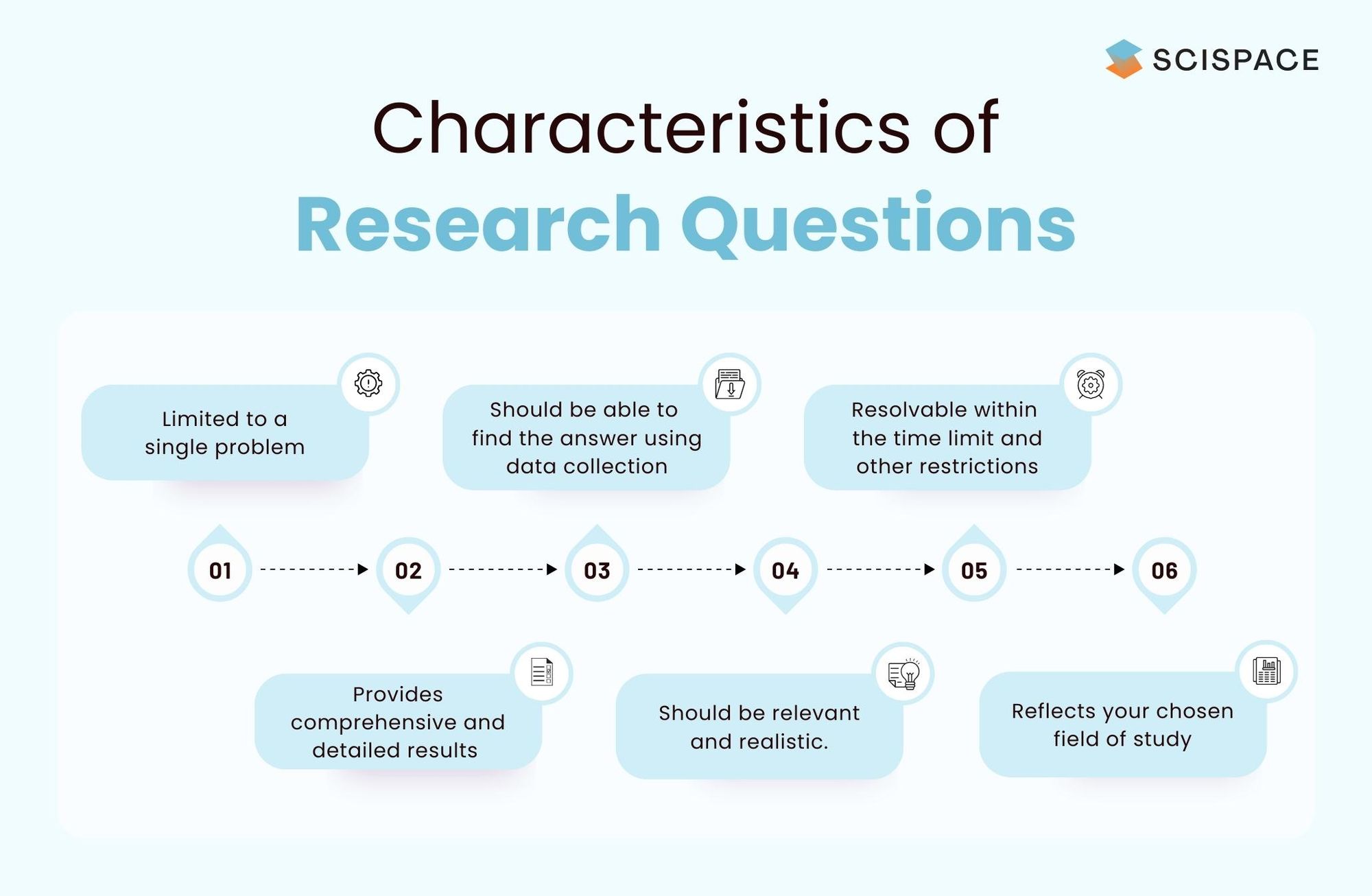
- Should include only one problem in the research question
- Should be able to find the answer using primary data and secondary data sources
- Should be possible to resolve within the given time and other constraints
- Detailed and in-depth results should be achievable
- Should be relevant and realistic.
- It should relate to your chosen area of research
While a larger project, like a thesis, might have several research questions to address, each one should be directed at your main area of study. Of course, you can use different research designs and research methods (qualitative research or quantitative research) to address various research questions. However, they must all be pertinent to the study's objectives.
What is a Research Question?

A research question is an inquiry that the research attempts to answer. It is the heart of the systematic investigation. Research questions are the most important step in any research project. In essence, it initiates the research project and establishes the pace for the specific research A research question is:
- Clear : It provides enough detail that the audience understands its purpose without any additional explanation.
- Focused : It is so specific that it can be addressed within the time constraints of the writing task.
- Succinct: It is written in the shortest possible words.
- Complex : It is not possible to answer it with a "yes" or "no", but requires analysis and synthesis of ideas before somebody can create a solution.
- Argumental : Its potential answers are open for debate rather than accepted facts.
A good research question usually focuses on the research and determines the research design, methodology, and hypothesis. It guides all phases of inquiry, data collection, analysis, and reporting. You should gather valuable information by asking the right questions.
Why are Research Questions so important?
Regardless of whether it is a qualitative research or quantitative research project, research questions provide writers and their audience with a way to navigate the writing and research process. Writers can avoid "all-about" papers by asking straightforward and specific research questions that help them focus on their research and support a specific thesis.
Types of Research Questions

There are two types of research: Qualitative research and Quantitative research . There must be research questions for every type of research. Your research question will be based on the type of research you want to conduct and the type of data collection.
The first step in designing research involves identifying a gap and creating a focused research question.
Below is a list of common research questions that can be used in a dissertation. Keep in mind that these are merely illustrations of typical research questions used in dissertation projects. The real research questions themselves might be more difficult.
Research Question Type | Question |
Descriptive | What are the properties of A? |
Comparative | What are the similarities and distinctions between A and B? |
Correlational | What can you do to correlate variables A and B? |
Exploratory | What factors affect the rate of C's growth? Are A and B also influencing C? |
Explanatory | What are the causes for C? What does A do to B? What's causing D? |
Evaluation | What is the impact of C? What role does B have? What are the benefits and drawbacks of A? |
Action-Based | What can you do to improve X? |
Example Research Questions

The following are a few examples of research questions and research problems to help you understand how research questions can be created for a particular research problem.
Problem | Question |
Due to poor revenue collection, a small-sized company ('A') in the UK cannot allocate a marketing budget next year. | What practical steps can the company take to increase its revenue? |
Many graduates are now working as freelancers even though they have degrees from well-respected academic institutions. But what's the reason these young people choose to work in this field? | Why do fresh graduates choose to work for themselves rather than full-time? What are the benefits and drawbacks of the gig economy? What do age, gender, and academic qualifications do with people's perceptions of freelancing? |
Steps to Write Research Questions

You can focus on the issue or research gaps you're attempting to solve by using the research questions as a direction.
If you're unsure how to go about writing a good research question, these are the steps to follow in the process:
- Select an interesting topic Always choose a topic that interests you. Because if your curiosity isn’t aroused by a subject, you’ll have a hard time conducting research around it. Alos, it’s better that you pick something that’s neither too narrow or too broad.
- Do preliminary research on the topic Search for relevant literature to gauge what problems have already been tackled by scholars. You can do that conveniently through repositories like Scispace , where you’ll find millions of papers in one place. Once you do find the papers you’re looking for, try our reading assistant, SciSpace Copilot to get simple explanations for the paper . You’ll be able to quickly understand the abstract, find the key takeaways, and the main arguments presented in the paper. This will give you a more contextual understanding of your subject and you’ll have an easier time identifying knowledge gaps in your discipline.
Also: ChatPDF vs. SciSpace Copilot: Unveiling the best tool for your research
- Consider your audience It is essential to understand your audience to develop focused research questions for essays or dissertations. When narrowing down your topic, you can identify aspects that might interest your audience.
- Ask questions Asking questions will give you a deeper understanding of the topic. Evaluate your question through the What, Why, When, How, and other open-ended questions assessment.
- Assess your question Once you have created a research question, assess its effectiveness to determine if it is useful for the purpose. Refine and revise the dissertation research question multiple times.
Additionally, use this list of questions as a guide when formulating your research question.
Are you able to answer a specific research question? After identifying a gap in research, it would be helpful to formulate the research question. And this will allow the research to solve a part of the problem. Is your research question clear and centered on the main topic? It is important that your research question should be specific and related to your central goal. Are you tackling a difficult research question? It is not possible to answer the research question with a simple yes or no. The problem requires in-depth analysis. It is often started with "How" and "Why."
Start your research Once you have completed your dissertation research questions, it is time to review the literature on similar topics to discover different perspectives.
Strong Research Question Samples
Uncertain: How should social networking sites work on the hatred that flows through their platform?
Certain: What should social media sites like Twitter or Facebook do to address the harm they are causing?
This unclear question does not specify the social networking sites that are being used or what harm they might be causing. In addition, this question assumes that the "harm" has been proven and/or accepted. This version is more specific and identifies the sites (Twitter, Facebook), the type and extent of harm (privacy concerns), and who might be suffering from that harm (users). Effective research questions should not be ambiguous or interpreted.
Unfocused: What are the effects of global warming on the environment?
Focused: What are the most important effects of glacial melting in Antarctica on penguins' lives?
This broad research question cannot be addressed in a book, let alone a college-level paper. Focused research targets a specific effect of global heating (glacial melting), an area (Antarctica), or a specific animal (penguins). The writer must also decide which effect will have the greatest impact on the animals affected. If in doubt, narrow down your research question to the most specific possible.
Too Simple: What are the U.S. doctors doing to treat diabetes?
Appropriately complex: Which factors, if any, are most likely to predict a person's risk of developing diabetes?
This simple version can be found online. It is easy to answer with a few facts. The second, more complicated version of this question is divided into two parts. It is thought-provoking and requires extensive investigation as well as evaluation by the author. So, ensure that a quick Google search should not answer your research question.
How to write a strong Research Question?

The foundation of all research is the research question. You should therefore spend as much time as necessary to refine your research question based on various data.
You can conduct your research more efficiently and analyze your results better if you have great research questions for your dissertation, research paper , or essay .
The following criteria can help you evaluate the strength and importance of your research question and can be used to determine the strength of your research question:
- Researchable
- It should only cover one issue.
- A subjective judgment should not be included in the question.
- It can be answered with data analysis and research.
- Specific and Practical
- It should not contain a plan of action, policy, or solution.
- It should be clearly defined
- Within research limits
- Complex and Arguable
- It shouldn't be difficult to answer.
- To find the truth, you need in-depth knowledge
- Allows for discussion and deliberation
- Original and Relevant
- It should be in your area of study
- Its results should be measurable
- It should be original
Conclusion - How to write Research Questions?
Research questions provide a clear guideline for research. One research question may be part of a larger project, such as a dissertation. However, each question should only focus on one topic.
Research questions must be answerable, practical, specific, and applicable to your field. The research type that you use to base your research questions on will determine the research topic. You can start by selecting an interesting topic and doing preliminary research. Then, you can begin asking questions, evaluating your questions, and start your research.
Now it's easier than ever to streamline your research workflow with SciSpace ResearchGPT . Its integrated, comprehensive end-to-end platform for research allows scholars to easily discover, read, write and publish their research and fosters collaboration.
You might also like

Consensus GPT vs. SciSpace GPT: Choose the Best GPT for Research

Literature Review and Theoretical Framework: Understanding the Differences

Types of Essays in Academic Writing - Quick Guide (2024)
Educational resources and simple solutions for your research journey

How to Craft a Strong Research Question (With Research Question Examples)
A sound and effective research question is a key element that must be identified and pinned down before researchers can even begin their research study or work. A strong research question lays the foundation for your entire study, guiding your investigation and shaping your findings. Hence, it is critical that researchers spend considerable time assessing and refining the research question based on in-depth reading and comprehensive literature review. In this article, we will discuss how to write a strong research question and provide you with some good examples of research questions across various disciplines.
Table of Contents
The importance of a research question
A research question plays a crucial role in driving scientific inquiry, setting the direction and purpose of your study, and guiding your entire research process. By formulating a clear and focused research question, you lay the foundation for your investigation, ensuring that your research remains on track and aligned with your objectives so you can make meaningful contribution to the existing body of knowledge. A well-crafted research question also helps you define the scope of your study and identify the appropriate methodologies and data collection techniques to employ.
Key components of a strong research question
A good research question possesses several key components that contribute to the quality and impact of your study. Apart from providing a clear framework to generate meaningful results, a well-defined research question allows other researchers to understand the purpose and significance of your work. So, when working on your research question, incorporate the following elements:
- Specificity : A strong research question should be specific about the main focus of your study, enabling you to gather precise data and draw accurate conclusions. It clearly defines the variables, participants, and context involved, leaving no room for ambiguity.
- Clarity : A good research question is clear and easily understood, so articulate the purpose and intent of your study concisely without being generic or vague. Ensuring clarity in your research question helps both you and your readers grasp the research objective.
- Feasibility : While crafting a research question, consider the practicality of conducting the research and availability of necessary data or access to participants. Think whether your study is realistic and achievable within the constraints of time, resources, and ethical considerations.
How to craft a well-defined research question
A first step that will help save time and effort is knowing what your aims are and thinking about a few problem statements on the area or aspect one wants to study or do research on. Contemplating these statements as one undertakes more progressive reading can help the researcher in reassessing and fine-tuning the research question. This can be done over time as they read and learn more about the research topic, along with a broad literature review and parallel discussions with peer researchers and supervisors. In some cases, a researcher can have more than one research question if the research being undertaken is a PhD thesis or dissertation, but try not to cover multiple concerns on a topic.
A strong research question must be researchable, original, complex, and relevant. Here are five simple steps that can make the entire process easier.
- Identify a broad topic from your areas of interest, something that is relevant, and you are passionate about since you’ll be spending a lot of time conducting your research.
- Do a thorough literature review to weed out potential gaps in research and stay updated on what’s currently being done in your chosen topic and subject area.
- Shortlist possible research questions based on the research gaps or see how you can build on or refute previously published ideas and concepts.
- Assess your chosen research question using the FINER criteria that helps you evaluate whether the research is Feasible, Interesting, Novel, Ethical, and Relevant. 1
- Formulate the final research question, while ensuring it is clear, well-written, and addresses all the key elements of a strong research question.
Examples of research questions
Remember to adapt your research question to suit your purpose, whether it’s exploratory, descriptive, comparative, experimental, qualitative, or quantitative. Embrace the iterative nature of the research process, continually evaluating and refining your question as you progress. Here are some good examples of research questions across various disciplines.
Exploratory research question examples
- How does social media impact interpersonal relationships among teenagers?
- What are the potential benefits of incorporating mindfulness practices in the workplace?
Descriptive research question examples
- What factors influence customer loyalty in the e-commerce industry?
- Is there a relationship between socioeconomic status and academic performance among elementary school students?
Comparative research question examples
- How does the effectiveness of traditional teaching methods compare to online learning platforms in mathematics education?
- What is the impact of different healthcare policies on patient outcomes in various countries?
Experimental research question examples
- What are the effects of a new drug on reducing symptoms of a specific medical condition?
- Does a dietary intervention have an impact on weight loss among individuals with obesity?
Qualitative research question examples
- What are the lived experiences of immigrants adapting to a new culture?
- What factors influence job satisfaction among healthcare professionals?
Quantitative research question examples
- Is there a relationship between sleep duration and academic performance among college students?
- How effective is a specific intervention in reducing anxiety levels among individuals with phobias?
With these simple guidelines and inspiring examples of research questions, you are equipped to embark on your research journey with confidence and purpose. Here’s wishing you all the best for your future endeavors!
References:
- How to write a research question: Steps and examples. Indeed Career Guide. Available online at https://www.indeed.com/career-advice/career-development/how-to-write-research-questions
R Discovery is a literature search and research reading platform that accelerates your research discovery journey by keeping you updated on the latest, most relevant scholarly content. With 250M+ research articles sourced from trusted aggregators like CrossRef, Unpaywall, PubMed, PubMed Central, Open Alex and top publishing houses like Springer Nature, JAMA, IOP, Taylor & Francis, NEJM, BMJ, Karger, SAGE, Emerald Publishing and more, R Discovery puts a world of research at your fingertips.
Try R Discovery Prime FREE for 1 week or upgrade at just US$72 a year to access premium features that let you listen to research on the go, read in your language, collaborate with peers, auto sync with reference managers, and much more. Choose a simpler, smarter way to find and read research – Download the app and start your free 7-day trial today !
Related Posts

Annex vs Appendix: What is the difference?

Simple Random Sampling: Definition, Methods, and Examples

Get science-backed answers as you write with Paperpal's Research feature
How to Write a Research Question: Types and Examples

The first step in any research project is framing the research question. It can be considered the core of any systematic investigation as the research outcomes are tied to asking the right questions. Thus, this primary interrogation point sets the pace for your research as it helps collect relevant and insightful information that ultimately influences your work.
Typically, the research question guides the stages of inquiry, analysis, and reporting. Depending on the use of quantifiable or quantitative data, research questions are broadly categorized into quantitative or qualitative research questions. Both types of research questions can be used independently or together, considering the overall focus and objectives of your research.
A research question is a clear, focused, concise, and arguable question on which your research and writing are centered. 1 It states various aspects of the study, including the population and variables to be studied and the problem the study addresses. These questions also set the boundaries of the study, ensuring cohesion.
Designing the research question is a dynamic process where the researcher can change or refine the research question as they review related literature and develop a framework for the study. Depending on the scale of your research, the study can include single or multiple research questions.
A good research question has the following features:
- It is relevant to the chosen field of study.
- The question posed is arguable and open for debate, requiring synthesizing and analysis of ideas.
- It is focused and concisely framed.
- A feasible solution is possible within the given practical constraint and timeframe.
A poorly formulated research question poses several risks. 1
- Researchers can adopt an erroneous design.
- It can create confusion and hinder the thought process, including developing a clear protocol.
- It can jeopardize publication efforts.
- It causes difficulty in determining the relevance of the study findings.
- It causes difficulty in whether the study fulfils the inclusion criteria for systematic review and meta-analysis. This creates challenges in determining whether additional studies or data collection is needed to answer the question.
- Readers may fail to understand the objective of the study. This reduces the likelihood of the study being cited by others.
Now that you know “What is a research question?”, let’s look at the different types of research questions.
Types of research questions
Depending on the type of research to be done, research questions can be classified broadly into quantitative, qualitative, or mixed-methods studies. Knowing the type of research helps determine the best type of research question that reflects the direction and epistemological underpinnings of your research.
The structure and wording of quantitative 2 and qualitative research 3 questions differ significantly. The quantitative study looks at causal relationships, whereas the qualitative study aims at exploring a phenomenon.
- Quantitative research questions:
- Seeks to investigate social, familial, or educational experiences or processes in a particular context and/or location.
- Answers ‘how,’ ‘what,’ or ‘why’ questions.
- Investigates connections, relations, or comparisons between independent and dependent variables.
Quantitative research questions can be further categorized into descriptive, comparative, and relationship, as explained in the Table below.
| Descriptive research questions | These measure the responses of a study’s population toward a particular question or variable. Common descriptive research questions will begin with “How much?”, “How regularly?”, “What percentage?”, “What time?”, “What is?” Research question example: How often do you buy mobile apps for learning purposes? |
| Comparative research questions | These investigate differences between two or more groups for an outcome variable. For instance, the researcher may compare groups with and without a certain variable. Research question example: What are the differences in attitudes towards online learning between visual and Kinaesthetic learners? |
| Relationship research questions | These explore and define trends and interactions between two or more variables. These investigate relationships between dependent and independent variables and use words such as “association” or “trends. Research question example: What is the relationship between disposable income and job satisfaction amongst US residents? |
- Qualitative research questions
Qualitative research questions are adaptable, non-directional, and more flexible. It concerns broad areas of research or more specific areas of study to discover, explain, or explore a phenomenon. These are further classified as follows:
| Exploratory Questions | These question looks to understand something without influencing the results. The aim is to learn more about a topic without attributing bias or preconceived notions. Research question example: What are people’s thoughts on the new government? |
| Experiential questions | These questions focus on understanding individuals’ experiences, perspectives, and subjective meanings related to a particular phenomenon. They aim to capture personal experiences and emotions. Research question example: What are the challenges students face during their transition from school to college? |
| Interpretive Questions | These questions investigate people in their natural settings to help understand how a group makes sense of shared experiences of a phenomenon. Research question example: How do you feel about ChatGPT assisting student learning? |
- Mixed-methods studies
Mixed-methods studies use both quantitative and qualitative research questions to answer your research question. Mixed methods provide a complete picture than standalone quantitative or qualitative research, as it integrates the benefits of both methods. Mixed methods research is often used in multidisciplinary settings and complex situational or societal research, especially in the behavioral, health, and social science fields.
What makes a good research question
A good research question should be clear and focused to guide your research. It should synthesize multiple sources to present your unique argument, and should ideally be something that you are interested in. But avoid questions that can be answered in a few factual statements. The following are the main attributes of a good research question.
- Specific: The research question should not be a fishing expedition performed in the hopes that some new information will be found that will benefit the researcher. The central research question should work with your research problem to keep your work focused. If using multiple questions, they should all tie back to the central aim.
- Measurable: The research question must be answerable using quantitative and/or qualitative data or from scholarly sources to develop your research question. If such data is impossible to access, it is better to rethink your question.
- Attainable: Ensure you have enough time and resources to do all research required to answer your question. If it seems you will not be able to gain access to the data you need, consider narrowing down your question to be more specific.
- You have the expertise
- You have the equipment and resources
- Realistic: Developing your research question should be based on initial reading about your topic. It should focus on addressing a problem or gap in the existing knowledge in your field or discipline.
- Based on some sort of rational physics
- Can be done in a reasonable time frame
- Timely: The research question should contribute to an existing and current debate in your field or in society at large. It should produce knowledge that future researchers or practitioners can later build on.
- Novel
- Based on current technologies.
- Important to answer current problems or concerns.
- Lead to new directions.
- Important: Your question should have some aspect of originality. Incremental research is as important as exploring disruptive technologies. For example, you can focus on a specific location or explore a new angle.
- Meaningful whether the answer is “Yes” or “No.” Closed-ended, yes/no questions are too simple to work as good research questions. Such questions do not provide enough scope for robust investigation and discussion. A good research question requires original data, synthesis of multiple sources, and original interpretation and argumentation before providing an answer.
Steps for developing a good research question
The importance of research questions cannot be understated. When drafting a research question, use the following frameworks to guide the components of your question to ease the process. 4
- Determine the requirements: Before constructing a good research question, set your research requirements. What is the purpose? Is it descriptive, comparative, or explorative research? Determining the research aim will help you choose the most appropriate topic and word your question appropriately.
- Select a broad research topic: Identify a broader subject area of interest that requires investigation. Techniques such as brainstorming or concept mapping can help identify relevant connections and themes within a broad research topic. For example, how to learn and help students learn.
- Perform preliminary investigation: Preliminary research is needed to obtain up-to-date and relevant knowledge on your topic. It also helps identify issues currently being discussed from which information gaps can be identified.
- Narrow your focus: Narrow the scope and focus of your research to a specific niche. This involves focusing on gaps in existing knowledge or recent literature or extending or complementing the findings of existing literature. Another approach involves constructing strong research questions that challenge your views or knowledge of the area of study (Example: Is learning consistent with the existing learning theory and research).
- Identify the research problem: Once the research question has been framed, one should evaluate it. This is to realize the importance of the research questions and if there is a need for more revising (Example: How do your beliefs on learning theory and research impact your instructional practices).
Those struggling to understand how to write a research question, these simple steps can help you simplify the process of writing a research question.
| Topic selection | Choose a broad topic, such as “learner support” or “social media influence” for your study. Select topics of interest to make research more enjoyable and stay motivated. |
| Preliminary research | The goal is to refine and focus your research question. The following strategies can help: Skim various scholarly articles. List subtopics under the main topic. List possible research questions for each subtopic. Consider the scope of research for each of the research questions. Select research questions that are answerable within a specific time and with available resources. If the scope is too large, repeat looking for sub-subtopics. |
| Audience | When choosing what to base your research on, consider your readers. For college papers, the audience is academic. Ask yourself if your audience may be interested in the topic you are thinking about pursuing. Determining your audience can also help refine the importance of your research question and focus on items related to your defined group. |
| Generate potential questions | Ask open-ended “how?” and “why?” questions to find a more specific research question. Gap-spotting to identify research limitations, problematization to challenge assumptions made by others, or using personal experiences to draw on issues in your industry can be used to generate questions. |
| Review brainstormed questions | Evaluate each question to check their effectiveness. Use the FINER model to see if the question meets all the research question criteria. |
| Construct the research question | Multiple frameworks, such as PICOT and PEA, are available to help structure your research question. The frameworks listed below can help you with the necessary information for generating your research question. |
| Framework | Attributes of each framework |
| FINER | Feasible Interesting Novel Ethical Relevant |
| PICOT | Population or problem Intervention or indicator being studied Comparison group Outcome of interest Time frame of the study |
| PEO | Population being studied Exposure to preexisting conditions Outcome of interest |
Sample Research Questions
The following are some bad and good research question examples
- Example 1
| Unclear: How does social media affect student growth? |
| Clear: What effect does the daily use of Twitter and Facebook have on the career development goals of students? |
| Explanation: The first research question is unclear because of the vagueness of “social media” as a concept and the lack of specificity. The second question is specific and focused, and its answer can be discovered through data collection and analysis. |
- Example 2
| Simple: Has there been an increase in the number of gifted children identified? |
| Complex: What practical techniques can teachers use to identify and guide gifted children better? |
| Explanation: A simple “yes” or “no” statement easily answers the first research question. The second research question is more complicated and requires the researcher to collect data, perform in-depth data analysis, and form an argument that leads to further discussion. |
References:
- Thabane, L., Thomas, T., Ye, C., & Paul, J. (2009). Posing the research question: not so simple. Canadian Journal of Anesthesia/Journal canadien d’anesthésie , 56 (1), 71-79.
- Rutberg, S., & Bouikidis, C. D. (2018). Focusing on the fundamentals: A simplistic differentiation between qualitative and quantitative research. Nephrology Nursing Journal , 45 (2), 209-213.
- Kyngäs, H. (2020). Qualitative research and content analysis. The application of content analysis in nursing science research , 3-11.
- Mattick, K., Johnston, J., & de la Croix, A. (2018). How to… write a good research question. The clinical teacher , 15 (2), 104-108.
- Fandino, W. (2019). Formulating a good research question: Pearls and pitfalls. Indian Journal of Anaesthesia , 63 (8), 611.
- Richardson, W. S., Wilson, M. C., Nishikawa, J., & Hayward, R. S. (1995). The well-built clinical question: a key to evidence-based decisions. ACP journal club , 123 (3), A12-A13
Paperpal is a comprehensive AI writing toolkit that helps students and researchers achieve 2x the writing in half the time. It leverages 21+ years of STM experience and insights from millions of research articles to provide in-depth academic writing, language editing, and submission readiness support to help you write better, faster.
Get accurate academic translations, rewriting support, grammar checks, vocabulary suggestions, and generative AI assistance that delivers human precision at machine speed. Try for free or upgrade to Paperpal Prime starting at US$19 a month to access premium features, including consistency, plagiarism, and 30+ submission readiness checks to help you succeed.
Experience the future of academic writing – Sign up to Paperpal and start writing for free!
Related Reads:
- Scientific Writing Style Guides Explained
- Ethical Research Practices For Research with Human Subjects
- 8 Most Effective Ways to Increase Motivation for Thesis Writing
- 6 Tips for Post-Doc Researchers to Take Their Career to the Next Level
Transitive and Intransitive Verbs in the World of Research
Language and grammar rules for academic writing, you may also like, how to write an academic paragraph (step-by-step guide), research funding basics: what should a grant proposal..., how to write the first draft of a..., mla works cited page: format, template & examples, academic editing: how to self-edit academic text with..., measuring academic success: definition & strategies for excellence, phd qualifying exam: tips for success , quillbot review: features, pricing, and free alternatives, what is an academic paper types and elements , 9 steps to publish a research paper.

Research Aims, Objectives & Questions
The “Golden Thread” Explained Simply (+ Examples)
By: David Phair (PhD) and Alexandra Shaeffer (PhD) | June 2022
The research aims , objectives and research questions (collectively called the “golden thread”) are arguably the most important thing you need to get right when you’re crafting a research proposal , dissertation or thesis . We receive questions almost every day about this “holy trinity” of research and there’s certainly a lot of confusion out there, so we’ve crafted this post to help you navigate your way through the fog.
Overview: The Golden Thread
- What is the golden thread
- What are research aims ( examples )
- What are research objectives ( examples )
- What are research questions ( examples )
- The importance of alignment in the golden thread
What is the “golden thread”?
The golden thread simply refers to the collective research aims , research objectives , and research questions for any given project (i.e., a dissertation, thesis, or research paper ). These three elements are bundled together because it’s extremely important that they align with each other, and that the entire research project aligns with them.
Importantly, the golden thread needs to weave its way through the entirety of any research project , from start to end. In other words, it needs to be very clearly defined right at the beginning of the project (the topic ideation and proposal stage) and it needs to inform almost every decision throughout the rest of the project. For example, your research design and methodology will be heavily influenced by the golden thread (we’ll explain this in more detail later), as well as your literature review.
The research aims, objectives and research questions (the golden thread) define the focus and scope ( the delimitations ) of your research project. In other words, they help ringfence your dissertation or thesis to a relatively narrow domain, so that you can “go deep” and really dig into a specific problem or opportunity. They also help keep you on track , as they act as a litmus test for relevance. In other words, if you’re ever unsure whether to include something in your document, simply ask yourself the question, “does this contribute toward my research aims, objectives or questions?”. If it doesn’t, chances are you can drop it.
Alright, enough of the fluffy, conceptual stuff. Let’s get down to business and look at what exactly the research aims, objectives and questions are and outline a few examples to bring these concepts to life.

Research Aims: What are they?
Simply put, the research aim(s) is a statement that reflects the broad overarching goal (s) of the research project. Research aims are fairly high-level (low resolution) as they outline the general direction of the research and what it’s trying to achieve .
Research Aims: Examples
True to the name, research aims usually start with the wording “this research aims to…”, “this research seeks to…”, and so on. For example:
“This research aims to explore employee experiences of digital transformation in retail HR.” “This study sets out to assess the interaction between student support and self-care on well-being in engineering graduate students”
As you can see, these research aims provide a high-level description of what the study is about and what it seeks to achieve. They’re not hyper-specific or action-oriented, but they’re clear about what the study’s focus is and what is being investigated.
Need a helping hand?
Research Objectives: What are they?
The research objectives take the research aims and make them more practical and actionable . In other words, the research objectives showcase the steps that the researcher will take to achieve the research aims.
The research objectives need to be far more specific (higher resolution) and actionable than the research aims. In fact, it’s always a good idea to craft your research objectives using the “SMART” criteria. In other words, they should be specific, measurable, achievable, relevant and time-bound”.
Research Objectives: Examples
Let’s look at two examples of research objectives. We’ll stick with the topic and research aims we mentioned previously.
For the digital transformation topic:
To observe the retail HR employees throughout the digital transformation. To assess employee perceptions of digital transformation in retail HR. To identify the barriers and facilitators of digital transformation in retail HR.
And for the student wellness topic:
To determine whether student self-care predicts the well-being score of engineering graduate students. To determine whether student support predicts the well-being score of engineering students. To assess the interaction between student self-care and student support when predicting well-being in engineering graduate students.
As you can see, these research objectives clearly align with the previously mentioned research aims and effectively translate the low-resolution aims into (comparatively) higher-resolution objectives and action points . They give the research project a clear focus and present something that resembles a research-based “to-do” list.

Research Questions: What are they?
Finally, we arrive at the all-important research questions. The research questions are, as the name suggests, the key questions that your study will seek to answer . Simply put, they are the core purpose of your dissertation, thesis, or research project. You’ll present them at the beginning of your document (either in the introduction chapter or literature review chapter) and you’ll answer them at the end of your document (typically in the discussion and conclusion chapters).
The research questions will be the driving force throughout the research process. For example, in the literature review chapter, you’ll assess the relevance of any given resource based on whether it helps you move towards answering your research questions. Similarly, your methodology and research design will be heavily influenced by the nature of your research questions. For instance, research questions that are exploratory in nature will usually make use of a qualitative approach, whereas questions that relate to measurement or relationship testing will make use of a quantitative approach.
Let’s look at some examples of research questions to make this more tangible.
Research Questions: Examples
Again, we’ll stick with the research aims and research objectives we mentioned previously.
For the digital transformation topic (which would be qualitative in nature):
How do employees perceive digital transformation in retail HR? What are the barriers and facilitators of digital transformation in retail HR?
And for the student wellness topic (which would be quantitative in nature):
Does student self-care predict the well-being scores of engineering graduate students? Does student support predict the well-being scores of engineering students? Do student self-care and student support interact when predicting well-being in engineering graduate students?
You’ll probably notice that there’s quite a formulaic approach to this. In other words, the research questions are basically the research objectives “converted” into question format. While that is true most of the time, it’s not always the case. For example, the first research objective for the digital transformation topic was more or less a step on the path toward the other objectives, and as such, it didn’t warrant its own research question.
So, don’t rush your research questions and sloppily reword your objectives as questions. Carefully think about what exactly you’re trying to achieve (i.e. your research aim) and the objectives you’ve set out, then craft a set of well-aligned research questions . Also, keep in mind that this can be a somewhat iterative process , where you go back and tweak research objectives and aims to ensure tight alignment throughout the golden thread.
The importance of strong alignment
Alignment is the keyword here and we have to stress its importance . Simply put, you need to make sure that there is a very tight alignment between all three pieces of the golden thread. If your research aims and research questions don’t align, for example, your project will be pulling in different directions and will lack focus . This is a common problem students face and can cause many headaches (and tears), so be warned.
Take the time to carefully craft your research aims, objectives and research questions before you run off down the research path. Ideally, get your research supervisor/advisor to review and comment on your golden thread before you invest significant time into your project, and certainly before you start collecting data .
Recap: The golden thread
In this post, we unpacked the golden thread of research, consisting of the research aims , research objectives and research questions . You can jump back to any section using the links below.
As always, feel free to leave a comment below – we always love to hear from you. Also, if you’re interested in 1-on-1 support, take a look at our private coaching service here.

Psst... there’s more!
This post was based on one of our popular Research Bootcamps . If you're working on a research project, you'll definitely want to check this out ...
39 Comments
Thank you very much for your great effort put. As an Undergraduate taking Demographic Research & Methodology, I’ve been trying so hard to understand clearly what is a Research Question, Research Aim and the Objectives in a research and the relationship between them etc. But as for now I’m thankful that you’ve solved my problem.
Well appreciated. This has helped me greatly in doing my dissertation.
An so delighted with this wonderful information thank you a lot.
so impressive i have benefited a lot looking forward to learn more on research.
I am very happy to have carefully gone through this well researched article.
Infact,I used to be phobia about anything research, because of my poor understanding of the concepts.
Now,I get to know that my research question is the same as my research objective(s) rephrased in question format.
I please I would need a follow up on the subject,as I intends to join the team of researchers. Thanks once again.
Thanks so much. This was really helpful.
I know you pepole have tried to break things into more understandable and easy format. And God bless you. Keep it up
i found this document so useful towards my study in research methods. thanks so much.
This is my 2nd read topic in your course and I should commend the simplified explanations of each part. I’m beginning to understand and absorb the use of each part of a dissertation/thesis. I’ll keep on reading your free course and might be able to avail the training course! Kudos!
Thank you! Better put that my lecture and helped to easily understand the basics which I feel often get brushed over when beginning dissertation work.
This is quite helpful. I like how the Golden thread has been explained and the needed alignment.
This is quite helpful. I really appreciate!
The article made it simple for researcher students to differentiate between three concepts.
Very innovative and educational in approach to conducting research.
I am very impressed with all these terminology, as I am a fresh student for post graduate, I am highly guided and I promised to continue making consultation when the need arise. Thanks a lot.
A very helpful piece. thanks, I really appreciate it .
Very well explained, and it might be helpful to many people like me.
Wish i had found this (and other) resource(s) at the beginning of my PhD journey… not in my writing up year… 😩 Anyways… just a quick question as i’m having some issues ordering my “golden thread”…. does it matter in what order you mention them? i.e., is it always first aims, then objectives, and finally the questions? or can you first mention the research questions and then the aims and objectives?
Thank you for a very simple explanation that builds upon the concepts in a very logical manner. Just prior to this, I read the research hypothesis article, which was equally very good. This met my primary objective.
My secondary objective was to understand the difference between research questions and research hypothesis, and in which context to use which one. However, I am still not clear on this. Can you kindly please guide?
In research, a research question is a clear and specific inquiry that the researcher wants to answer, while a research hypothesis is a tentative statement or prediction about the relationship between variables or the expected outcome of the study. Research questions are broader and guide the overall study, while hypotheses are specific and testable statements used in quantitative research. Research questions identify the problem, while hypotheses provide a focus for testing in the study.
Exactly what I need in this research journey, I look forward to more of your coaching videos.
This helped a lot. Thanks so much for the effort put into explaining it.
What data source in writing dissertation/Thesis requires?
What is data source covers when writing dessertation/thesis
This is quite useful thanks
I’m excited and thankful. I got so much value which will help me progress in my thesis.
where are the locations of the reserch statement, research objective and research question in a reserach paper? Can you write an ouline that defines their places in the researh paper?
Very helpful and important tips on Aims, Objectives and Questions.
Thank you so much for making research aim, research objectives and research question so clear. This will be helpful to me as i continue with my thesis.
Thanks much for this content. I learned a lot. And I am inspired to learn more. I am still struggling with my preparation for dissertation outline/proposal. But I consistently follow contents and tutorials and the new FB of GRAD Coach. Hope to really become confident in writing my dissertation and successfully defend it.
As a researcher and lecturer, I find splitting research goals into research aims, objectives, and questions is unnecessarily bureaucratic and confusing for students. For most biomedical research projects, including ‘real research’, 1-3 research questions will suffice (numbers may differ by discipline).
Awesome! Very important resources and presented in an informative way to easily understand the golden thread. Indeed, thank you so much.
Well explained
The blog article on research aims, objectives, and questions by Grad Coach is a clear and insightful guide that aligns with my experiences in academic research. The article effectively breaks down the often complex concepts of research aims and objectives, providing a straightforward and accessible explanation. Drawing from my own research endeavors, I appreciate the practical tips offered, such as the need for specificity and clarity when formulating research questions. The article serves as a valuable resource for students and researchers, offering a concise roadmap for crafting well-defined research goals and objectives. Whether you’re a novice or an experienced researcher, this article provides practical insights that contribute to the foundational aspects of a successful research endeavor.
A great thanks for you. it is really amazing explanation. I grasp a lot and one step up to research knowledge.
I really found these tips helpful. Thank you very much Grad Coach.
I found this article helpful. Thanks for sharing this.
thank you so much, the explanation and examples are really helpful
Submit a Comment Cancel reply
Your email address will not be published. Required fields are marked *
Save my name, email, and website in this browser for the next time I comment.
- Print Friendly
- Research Questions: Definitions, Types + [Examples]

Research questions lie at the core of systematic investigation and this is because recording accurate research outcomes is tied to asking the right questions. Asking the right questions when conducting research can help you collect relevant and insightful information that ultimately influences your work, positively.
The right research questions are typically easy to understand, straight to the point, and engaging. In this article, we will share tips on how to create the right research questions and also show you how to create and administer an online questionnaire with Formplus .
What is a Research Question?
A research question is a specific inquiry which the research seeks to provide a response to. It resides at the core of systematic investigation and it helps you to clearly define a path for the research process.
A research question is usually the first step in any research project. Basically, it is the primary interrogation point of your research and it sets the pace for your work.
Typically, a research question focuses on the research, determines the methodology and hypothesis, and guides all stages of inquiry, analysis, and reporting. With the right research questions, you will be able to gather useful information for your investigation.
Types of Research Questions
Research questions are broadly categorized into 2; that is, qualitative research questions and quantitative research questions. Qualitative and quantitative research questions can be used independently and co-dependently in line with the overall focus and objectives of your research.
If your research aims at collecting quantifiable data , you will need to make use of quantitative research questions. On the other hand, qualitative questions help you to gather qualitative data bothering on the perceptions and observations of your research subjects.
Qualitative Research Questions
A qualitative research question is a type of systematic inquiry that aims at collecting qualitative data from research subjects. The aim of qualitative research questions is to gather non-statistical information pertaining to the experiences, observations, and perceptions of the research subjects in line with the objectives of the investigation.
Types of Qualitative Research Questions
- Ethnographic Research Questions
As the name clearly suggests, ethnographic research questions are inquiries presented in ethnographic research. Ethnographic research is a qualitative research approach that involves observing variables in their natural environments or habitats in order to arrive at objective research outcomes.
These research questions help the researcher to gather insights into the habits, dispositions, perceptions, and behaviors of research subjects as they interact in specific environments.
Ethnographic research questions can be used in education, business, medicine, and other fields of study, and they are very useful in contexts aimed at collecting in-depth and specific information that are peculiar to research variables. For instance, asking educational ethnographic research questions can help you understand how pedagogy affects classroom relations and behaviors.
This type of research question can be administered physically through one-on-one interviews, naturalism (live and work), and participant observation methods. Alternatively, the researcher can ask ethnographic research questions via online surveys and questionnaires created with Formplus.
Examples of Ethnographic Research Questions
- Why do you use this product?
- Have you noticed any side effects since you started using this drug?
- Does this product meet your needs?
- Case Studies
A case study is a qualitative research approach that involves carrying out a detailed investigation into a research subject(s) or variable(s). In the course of a case study, the researcher gathers a range of data from multiple sources of information via different data collection methods, and over a period of time.
The aim of a case study is to analyze specific issues within definite contexts and arrive at detailed research subject analyses by asking the right questions. This research method can be explanatory, descriptive , or exploratory depending on the focus of your systematic investigation or research.
An explanatory case study is one that seeks to gather information on the causes of real-life occurrences. This type of case study uses “how” and “why” questions in order to gather valid information about the causative factors of an event.
Descriptive case studies are typically used in business researches, and they aim at analyzing the impact of changing market dynamics on businesses. On the other hand, exploratory case studies aim at providing answers to “who” and “what” questions using data collection tools like interviews and questionnaires.
Some questions you can include in your case studies are:
- Why did you choose our services?
- How has this policy affected your business output?
- What benefits have you recorded since you started using our product?
An interview is a qualitative research method that involves asking respondents a series of questions in order to gather information about a research subject. Interview questions can be close-ended or open-ended , and they prompt participants to provide valid information that is useful to the research.
An interview may also be structured, semi-structured , or unstructured , and this further influences the types of questions they include. Structured interviews are made up of more close-ended questions because they aim at gathering quantitative data while unstructured interviews consist, primarily, of open-ended questions that allow the researcher to collect qualitative information from respondents.
You can conduct interview research by scheduling a physical meeting with respondents, through a telephone conversation, and via digital media and video conferencing platforms like Skype and Zoom. Alternatively, you can use Formplus surveys and questionnaires for your interview.
Examples of interview questions include:
- What challenges did you face while using our product?
- What specific needs did our product meet?
- What would you like us to improve our service delivery?
Quantitative Research Questions
Quantitative research questions are questions that are used to gather quantifiable data from research subjects. These types of research questions are usually more specific and direct because they aim at collecting information that can be measured; that is, statistical information.
Types of Quantitative Research Questions
- Descriptive Research Questions
Descriptive research questions are inquiries that researchers use to gather quantifiable data about the attributes and characteristics of research subjects. These types of questions primarily seek responses that reveal existing patterns in the nature of the research subjects.
It is important to note that descriptive research questions are not concerned with the causative factors of the discovered attributes and characteristics. Rather, they focus on the “what”; that is, describing the subject of the research without paying attention to the reasons for its occurrence.
Descriptive research questions are typically closed-ended because they aim at gathering definite and specific responses from research participants. Also, they can be used in customer experience surveys and market research to collect information about target markets and consumer behaviors.
Descriptive Research Question Examples
- How often do you make use of our fitness application?
- How much would you be willing to pay for this product?
- Comparative Research Questions
A comparative research question is a type of quantitative research question that is used to gather information about the differences between two or more research subjects across different variables. These types of questions help the researcher to identify distinct features that mark one research subject from the other while highlighting existing similarities.
Asking comparative research questions in market research surveys can provide insights on how your product or service matches its competitors. In addition, it can help you to identify the strengths and weaknesses of your product for a better competitive advantage.
The 5 steps involved in the framing of comparative research questions are:
- Choose your starting phrase
- Identify and name the dependent variable
- Identify the groups you are interested in
- Identify the appropriate adjoining text
- Write out the comparative research question
Comparative Research Question Samples
- What are the differences between a landline telephone and a smartphone?
- What are the differences between work-from-home and on-site operations?
- Relationship-based Research Questions
Just like the name suggests, a relationship-based research question is one that inquires into the nature of the association between two research subjects within the same demographic. These types of research questions help you to gather information pertaining to the nature of the association between two research variables.
Relationship-based research questions are also known as correlational research questions because they seek to clearly identify the link between 2 variables.
Read: Correlational Research Designs: Types, Examples & Methods
Examples of relationship-based research questions include:
- What is the relationship between purchasing power and the business site?
- What is the relationship between the work environment and workforce turnover?
Examples of a Good Research Question
Since research questions lie at the core of any systematic investigations, it is important to know how to frame a good research question. The right research questions will help you to gather the most objective responses that are useful to your systematic investigation.
A good research question is one that requires impartial responses and can be answered via existing sources of information. Also, a good research question seeks answers that actively contribute to a body of knowledge; hence, it is a question that is yet to be answered in your specific research context.
- Open-Ended Questions
An open-ended question is a type of research question that does not restrict respondents to a set of premeditated answer options. In other words, it is a question that allows the respondent to freely express his or her perceptions and feelings towards the research subject.
Examples of Open-ended Questions
- How do you deal with stress in the workplace?
- What is a typical day at work like for you?
- Close-ended Questions
A close-ended question is a type of survey question that restricts respondents to a set of predetermined answers such as multiple-choice questions . Close-ended questions typically require yes or no answers and are commonly used in quantitative research to gather numerical data from research participants.
Examples of Close-ended Questions
- Did you enjoy this event?
- How likely are you to recommend our services?
- Very Likely
- Somewhat Likely
- Likert Scale Questions
A Likert scale question is a type of close-ended question that is structured as a 3-point, 5-point, or 7-point psychometric scale . This type of question is used to measure the survey respondent’s disposition towards multiple variables and it can be unipolar or bipolar in nature.
Example of Likert Scale Questions
- How satisfied are you with our service delivery?
- Very dissatisfied
- Not satisfied
- Very satisfied
- Rating Scale Questions
A rating scale question is a type of close-ended question that seeks to associate a specific qualitative measure (rating) with the different variables in research. It is commonly used in customer experience surveys, market research surveys, employee reviews, and product evaluations.
Example of Rating Questions
- How would you rate our service delivery?
Examples of a Bad Research Question
Knowing what bad research questions are would help you avoid them in the course of your systematic investigation. These types of questions are usually unfocused and often result in research biases that can negatively impact the outcomes of your systematic investigation.
- Loaded Questions
A loaded question is a question that subtly presupposes one or more unverified assumptions about the research subject or participant. This type of question typically boxes the respondent in a corner because it suggests implicit and explicit biases that prevent objective responses.
Example of Loaded Questions
- Have you stopped smoking?
- Where did you hide the money?
- Negative Questions
A negative question is a type of question that is structured with an implicit or explicit negator. Negative questions can be misleading because they upturn the typical yes/no response order by requiring a negative answer for affirmation and an affirmative answer for negation.
Examples of Negative Questions
- Would you mind dropping by my office later today?
- Didn’t you visit last week?
- Leading Questions
A l eading question is a type of survey question that nudges the respondent towards an already-determined answer. It is highly suggestive in nature and typically consists of biases and unverified assumptions that point toward its premeditated responses.
Examples of Leading Questions
- If you enjoyed this service, would you be willing to try out our other packages?
- Our product met your needs, didn’t it?
Read More: Leading Questions: Definition, Types, and Examples
How to Use Formplus as Online Research Questionnaire Tool
With Formplus, you can create and administer your online research questionnaire easily. In the form builder, you can add different form fields to your questionnaire and edit these fields to reflect specific research questions for your systematic investigation.
Here is a step-by-step guide on how to create an online research questionnaire with Formplus:
- Sign in to your Formplus accoun t, then click on the “create new form” button in your dashboard to access the Form builder.
- In the form builder, add preferred form fields to your online research questionnaire by dragging and dropping them into the form. Add a title to your form in the title block. You can edit form fields by clicking on the “pencil” icon on the right corner of each form field.
- Save the form to access the customization section of the builder. Here, you can tweak the appearance of your online research questionnaire by adding background images, changing the form font, and adding your organization’s logo.
- Finally, copy your form link and share it with respondents. You can also use any of the multiple sharing options available.
Conclusion
The success of your research starts with framing the right questions to help you collect the most valid and objective responses. Be sure to avoid bad research questions like loaded and negative questions that can be misleading and adversely affect your research data and outcomes.
Your research questions should clearly reflect the aims and objectives of your systematic investigation while laying emphasis on specific contexts. To help you seamlessly gather responses for your research questions, you can create an online research questionnaire on Formplus.

Connect to Formplus, Get Started Now - It's Free!
- abstract in research papers
- bad research questions
- examples of research questions
- types of research questions
- busayo.longe

You may also like:
How to Write An Abstract For Research Papers: Tips & Examples
In this article, we will share some tips for writing an effective abstract, plus samples you can learn from.

How to Write a Problem Statement for your Research
Learn how to write problem statements before commencing any research effort. Learn about its structure and explore examples
Research Summary: What Is It & How To Write One
Introduction A research summary is a requirement during academic research and sometimes you might need to prepare a research summary...
How to do a Meta Analysis: Methodology, Pros & Cons
In this article, we’ll go through the concept of meta-analysis, what it can be used for, and how you can use it to improve how you...
Formplus - For Seamless Data Collection
Collect data the right way with a versatile data collection tool. try formplus and transform your work productivity today..
- Affiliate Program

- UNITED STATES
- 台灣 (TAIWAN)
- TÜRKIYE (TURKEY)
- Academic Editing Services
- - Research Paper
- - Journal Manuscript
- - Dissertation
- - College & University Assignments
- Admissions Editing Services
- - Application Essay
- - Personal Statement
- - Recommendation Letter
- - Cover Letter
- - CV/Resume
- Business Editing Services
- - Business Documents
- - Report & Brochure
- - Website & Blog
- Writer Editing Services
- - Script & Screenplay
- Our Editors
- Client Reviews
- Editing & Proofreading Prices
- Wordvice Points
- Partner Discount
- Plagiarism Checker
- APA Citation Generator
- MLA Citation Generator
- Chicago Citation Generator
- Vancouver Citation Generator
- - APA Style
- - MLA Style
- - Chicago Style
- - Vancouver Style
- Writing & Editing Guide
- Academic Resources
- Admissions Resources
How to Write a Good Research Question (w/ Examples)
A research question is the main question that your study sought or is seeking to answer. A clear research question guides your research paper or thesis and states exactly what you want to find out, giving your work a focus and objective. Learning how to write a hypothesis or research question is the start to composing any thesis, dissertation, or research paper. It is also one of the most important sections of a research proposal .
A good research question not only clarifies the writing in your study; it provides your readers with a clear focus and facilitates their understanding of your research topic, as well as outlining your study’s objectives. Before drafting the paper and receiving research paper editing (and usually before performing your study), you should write a concise statement of what this study intends to accomplish or reveal.
Research Question Writing Tips
Listed below are the important characteristics of a good research question:
A good research question should:
- Be clear and provide specific information so readers can easily understand the purpose.
- Be focused in its scope and narrow enough to be addressed in the space allowed by your paper
- Be relevant and concise and express your main ideas in as few words as possible, like a hypothesis.
- Be precise and complex enough that it does not simply answer a closed “yes or no” question, but requires an analysis of arguments and literature prior to its being considered acceptable.
- Be arguable or testable so that answers to the research question are open to scrutiny and specific questions and counterarguments.
Some of these characteristics might be difficult to understand in the form of a list. Let’s go into more detail about what a research question must do and look at some examples of research questions.
The research question should be specific and focused
Research questions that are too broad are not suitable to be addressed in a single study. One reason for this can be if there are many factors or variables to consider. In addition, a sample data set that is too large or an experimental timeline that is too long may suggest that the research question is not focused enough.
A specific research question means that the collective data and observations come together to either confirm or deny the chosen hypothesis in a clear manner. If a research question is too vague, then the data might end up creating an alternate research problem or hypothesis that you haven’t addressed in your Introduction section .
| What is the importance of genetic research in the medical field? | |
| How might the discovery of a genetic basis for alcoholism impact triage processes in medical facilities? |
The research question should be based on the literature
An effective research question should be answerable and verifiable based on prior research because an effective scientific study must be placed in the context of a wider academic consensus. This means that conspiracy or fringe theories are not good research paper topics.
Instead, a good research question must extend, examine, and verify the context of your research field. It should fit naturally within the literature and be searchable by other research authors.
References to the literature can be in different citation styles and must be properly formatted according to the guidelines set forth by the publishing journal, university, or academic institution. This includes in-text citations as well as the Reference section .
The research question should be realistic in time, scope, and budget
There are two main constraints to the research process: timeframe and budget.
A proper research question will include study or experimental procedures that can be executed within a feasible time frame, typically by a graduate doctoral or master’s student or lab technician. Research that requires future technology, expensive resources, or follow-up procedures is problematic.
A researcher’s budget is also a major constraint to performing timely research. Research at many large universities or institutions is publicly funded and is thus accountable to funding restrictions.
The research question should be in-depth
Research papers, dissertations and theses , and academic journal articles are usually dozens if not hundreds of pages in length.
A good research question or thesis statement must be sufficiently complex to warrant such a length, as it must stand up to the scrutiny of peer review and be reproducible by other scientists and researchers.
Research Question Types
Qualitative and quantitative research are the two major types of research, and it is essential to develop research questions for each type of study.
Quantitative research questions are specific. A typical research question involves the population to be studied, dependent and independent variables, and the research design.
In addition, quantitative research questions connect the research question and the research design. In addition, it is not possible to answer these questions definitively with a “yes” or “no” response. For example, scientific fields such as biology, physics, and chemistry often deal with “states,” in which different quantities, amounts, or velocities drastically alter the relevance of the research.
As a consequence, quantitative research questions do not contain qualitative, categorical, or ordinal qualifiers such as “is,” “are,” “does,” or “does not.”
Categories of quantitative research questions
| Attempt to describe the behavior of a population in regard to one or more variables or describe characteristics of those variables that will be measured. These are usually “What?” questions. | Seek to discover differences between groups within the context of an outcome variable. These questions can be causal as well. Researchers may compare groups in which certain variables are present with groups in which they are not. | Designed to elucidate and describe trends and interactions among variables. These questions include the dependent and independent variables and use words such as “association” or “trends.” |
Qualitative Research Questions
In quantitative research, research questions have the potential to relate to broad research areas as well as more specific areas of study. Qualitative research questions are less directional, more flexible, and adaptable compared with their quantitative counterparts. Thus, studies based on these questions tend to focus on “discovering,” “explaining,” “elucidating,” and “exploring.”
Categories of qualitative research questions
| Attempt to identify and describe existing conditions. | Attempt to describe a phenomenon. | Assess the effectiveness of existing methods, protocols, theories, or procedures. |
| Examine a phenomenon or analyze the reasons or relationships between subjects or phenomena. | Focus on the unknown aspects of a particular topic. |
Quantitative and Qualitative Research Question Examples
| Descriptive research question | |
| Comparative research question | |
| Correlational research question | |
| Exploratory research question | |
| Explanatory research question | |
| Evaluation research question |


Good and Bad Research Question Examples
Below are some good (and not-so-good) examples of research questions that researchers can use to guide them in crafting their own research questions.
Research Question Example 1
The first research question is too vague in both its independent and dependent variables. There is no specific information on what “exposure” means. Does this refer to comments, likes, engagement, or just how much time is spent on the social media platform?
Second, there is no useful information on what exactly “affected” means. Does the subject’s behavior change in some measurable way? Or does this term refer to another factor such as the user’s emotions?
Research Question Example 2
In this research question, the first example is too simple and not sufficiently complex, making it difficult to assess whether the study answered the question. The author could really only answer this question with a simple “yes” or “no.” Further, the presence of data would not help answer this question more deeply, which is a sure sign of a poorly constructed research topic.
The second research question is specific, complex, and empirically verifiable. One can measure program effectiveness based on metrics such as attendance or grades. Further, “bullying” is made into an empirical, quantitative measurement in the form of recorded disciplinary actions.
Steps for Writing a Research Question
Good research questions are relevant, focused, and meaningful. It can be difficult to come up with a good research question, but there are a few steps you can follow to make it a bit easier.
1. Start with an interesting and relevant topic
Choose a research topic that is interesting but also relevant and aligned with your own country’s culture or your university’s capabilities. Popular academic topics include healthcare and medical-related research. However, if you are attending an engineering school or humanities program, you should obviously choose a research question that pertains to your specific study and major.
Below is an embedded graph of the most popular research fields of study based on publication output according to region. As you can see, healthcare and the basic sciences receive the most funding and earn the highest number of publications.

2. Do preliminary research
You can begin doing preliminary research once you have chosen a research topic. Two objectives should be accomplished during this first phase of research. First, you should undertake a preliminary review of related literature to discover issues that scholars and peers are currently discussing. With this method, you show that you are informed about the latest developments in the field.
Secondly, identify knowledge gaps or limitations in your topic by conducting a preliminary literature review . It is possible to later use these gaps to focus your research question after a certain amount of fine-tuning.
3. Narrow your research to determine specific research questions
You can focus on a more specific area of study once you have a good handle on the topic you want to explore. Focusing on recent literature or knowledge gaps is one good option.
By identifying study limitations in the literature and overlooked areas of study, an author can carve out a good research question. The same is true for choosing research questions that extend or complement existing literature.
4. Evaluate your research question
Make sure you evaluate the research question by asking the following questions:
Is my research question clear?
The resulting data and observations that your study produces should be clear. For quantitative studies, data must be empirical and measurable. For qualitative, the observations should be clearly delineable across categories.
Is my research question focused and specific?
A strong research question should be specific enough that your methodology or testing procedure produces an objective result, not one left to subjective interpretation. Open-ended research questions or those relating to general topics can create ambiguous connections between the results and the aims of the study.
Is my research question sufficiently complex?
The result of your research should be consequential and substantial (and fall sufficiently within the context of your field) to warrant an academic study. Simply reinforcing or supporting a scientific consensus is superfluous and will likely not be well received by most journal editors.

Editing Your Research Question
Your research question should be fully formulated well before you begin drafting your research paper. However, you can receive English paper editing and proofreading services at any point in the drafting process. Language editors with expertise in your academic field can assist you with the content and language in your Introduction section or other manuscript sections. And if you need further assistance or information regarding paper compositions, in the meantime, check out our academic resources , which provide dozens of articles and videos on a variety of academic writing and publication topics.

How to Develop a Good Research Question? — Types & Examples
Cecilia is living through a tough situation in her research life. Figuring out where to begin, how to start her research study, and how to pose the right question for her research quest, is driving her insane. Well, questions, if not asked correctly, have a tendency to spiral us!
Image Source: https://phdcomics.com/
Questions lead everyone to answers. Research is a quest to find answers. Not the vague questions that Cecilia means to answer, but definitely more focused questions that define your research. Therefore, asking appropriate question becomes an important matter of discussion.
A well begun research process requires a strong research question. It directs the research investigation and provides a clear goal to focus on. Understanding the characteristics of comprising a good research question will generate new ideas and help you discover new methods in research.
In this article, we are aiming to help researchers understand what is a research question and how to write one with examples.
What Is a Research Question?
A good research question defines your study and helps you seek an answer to your research. Moreover, a clear research question guides the research paper or thesis to define exactly what you want to find out, giving your work its objective. Learning to write a research question is the beginning to any thesis, dissertation , or research paper. Furthermore, the question addresses issues or problems which is answered through analysis and interpretation of data.
Why Is a Research Question Important?
A strong research question guides the design of a study. Moreover, it helps determine the type of research and identify specific objectives. Research questions state the specific issue you are addressing and focus on outcomes of the research for individuals to learn. Therefore, it helps break up the study into easy steps to complete the objectives and answer the initial question.
Research questions can be categorized into different types, depending on the type of research you want to undergo. Furthermore, knowing the type of research will help a researcher determine the best type of research question to use.
1. Qualitative Research Question
Qualitative questions concern broad areas or more specific areas of research. However, unlike quantitative questions, qualitative research questions are adaptable, non-directional and more flexible. Qualitative research question focus on discovering, explaining, elucidating, and exploring.
i. Exploratory Questions
This form of question looks to understand something without influencing the results. The objective of exploratory questions is to learn more about a topic without attributing bias or preconceived notions to it.
Research Question Example: Asking how a chemical is used or perceptions around a certain topic.
ii. Predictive Questions
Predictive research questions are defined as survey questions that automatically predict the best possible response options based on text of the question. Moreover, these questions seek to understand the intent or future outcome surrounding a topic.
Research Question Example: Asking why a consumer behaves in a certain way or chooses a certain option over other.
iii. Interpretive Questions
This type of research question allows the study of people in the natural setting. The questions help understand how a group makes sense of shared experiences with regards to various phenomena. These studies gather feedback on a group’s behavior without affecting the outcome.
Research Question Example: How do you feel about AI assisting publishing process in your research?
2. Quantitative Research Question
Quantitative questions prove or disprove a researcher’s hypothesis through descriptions, comparisons, and relationships. These questions are beneficial when choosing a research topic or when posing follow-up questions that garner more information.
i. Descriptive Questions
It is the most basic type of quantitative research question and it seeks to explain when, where, why, or how something occurred. Moreover, they use data and statistics to describe an event or phenomenon.
Research Question Example: How many generations of genes influence a future generation?
ii. Comparative Questions
Sometimes it’s beneficial to compare one occurrence with another. Therefore, comparative questions are helpful when studying groups with dependent variables.
Example: Do men and women have comparable metabolisms?
iii. Relationship-Based Questions
This type of research question answers influence of one variable on another. Therefore, experimental studies use this type of research questions are majorly.
Example: How is drought condition affect a region’s probability for wildfires.
How to Write a Good Research Question?
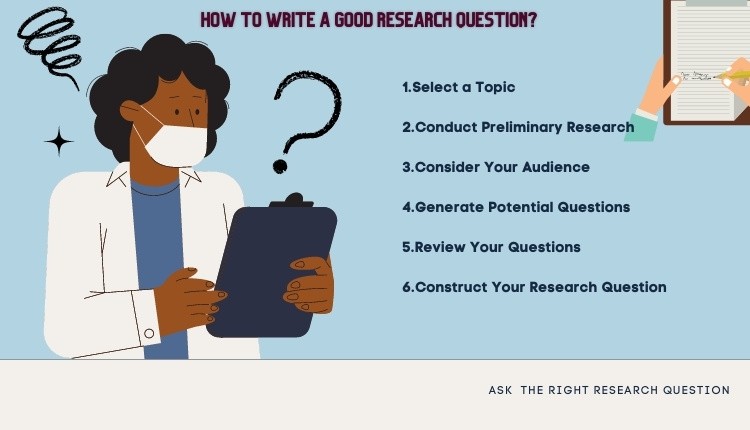
1. Select a Topic
The first step towards writing a good research question is to choose a broad topic of research. You could choose a research topic that interests you, because the complete research will progress further from the research question. Therefore, make sure to choose a topic that you are passionate about, to make your research study more enjoyable.
2. Conduct Preliminary Research
After finalizing the topic, read and know about what research studies are conducted in the field so far. Furthermore, this will help you find articles that talk about the topics that are yet to be explored. You could explore the topics that the earlier research has not studied.
3. Consider Your Audience
The most important aspect of writing a good research question is to find out if there is audience interested to know the answer to the question you are proposing. Moreover, determining your audience will assist you in refining your research question, and focus on aspects that relate to defined groups.
4. Generate Potential Questions
The best way to generate potential questions is to ask open ended questions. Questioning broader topics will allow you to narrow down to specific questions. Identifying the gaps in literature could also give you topics to write the research question. Moreover, you could also challenge the existing assumptions or use personal experiences to redefine issues in research.
5. Review Your Questions
Once you have listed few of your questions, evaluate them to find out if they are effective research questions. Moreover while reviewing, go through the finer details of the question and its probable outcome, and find out if the question meets the research question criteria.
6. Construct Your Research Question
There are two frameworks to construct your research question. The first one being PICOT framework , which stands for:
- Population or problem
- Intervention or indicator being studied
- Comparison group
- Outcome of interest
- Time frame of the study.
The second framework is PEO , which stands for:
- Population being studied
- Exposure to preexisting conditions
- Outcome of interest.
Research Question Examples
- How might the discovery of a genetic basis for alcoholism impact triage processes in medical facilities?
- How do ecological systems respond to chronic anthropological disturbance?
- What are demographic consequences of ecological interactions?
- What roles do fungi play in wildfire recovery?
- How do feedbacks reinforce patterns of genetic divergence on the landscape?
- What educational strategies help encourage safe driving in young adults?
- What makes a grocery store easy for shoppers to navigate?
- What genetic factors predict if someone will develop hypothyroidism?
- Does contemporary evolution along the gradients of global change alter ecosystems function?
How did you write your first research question ? What were the steps you followed to create a strong research question? Do write to us or comment below.
Frequently Asked Questions
Research questions guide the focus and direction of a research study. Here are common types of research questions: 1. Qualitative research question: Qualitative questions concern broad areas or more specific areas of research. However, unlike quantitative questions, qualitative research questions are adaptable, non-directional and more flexible. Different types of qualitative research questions are: i. Exploratory questions ii. Predictive questions iii. Interpretive questions 2. Quantitative Research Question: Quantitative questions prove or disprove a researcher’s hypothesis through descriptions, comparisons, and relationships. These questions are beneficial when choosing a research topic or when posing follow-up questions that garner more information. Different types of quantitative research questions are: i. Descriptive questions ii. Comparative questions iii. Relationship-based questions
Qualitative research questions aim to explore the richness and depth of participants' experiences and perspectives. They should guide your research and allow for in-depth exploration of the phenomenon under investigation. After identifying the research topic and the purpose of your research: • Begin with Broad Inquiry: Start with a general research question that captures the main focus of your study. This question should be open-ended and allow for exploration. • Break Down the Main Question: Identify specific aspects or dimensions related to the main research question that you want to investigate. • Formulate Sub-questions: Create sub-questions that delve deeper into each specific aspect or dimension identified in the previous step. • Ensure Open-endedness: Make sure your research questions are open-ended and allow for varied responses and perspectives. Avoid questions that can be answered with a simple "yes" or "no." Encourage participants to share their experiences, opinions, and perceptions in their own words. • Refine and Review: Review your research questions to ensure they align with your research purpose, topic, and objectives. Seek feedback from your research advisor or peers to refine and improve your research questions.
Developing research questions requires careful consideration of the research topic, objectives, and the type of study you intend to conduct. Here are the steps to help you develop effective research questions: 1. Select a Topic 2. Conduct Preliminary Research 3. Consider Your Audience 4. Generate Potential Questions 5. Review Your Questions 6. Construct Your Research Question Based on PICOT or PEO Framework
There are two frameworks to construct your research question. The first one being PICOT framework, which stands for: • Population or problem • Intervention or indicator being studied • Comparison group • Outcome of interest • Time frame of the study The second framework is PEO, which stands for: • Population being studied • Exposure to preexisting conditions • Outcome of interest
A tad helpful
Had trouble coming up with a good research question for my MSc proposal. This is very much helpful.
This is a well elaborated writing on research questions development. I found it very helpful.
Rate this article Cancel Reply
Your email address will not be published.

Enago Academy's Most Popular Articles

- Industry News
2024 Scholar Metrics for Evaluation of Impact of Research Publications is Released
Google has released its 2024 Scholar Metrics, assessing scholarly articles from 2019 to 2023. This…

- Publishing Research
- Trending Now
- Understanding Ethics
Understanding the Impact of Retractions on Research Integrity – A global study
As we reach the midway point of 2024, ‘Research Integrity’ remains one of the hot…
![what is research question and examples What is Academic Integrity and How to Uphold it [FREE CHECKLIST]](https://www.enago.com/academy/wp-content/uploads/2024/05/FeatureImages-59-210x136.png)
Ensuring Academic Integrity and Transparency in Academic Research: A comprehensive checklist for researchers
Academic integrity is the foundation upon which the credibility and value of scientific findings are…

- Reporting Research
How to Optimize Your Research Process: A step-by-step guide
For researchers across disciplines, the path to uncovering novel findings and insights is often filled…

Breaking Barriers: Sony and Nature unveil “Women in Technology Award”
Sony Group Corporation and the prestigious scientific journal Nature have collaborated to launch the inaugural…
Setting Rationale in Research: Cracking the code for excelling at research
Research Problem Statement — Find out how to write an impactful one!

Sign-up to read more
Subscribe for free to get unrestricted access to all our resources on research writing and academic publishing including:
- 2000+ blog articles
- 50+ Webinars
- 10+ Expert podcasts
- 50+ Infographics
- 10+ Checklists
- Research Guides
We hate spam too. We promise to protect your privacy and never spam you.
- AI in Academia
- Promoting Research
- Career Corner
- Diversity and Inclusion
- Infographics
- Expert Video Library
- Other Resources
- Enago Learn
- Upcoming & On-Demand Webinars
- Peer-Review Week 2023
- Open Access Week 2023
- Conference Videos
- Enago Report
- Journal Finder
- Enago Plagiarism & AI Grammar Check
- Editing Services
- Publication Support Services
- Research Impact
- Translation Services
- Publication solutions
- AI-Based Solutions
- Thought Leadership
- Call for Articles
- Call for Speakers
- Author Training
- Edit Profile
I am looking for Editing/ Proofreading services for my manuscript Tentative date of next journal submission:

In your opinion, what is the most effective way to improve integrity in the peer review process?
Writing Studio
Formulating your research question (rq).
In an effort to make our handouts more accessible, we have begun converting our PDF handouts to web pages. Download this page as a PDF: Formulating Your Research Question Return to Writing Studio Handouts
In a research paper, the emphasis is on generating a unique question and then synthesizing diverse sources into a coherent essay that supports your argument about the topic. In other words, you integrate information from publications with your own thoughts in order to formulate an argument. Your topic is your starting place: from here, you will develop an engaging research question. Merely presenting a topic in the form of a question does not transform it into a good research question.
Research Topic Versus Research Question Examples
1. broad topic versus narrow question, 1a. broad topic.
“What forces affect race relations in America?”
1b. NARROWER QUESTION
“How do corporate hiring practices affect race relations in Nashville?”
The question “What is the percentage of racial minorities holding management positions in corporate offices in Nashville?” is much too specific and would yield, at best, a statistic that could become part of a larger argument.
2. Neutral Topic Versus Argumentative Question
2a. neutral topic.
“How does KFC market its low-fat food offerings?”
2b. Argumentative question
“Does KFC put more money into marketing its high-fat food offerings than its lower-fat ones?”
The latter question is somewhat better, since it may lead you to take a stance or formulate an argument about consumer awareness or benefit.
3. Objective Topic Versus Subjective Question
Objective subjects are factual and do not have sides to be argued. Subjective subjects are those about which you can take a side.
3a. Objective topic
“How much time do youth between the ages of 10 and 15 spend playing video games?”
3b. Subjective Question
“What are the effects of video-gaming on the attention spans of youth between the ages of 10 and 15?”
The first question is likely to lead to some data, though not necessarily to an argument or issue. The second question is somewhat better, since it might lead you to formulate an argument for or against time spent playing video games.
4. Open-Ended Topic Versus Direct Question
4a. open-ended topic.
“Does the author of this text use allusion?”
4b. Direct question (gives direction to research)
“Does the ironic use of allusion in this text reveal anything about the author’s unwillingness to divulge his political commitments?”
The second question gives focus by putting the use of allusion into the specific context of a question about the author’s political commitments and perhaps also about the circumstances under which the text was produced.
Research Question (RQ) Checklist
- Is my RQ something that I am curious about and that others might care about? Does it present an issue on which I can take a stand?
- Does my RQ put a new spin on an old issue, or does it try to solve a problem?
- Is my RQ too broad, too narrow, or OK?
- within the time frame of the assignment?
- given the resources available at my location?
- Is my RQ measurable? What type of information do I need? Can I find actual data to support or contradict a position?
- What sources will have the type of information that I need to answer my RQ (journals, books, internet resources, government documents, interviews with people)?
Final Thoughts
The answer to a good research question will often be the THESIS of your research paper! And the results of your research may not always be what you expected them to be. Not only is this ok, it can be an indication that you are doing careful work!
Adapted from an online tutorial at Empire State College: http://www.esc.edu/htmlpages/writerold/menus.htm#develop (broken link)
Last revised: November 2022 | Adapted for web delivery: November 2022
In order to access certain content on this page, you may need to download Adobe Acrobat Reader or an equivalent PDF viewer software.
- Memberships
Research questions explained plus examples

Research questions: This article provides a practical explanation of the topic of research questions . The article begins with a general definition of the term “research question” and an explanation of the different types of research questions. You will also find several useful tips for developing your own research question and sub-questions, for example, for a thesis or other research project. Enjoy reading!
When conducting research, the research question and sub-questions are essential. The research question reflects the main question of the research, and the sub-questions contribute to answering this main question. Therefore, it is essential to carefully consider the formulation of the questions.
A good research question is concrete, relevant, and well-defined. It should be clear what is being researched and what the purpose of the research is. The sub-questions should match this and should be specific enough to be answered within the research. The sub-questions should also contribute to answering the main question.

Example research question
An example of a research question with sub-questions could be: “How can communication between employees and managers be improved within organization X?” The sub-questions could be:
- What does the current communication structure look like within organization X?
- What are the obstacles to communication between employees and managers?
- What communication tools are currently used, and are they effective?
- What are the best practices for improving communication between employees and managers?
Creating good research questions and sub-questions is important for carrying out a clear and relevant study. By paying sufficient attention to this, the research can be carried out efficiently and effectively, and valuable results can be achieved.
Common types of research questions
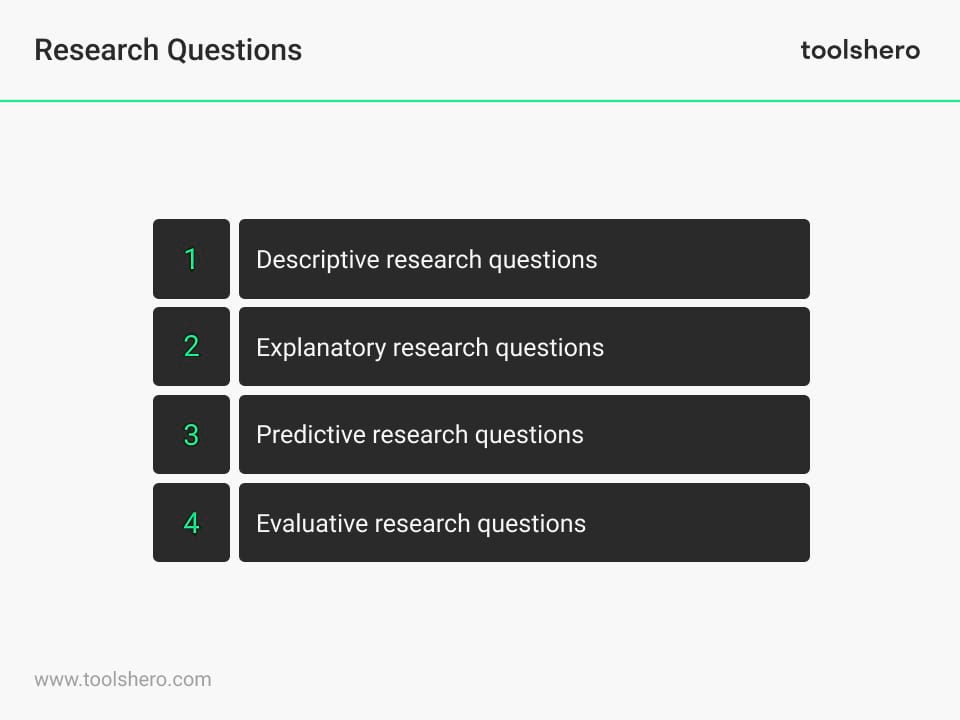
Figure 1 – 4 types of Research questions
1. Descriptive research questions
These questions focus on describing a phenomenon, situation, or population. They are aimed at gathering information about what is going on and what is known about the research topic. An example of a descriptive research question is: “What percentage of students at university X have a part-time job alongside their studies?”
2. Explanatory research questions
These questions focus on finding explanations for a particular phenomenon or situation. They aim to find causal relationships between different variables. An example of an explanatory research question is: “What is the relationship between stress and sleep deprivation among healthcare workers?”
3. Predictive research questions
These questions focus on predicting future events or outcomes based on certain variables or factors. They aim to find patterns and trends that can help make predictions. An example of a predictive research question is: “How much is the sales of product X expected to increase in the coming year?”
4. Evaluative research questions
These questions focus on evaluating the effectiveness or efficiency of a particular intervention, policy, or program. They aim to assess the impact of a particular action or change. An example of an evaluative research question is: “What is the effect of introducing a new teaching method on the academic performance of students?”
It is important to choose the right type of research question that fits the purpose of the research and the research method used. By formulating a clear and specific research question, a researcher can work more effectively and achieve the desired results.
Research Methods For Business Students Course A-Z guide to writing a rockstar Research Paper with a bulletproof Research Methodology! More information
What criteria should a good research question meet?
Below you will find six criteria that a good research question should meet. These criteria are specificity, clarity, relevance, feasibility, significance, and interest.
The research question must be formulated clearly and specifically, so that it is clear what the subject of the research is.
The research question must be relevant to the field and build upon existing knowledge and insights.
The research question must be feasible within the available time, resources, and knowledge of the researcher.
The research question must be verifiable through empirical research or data analysis, so that the results can be objectively evaluated.
The research question must be original and contribute to expanding existing knowledge or developing new insights.
The research question must be challenging and inspiring, so that it motivates the researcher to work hard and perform at a high level.
How to write a good research question?
With the following steps, you can formulate a good research question that is relevant to the field in which you are conducting research.
Step 1: choose a topic
Choose a topic that is relevant to your field and contains keywords that people search for. Use a tool such as Google Keyword Planner to find keywords.
Step 2: prepare
Read literature and articles about the topic and identify gaps in knowledge or conflicting results that are worth further investigation.
Step 3: develop a preliminary research question
Formulate a general preliminary research question based on the findings from the literature. Make sure that this question is clear, concise, and relevant. Use relevant terms in your question.
Step 4: refine
Refine the general question into a specific question that can be answered through empirical research or data analysis. Use clear and simple language, and avoid jargon.
Step 5: check
Check if the question meets the characteristics of a good research question: is the question specific, relevant, feasible, verifiable, original, and inspiring?
Other tips for developing a research question for your thesis
Developing a good research question is essential for a successful thesis. Here are some tips that can help you develop a research question:
Choose a relevant topic
Choose a topic that is relevant to your field of study and that you are passionate about. This will increase your motivation and help you make a meaningful contribution to your field.
Determine the purpose of your research
Ask yourself what you want to achieve with your research. Do you want to discover a new problem, solve an existing problem, or introduce a new concept? Be specific Make sure that your research question is specific and not too broad. It should have a clear purpose and focus on a limited topic.
Use clear language
Make sure that your research question is clear and understandable to others. Avoid jargon and technical terms, unless they are necessary for the context of your research.
Make it measurable
Ensure that your research question is measurable, so that you can evaluate and analyze the results of your research.
Consider data availability

Now it’s your turn
What do you think? Do you recognize the explanation about research questions? Have you often worked with research questions? Like during the process of writing your thesis or another type of research? Do you find the tips and recommendations in this article helpful? Do you have other tips or comments?
Share your experience and knowledge in the comments box below.
More information
- Agee, J. (2009). Developing qualitative research questions: A reflective process . International journal of qualitative studies in education, 22(4), 431-447.
- Andrews, R. (2003). Research questions . Bloomsbury Publishing .
- Barick, R. (2021). Research Methods For Business Students . Retrieved 02/16/2024 from Udemy.
- Dillon, J. T. (1984). The classification of research questions . Review of Educational Research, 54(3), 327-361.
- White, P. (2017). Developing research questions. Bloomsbury Publishing.
How to cite this article: Janse, B. (2023). Research questions . Retrieved [insert date] from Toolshero: https://www.toolshero.com/research/research-questions/
Original publication date: 05/12/2023 | Last update: 01/02/2024
Add a link to this page on your website: <a href=”https://www.toolshero.com/research/research-questions/”>Toolshero: Research questions</a>
Did you find this article interesting?
Your rating is more than welcome or share this article via Social media!
Average rating 4.2 / 5. Vote count: 5
No votes so far! Be the first to rate this post.
We are sorry that this post was not useful for you!
Let us improve this post!
Tell us how we can improve this post?

Ben Janse is a young professional working at ToolsHero as Content Manager. He is also an International Business student at Rotterdam Business School where he focusses on analyzing and developing management models. Thanks to his theoretical and practical knowledge, he knows how to distinguish main- and side issues and to make the essence of each article clearly visible.
Related ARTICLES

Anita Elberse biography, quotes and publications

Meta Analysis: definition, meaning and steps to conduct

Mystery Shopping: the Basics and Variables

Conceptual framework: the Basics and an Example

Respondents: the definition, meaning and the recruitment

Market Research: the Basics and Tools
Also interesting.

Univariate Analysis: basic theory and example

Bivariate Analysis in Research explained

Contingency Table: the Theory and an Example
Leave a reply cancel reply.
You must be logged in to post a comment.
BOOST YOUR SKILLS
Toolshero supports people worldwide ( 10+ million visitors from 100+ countries ) to empower themselves through an easily accessible and high-quality learning platform for personal and professional development.
By making access to scientific knowledge simple and affordable, self-development becomes attainable for everyone, including you! Join our learning platform and boost your skills with Toolshero.

POPULAR TOPICS
- Change Management
- Marketing Theories
- Problem Solving Theories
- Psychology Theories
ABOUT TOOLSHERO
- Free Toolshero e-book
- Memberships & Pricing
- Solutions Industry Gaming Automotive Sports and events Education Government Travel & Hospitality Financial Services Healthcare Member Experience Technology Use case NPS+ Communities Audience InsightsHub InstantAnswers Digsite LivePolls Journey Mapping GDPR Positive People Science 360 Feedback Surveys Research Edition
- Resources Blog eBooks Survey Templates Case Studies Training Webinars Help center
Research Questions: Types and Research Question Examples
The complete guide to research questions, including examples and sample research questions.
Research questions are critical components of any scientific investigation, guiding researchers toward focused preliminary research and assisting them in producing significant results. They provide a clear direction and purpose for the research paper and serve as the cornerstone.
In this article, we will discuss the significance of research questions and present 27 examples from diverse fields to demonstrate their variety and application.
What are the research questions?
Research questions are defined as fundamental questions that facilitate a research project, a research study, a dissertation, a thesis, or a review. It allows researchers to collect relevant information to narrow the study's purpose and solve the research problem.
Asking appropriate research questions is the most crucial step in market research projects. You can use the insights from your own research questions to determine the path of the study. These insights also play an essential role in conducting a survey, analyzing obtained data, and reporting the analyzed information.
Choosing the right research questions helps you decide whether qualitative and quantitative research methods are best. The main objective of your research and the research theme define the type of qualitative or quantitative research questions you use.
The target audience and kind of research you're conducting also play significant roles. Below are a few research question ideas and good research question examples.
27 Research questions examples
To develop research questions for your academic research or marketing study, you must understand the types of questions available. Let's look at examples of research questions and sample research questions in general. Use these existing methods or research question examples to build beautiful surveys.
01. Open-ended research question
Open-ended questions are widely used in qualitative research and are common examples of qualitative research questions. Open-ended questions capture open responses from a research audience and open the door for text-based analysis of the data you receive.
This type of question forms the foundation of online qualitative research conducted using surveys and questionnaires.
Below is an example of an open-ended research question:

02. Multiple choice research question
Researchers use multiple-choice research questions to capture single or multiple responses from your research audience. They typically use these market research questions when conducting poll-based research, where the audience needs to select multiple responses to one problem. It can also be used with single-select answers to limit the number of answers a respondent can choose.
Below is an example of a multiple-choice research question with a single-select answer option:

03. Rank order scaling research question
This is a ranking-type question that offers multiple answer options. The participant selects answers in order of preference. Researchers usually use these research questions to understand respondents' opinions on preferred brands or products.
You can use data from rank order questions to determine which product a respondent prefers, even if they enjoy multiple products. For example, someone may like chocolates, cakes, and candy, but which do they like the most?
Rank-order scaling questions are the right research questions to determine which dessert is most loved by the respondent.
Below is a typical example of rank order:

04. Rating scale research question
Rating scale research questions capture responses based on a continuous scale rather than individual points. It is often used in medical research visual analog scales or pain scales, where patients need to rate their pain level. Another example would be a typical experience-based rating scale, like the example below.

05. Net promoter score question
Brands typically use a Net Promoter Score question to evaluate customer loyalty and brand recommendations. This question type is prevalent in consumer research, where this single question can provide numeric insights into the customer experience.
The data collected from Net Promoter Score questions allows you to see how many of your brand's followers are actively promoting your brand. You also get insight into how many are actively not recommending your products. For example, respondents answer this question on a scale of 0-10:

As per their rankings, respondents are classified under either of the three groups: Detractors (0-6), Passives (7-8), and Promoters (9-10).
06. Likert scale research question
The Likert scale question presents a psychometric scale with different answer options such as agree/disagree, very frequently/not very often, important/unimportant, and other similar polarizing nature questions. Generally divided into even and odd Likert scale questions, they are highly popular with researchers due to the accuracy of their results.

07. Semantic differential scale research question
A semantic differential scale question quantifies the feelings and opinions of a respondent. This question type uses a multiple-point rating scale to understand better the respondent's feelings on a particular service, brand, organization, or product. The scale features polarized opinions on either end, with a neutral option in the middle.

08. Stapel scale research question
It is a unipolar research question with a +5 to -5 rating scale for the respondents to rate a single factor. These questions often involve offering the respondent an adjective or trait in conjunction with a brand or product. The respondent uses the scale to determine whether the attribute accurately or inaccurately describes the brand, product, or organization.

09. Constant sum research question
A numeric answer question allows a researcher to collect ratio data about the answer options' factors. Respondents can assign a particular value to an entity, and the other entities can be comparatively rated.

10. Demographic research question
Demographic questions are based on a person's age, gender, family income, race, ethnicity, education, and other defining factors. Research about whether a specific product will be effective with a particular age or gender group can be carried out using demographic research questions.

11. Matrix table research question
It is a multiple-choice, close-ended question where multiple parameters are rated using the same column answer options. Matrix questions work similarly to any other scale questions but allow for more efficient use of space. Instead of asking five questions about the quality of different customer experiences, you can use just one question to capture the data.

12. Side-by-side matrix research question
Side-by-side matrix research questions allow the respondent to rate multiple variables at once. Like a single matrix, these research questions will enable you to compact your survey. However, you mustn't overload respondents with too many matrix questions, as they require more thought to answer. It can lead to high dropout rates.

13. Static content question
This question is an option for the researchers to include descriptive research questions such as presentation text, heading, or subheading. Static content isn't technically a question, as it is used for display purposes only. Instead, your static content can provide participants with important information about a section or your survey.

14. Miscellaneous question
Miscellaneous questions allow you to ask questions that don't fit into another category. Some types of demographic or categorizing questions are best used as miscellaneous questions.

15. Visual analog scale question
A visual analog scale is used to analyze pain levels among patients and generally evaluate characteristics across a constant range of values. It gives a picture or graphic that depicts various feelings on a scale. The respondent uses the images to help determine where they fall on the scale.

16. Image chooser-type question
Images are perfect tools to enhance user experience and, in turn, increase response rates for research. Image research questions help make your survey more visually appealing while decreasing the time a respondent needs to answer a question. Using select one, select many, or image rating matrix question options prompts several respondents to reply to the research survey.

17. Data reference question
Reference data research questions are used to accumulate or approve zip code data against standardized data.

18. Upload data question
Respondents can upload images, digital signatures, or videos with their research responses. Upload data questions are the right research questions for collecting signatures or accepting submissions.

19. Choice model question
Conjoint analysis and Maximum Difference questions fall under the category of choice model research questions. Conjoint analysis is used to understand respondent preferences about two or more entities. Maximum Difference is used to rate up to 30 factors such as features, interests, the scope of improvement, or the potential positioning of an upcoming product.

20. Dichotomous research question
These question types have Yes/No/Maybe, True/False, and Agree/Disagree answer options. Using them extensively in research is not advised due to the limited insights received.

21. Leading research question
A leading question is a market research question that pushes respondents to answer a particular question in a specific manner based on how they are framed. Leading questions often already contain information that the survey creator wants to confirm rather than try to get a correct and unbiased answer to that question.
22. Text slider research question
A text slider research question is a rating scale question type that uses an interactive slider to select the most appropriate option. Rating scales are often used to measure the direction and intensity of attitudes. The scale is well-defined and increases at an equal rate.

23. Push to the social research question
Push to social research questions allows respondents to share positive reviews or feedback on social media sites like Facebook and Twitter. This question creates a positive feeling about your brand on social media. Alternatively, this can be effectively used to collect and address negative feedback before it goes out on social media.
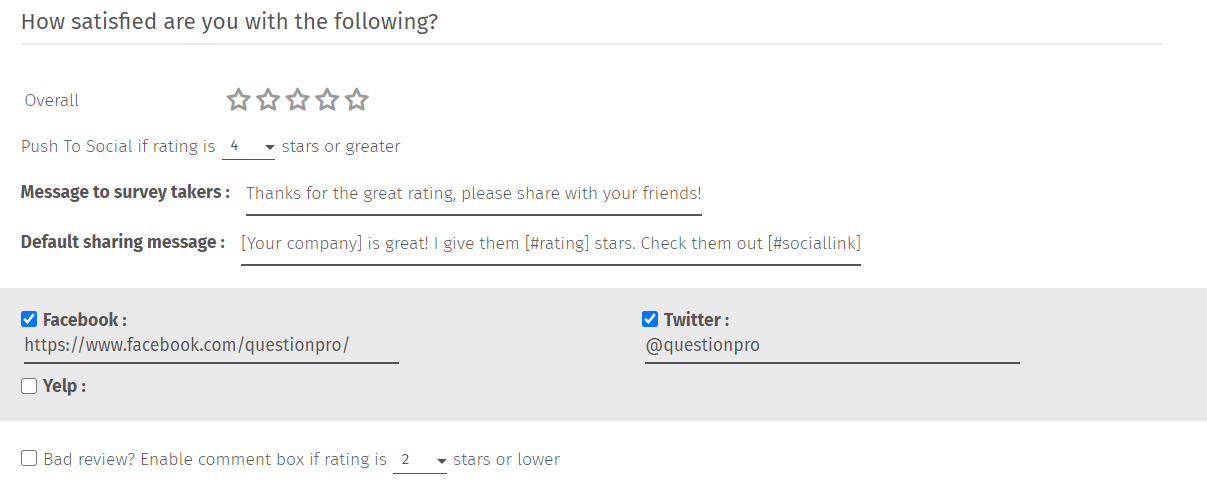
24. Max diff research question
Max Diff is a question type where respondents are given a set of attributes and asked to indicate the best and worst. In this research question type, there is only one of each option in the final response. For example, if a bank wants to understand payment merchants' preferences, the question can be asked in the following format.

25. Van Westendorp-price sensitivity research Question
The Van Westendorp-Price Sensitivity is a technique for market researchers to gauge consumer perceptions of products or services' value. It helps in understanding the need to tweak the price and offering. For example, if a software product manufacturer wants to know how to price a product, the following question could be asked:

26. Date/time research question
The date/Time research question type allows for collecting date/time information filled in by a respondent. For example, the following question can answer questions about the date of birth.

27. CAPTCHA research question
This research question type limits the number of phony responses in a survey or data collection by automated computer programs.

Importance of using the right research questions
When a research program is initiated, it requires a channel to accurately collect data for the study. Research questions form this channel and help a researcher to kick-start the research.
As the research continues, these questions are molded according to the original insights, which shape a practical study. Your first research questions may not be the final step in the research process, but they are the first to build your research hypothesis.
The importance of research questions can be highly subjective. For some researchers, formulating research questions might be necessary because they provide insights into essential decision-making factors.
Or example, a focused research question could give you vital data about funding needs or how to find the right resources to reach business goals.
How to write a research question to capture accurate information
What are the good research questions? Specific research questions are much more useful than template questions. Follow these six steps to learn how to write questions for research:
- Select a broad research topic that interests the target audience: You must choose an intriguing topic to target respondents. Interesting research topics encourage respondents to complete the survey on time. The problem should be vague enough that you can create plenty of the right research questions. You don't want your topic to be so specific that you can't produce enough questions to gather the needed data.
- Conduct rough research on your topic: Conduct primary research to analyze what information is available and what can be explored. This way, you can decide which case is most likely to achieve the best results based on what data is not currently available.
- Keep the target audience in mind: You must keep your target audience in mind and slowly narrow your research to a topic that caters to a particular set of people. It will help gather precise research information to make products and services customer-centric and boost your business.
- Frame appropriate questions: Draft a research questionnaire with open-ended and closed-ended questions to help you get the necessary information. You can use question framing to help you get the most information out of a respondent. For example, offer an open-ended and closed-ended questions about one particular product next to one another in your survey.
- Analyze these research questions: Once the questions are framed and ready to be sent out, you must analyze the questions' effectiveness. If there is room for improvement, these questions need to be revisited and reframed.
- Brainstorm the possible outcomes: After creating appropriate questions, you can map out your questions' potential responses. What types of answers are you expecting? Will they support your current plan? If not, what changes can you make to serve customers better based on their responses? This step helps prepare everyone involved in the survey and data analysis of a potential plan of action based on the study's top possible outcomes.
Three points to remember while writing research questions: Ordering your questions is vital to give a sense of flow to the survey. Always rank your items from simple concepts to more complex ones. Here are tips on how to write a research question.
- Right research questions start with a problem that needs to be solved.
- Research questions must be engaging enough for customers or employees to invest their time. At the same time, your questions need to provide data that can actually be used to better your brand or organization.
- Your questions should be straightforward to understand. It helps keep respondents engaged while also collecting the most accurate answers. If a respondent doesn't understand a problem, they may back out of the survey or choose an answer randomly.
What are examples of good research questions?
Clear, specific, pertinent, and capable of producing new knowledge with existing knowledge or insights are all characteristics of good research questions. Here are a few examples of good research questions from many disciplines:
- Question: What specifications would you like us to launch with our next mobile phone? The reason why it is a good research question: The question asks about a specific product. It will give respondents room to explain what they expect from an upcoming product.
- Question: What steps do you suggest to tackle the current situation of world poverty? The reason why it is a good research question: This question is simply put in practical terms so that the respondents can reply honestly to this open-ended question.
- Question: Among all our products, which one do you think is the most successful? The reason why it is a good research question: By asking respondents which product they think is most successful, you gain valuable insight into the perception of your various products.
- Question: How can online users deal with trolls on social networking websites? The reason why it is a broad research question: These are focused research questions that are well-constructed and understandable.
- Question: As a customer, what qualities in an organization appeal to you, and what can be done to make you stay loyal? The reason why it is a broad research question: The reason why it is a good research question: This question is complicated yet conveys the message.
It is important to ensure that research questions are specific, relevant, and attainable. Researchers can then begin with relevant questions that have the potential to make significant improvements to their respective professions.
CREATE, SEND & ANALYZE YOUR ONLINE SURVEY COMPLETELY FREE
- Sample questions
- Sample reports
- Survey logic
- Integrations
- Professional services
- Survey Software
- Customer Experience
- Communities
- Polls Explore the QuestionPro Poll Software - The World's leading Online Poll Maker & Creator. Create online polls, distribute them using email and multiple other options and start analyzing poll results.
- Research Edition
- InsightsHub
- Survey Templates
- AI in Market Research
- Quiz Templates
- Qualtrics Alternative Explore the list of features that QuestionPro has compared to Qualtrics and learn how you can get more, for less.
- SurveyMonkey Alternative
- VisionCritical Alternative
- Medallia Alternative
- Likert Scale Complete Likert Scale Questions, Examples and Surveys for 5, 7 and 9 point scales. Learn everything about Likert Scale with corresponding example for each question and survey demonstrations.
- Conjoint Analysis
- Net Promoter Score (NPS) Learn everything about Net Promoter Score (NPS) and the Net Promoter Question. Get a clear view on the universal Net Promoter Score Formula, how to undertake Net Promoter Score Calculation followed by a simple Net Promoter Score Example.
- Offline Surveys
- Customer Satisfaction Surveys
- Employee Survey Software Employee survey software & tool to create, send and analyze employee surveys. Get real-time analysis for employee satisfaction, engagement, work culture and map your employee experience from onboarding to exit!
- Market Research Survey Software Real-time, automated and advanced market research survey software & tool to create surveys, collect data and analyze results for actionable market insights.
- GDPR & EU Compliance
- Employee Experience
- Customer Journey
- Executive Team
- In the news
- Testimonials
- Advisory Board
QuestionPro in your language
- Encuestas Online
- Pesquisa Online
- Umfrage Software
- برامج للمسح
Awards & certificates
The experience journal.
Find innovative ideas about Experience Management from the experts
- © 2021 QuestionPro Survey Software | +1 (800) 531 0228
- Privacy Statement
- Terms of Use
- Cookie Settings
Run a free plagiarism check in 10 minutes, automatically generate references for free.
- Research process
Published on 30 October 2022 by Shona McCombes . Revised on 12 December 2023.

How to write a research question, what makes a strong research question, research questions quiz, frequently asked questions.
| Research question formulations | |
|---|---|
| Describing and exploring | |
| Explaining and testing | |
| Evaluating and acting |
| Example research problem | Example research question(s) |
|---|---|
| Teachers at the school do not have the skills to recognize or properly guide gifted children in the classroom. | What practical techniques can teachers use to better identify and guide gifted children? |
| Young people increasingly engage in the ‘gig economy’, rather than traditional full-time employment. However, it is unclear why they choose to do so. | What are the main factors influencing young people’s decisions to engage in the gig economy? |
Prevent plagiarism, run a free check.
| Criteria | Explanation |
|---|---|
| Focused on a single topic | Your central research question should work together with your research problem to keep your work focused. If you have multiple questions, they should all clearly tie back to your central aim. |
| Answerable using | Your question must be answerable using and/or , or by reading scholarly sources on the topic to develop your argument. If such data is impossible to access, you likely need to rethink your question. |
| Not based on value judgements | Avoid subjective words like , , and . These do not give clear criteria for answering the question. |
| Criteria | Explanation |
|---|---|
| Answerable within practical constraints | Make sure you have enough time and resources to do all research required to answer your question. If it seems you will not be able to gain access to the data you need, consider narrowing down your question to be more specific. |
| Uses specific, well-defined concepts | All the terms you use in the research question should have clear meanings. Avoid vague language, jargon, and too-broad ideas. |
| Does not demand a conclusive solution, policy, or course of action | Research is about informing, not instructing. Even if your project is focused on a practical problem, it should aim to improve understanding rather than demand a ready-made solution. |
| Criteria | Explanation |
|---|---|
| Cannot be answered with or | Closed-ended, / questions are too simple to work as good research questions—they don’t provide enough scope for robust investigation and discussion. |
| Cannot be answered with easily-found facts | If you can answer the question through a single Google search, book, or article, it is probably not complex enough. A good research question requires original data, synthesis of multiple sources, and original interpretation and argumentation prior to providing an answer. |
A research paper designed to present the results of empirical research tends to present a research question that it seeks to answer. It may also include a hypothesis – a prediction that will be confirmed or disproved by your research.
An essay isn’t just a loose collection of facts and ideas. Instead, it should be centered on an overarching argument (summarised in your thesis statement ) that every part of the essay relates to.
The way you structure your essay is crucial to presenting your argument coherently. A well-structured essay helps your reader follow the logic of your ideas and understand your overall point.
A research hypothesis is your proposed answer to your research question. The research hypothesis usually includes an explanation (‘ x affects y because …’).
A statistical hypothesis, on the other hand, is a mathematical statement about a population parameter. Statistical hypotheses always come in pairs: the null and alternative hypotheses. In a well-designed study , the statistical hypotheses correspond logically to the research hypothesis.
If you want to cite this source, you can copy and paste the citation or click the ‘Cite this Scribbr article’ button to automatically add the citation to our free Reference Generator.
McCombes, S. (2023, December 12). Writing Strong Research Questions | Criteria & Examples. Scribbr. Retrieved 22 July 2024, from https://www.scribbr.co.uk/the-research-process/research-question/
Other students also liked, how to write a research proposal | examples & templates, how to write a results section | tips & examples, what is a research methodology | steps & tips.

In order to continue enjoying our site, we ask that you confirm your identity as a human. Thank you very much for your cooperation.
- Research Paper Guides
- Basics of Research Paper Writing
- How to Write a Research Question: Types & Examples
- Speech Topics
- Basics of Essay Writing
- Essay Topics
- Other Essays
- Main Academic Essays
- Research Paper Topics
- Miscellaneous
- Chicago/ Turabian
- Data & Statistics
- Admission Writing Tips
- Admission Advice
- Other Guides
- Student Life
- Studying Tips
- Understanding Plagiarism
- Academic Writing Tips
- Basics of Dissertation & Thesis Writing
- Essay Guides
- Formatting Guides
- Basics of Research Process
- Admission Guides
- Dissertation & Thesis Guides
How to Write a Research Question: Types & Examples

Use our free Readability checker
A research question is the main query that researchers seek to answer in their study. It serves as the basis for a scholarly project such as research paper, thesis or dissertation. A good research question should be clear, relevant and specific enough to guide the research process. It should also be open-ended, meaning that it allows for multiple possible answers or interpretations.
If you have located your general subject and main sources but still aren’t quite sure about the exact research questions for your paper, this guide will help you out. First, we will explore the concept of it together, so you could answer it in your work. Then some simple steps on composing your inquiry will be suggested. In the end, we will draw your attention to some specific details which can make your work good or bad. Sometimes it’s just easier to delegate all challenging tasks to a reliable research paper service . StudyCrumb is a trustable network of qualified writers ready to efficiently solve students’ challenges.
What Is a Good Research Question: Full Definition
Good research questions provide a concise definition of a problem. As a scholar, your main goal at the beginning is to select the main focus. It should be narrow enough so you could examine it within your deadline. Your work should be focused on something specific. Otherwise, it will require too much work and might not produce clear answers. At the same time your answer should be arguable and supported by data you’ve collected. Take a look at this example:

How to Write a Research Question: Step-By-Step Guide
In this section we will examine the process of developing a research question. We will guide you through it, step by step. Keep in mind that your subject should be important for your audience. So it requires some preliminary study and brainstorming. Let’s take a closer look at the main steps.
Step 1. Choose a Broad Topic for Your Research Paper Question
First, you need to decide on your general direction. When trying to identify your research paper questions, it is better to choose an area you are really interested in. You should be able to obtain enough data to write something about this topic. Therefore, do not choose something out of your reach. At the same time, your broad topic should not be too simple. Research paper questions that can be answered without any study would hardly make any sense for your project.
Step 2. Do Preliminary Reading Before Starting Your Research Question
Next, it is time we explore the context of the selected topic. You wouldn’t want to choose research questions that have already been examined and answered in detail. On the other hand, choosing a topic that is a complete ‘terra incognita’ might be a bridge too far for your project. Browse through available sources that are related to this topic. You should try and find out what has been discovered about it before. Do you see a gap that you can fill with your study? You can proceed with developing your exact inquiry! Have no time for in-depth topic exploration? Leave this task to professionals. Entrust your “ write my research paper ” order to StudyCrumb and get a top-notch work.
Step 3. Consider an Audience for Your Research Question
It is good to know your reader well to be able to convey your ideas and results to them in the best possible way. Before writing research questions for your projects, you might need to perform a brief analysis of your audience. That's how you'll be able to understand what is interesting for them and what is not. This will allow you to make better decisions when narrowing your broad topic down. Select a topic that is interesting for your reader! This would contribute much to the success for writing a research paper .
Step 4. Start Asking a Good Research Question
After you have considered your options, go ahead and compose the primary subject of your paper. What makes a good research question? It should highlight some problematic and relevant aspects of the general topic. So, after it is answered, you should have obtained some new valuable knowledge about the subject. Typically scholars start narrowing down their general topic by asking ‘how’, ‘why’ or ‘what’s next’ questions. This approach might help you come up with a great idea quickly.
Step 5. Evaluate Your Research Question
Finally, after you have composed a research paper question, you should take a second look at it and see if it is good enough for your paper. It would be useful to analyze it from the following sides:
- Is it clear for your audience?
- Is it complex enough to require significant study?
- Is it focused on a certain aspect of your general topic?
You might use the help of your peers or your friends at this step. You can also show it to your tutor and ask for their opinion.
Types of Research Questions: Which to Choose
A number of research questions types are available for use in a paper. They are divided into two main groups:
Qualitative questions:
- Explanatory
- Ethnographic
Quantitative questions:
- Descriptive
- Comparative
- Relationship based.
Selecting a certain type would impact the course of your study. We suggest you think about it carefully. Below you can find a few words about each type. Also, you can seek proficient help from academic experts. Buy a research paper from real pros and forget about stress once and for all.
Qualitative Research Questions: Definition With Example
When doing qualitative research, you are expected to aim to understand the different aspects and qualities of your target problem. Therefore, your thesis should focus on analyzing people’s experience, ideas and reflections rather than on obtaining some statistical data and calculating trends. Thus, this inquiry typically requires observing people’s behavior, interacting with them and learning how they interpret your target problem. Let’s illustrate this with an example:

What Is Contextual Research Questions
Contextual research revolves around examining your subject in its natural, everyday environment. It may be watching animals living in their usual habitats or people doing their normal activities in their familiar surroundings (at home, at school or at office). This academic approach helps to understand the role of the context. You'll be able to better explain connections between your problem, its environment and outcomes. This type of inquiry ought to be narrow enough. You shouldn’t have to examine each and every aspect of the selected problem in your paper. Consider this example:

Definition and Sample of Evaluative Research Questions
Evaluative research is performed in order to carefully assess the qualities of a selected object, individual, group, system or concept. It typically serves the purpose of collecting evidence that supports or contradicts solutions for a problem. This type of inquiry should focus on how useful a certain quality is for solving the problem. To conduct such study, you need to examine selected qualities in detail. Then, you should assume whether they match necessary criteria. It might include some quantitative methods such as collecting statistics. Although, the most important part is analyzing the qualities. If you need some examples, here’s one for you:

Explanatory Research Questions: Definition With Example
Your paper can be dedicated to explaining a certain phenomenon, finding its reasons and important relationships between it and other important things. Your explanatory research question should aim to highlight issues, uncertainties and problematic aspects of your subject. So, your study should bring clarity about these qualities. It should show how and why they have developed this way. An explanation may include showing causes and effects of issues in question, comparing the selected phenomenon to other similar types and showing whether the selected qualities match some predefined criteria. If you need some examples, check this one:

Generative Research Questions
This type of research is conducted in order to better understand the subject. With its help, you can find some new solutions or opportunities for improvement. Therefore, its main purpose is to develop a theoretical basis for further actions. You need to compose your generative research questions in a way that facilitates obtaining new ideas. It would help to begin with asking ‘why’, ‘what is the relationship between the subject and the problems X, Y, and Z’, ‘what can be improved here’, ‘how we can prevent it’ and so on. Need relevant examples? We’ve got one for you:

Ethnographic Research Question
Ethnography research is focused on a particular group of people. The aim is to study their behavior, typical reactions to certain events or information, needs, preferences or habits. Important parameters of this group which are most relevant to your general subject are taken into consideration. These are age, sex, language, religion, ethnicity, social status and so on. Main method in this case is first-hand observation of people from the selected group during an extended period of time. If you need strong examples, here’s one:

Quantitative Research Questions: Full Definition With Examples
Quantitative research deals with data – first of all, it is numeric data. It involves mathematical calculations and statistical analysis. It helps to obtain knowledge which is mostly expressed in numbers, graphs and tables. Unlike the qualitative type, the purpose of quantitative research is finding patterns, calculating probabilities, testing causal relationships and making predictions. It is focused on testing theories and hypotheses. (We have the whole blog on what is a hypothesis .) It is mostly used in natural and social sciences. These are: chemistry, biology, psychology, economics, sociology, marketing, etc. Here are a couple of examples:

Descriptive Research Questions: Definition With Example
This is probably the most widespread type of quantitative research question. Such inquiries seek to explain when, where, why, or how something occurred. They describe it accurately and systematically. These inquiries typically start with ‘what’. You are expected to use various methods to investigate one or more variables and determine their dependencies. Note, however, that you cannot control or manipulate any of these variables. You can only observe and measure them. Looking for some interesting examples? Here is one:

Definition of Comparative Research Questions
Comparative research question is used to highlight different variables and provide numerical evidence. This type is based on comparing one object, parameter or issue with another one of a similar kind. It can help to discover the differences between two or more groups by examining their outcome variables. Take a look at these two examples:

Relationship Research Questions
We conduct this type of research when we need to make it clear whether one parameter of a selected object causes another one. A relationship based quantitative research question should help us to explore and define trends and interactions between two or more variables. Are these two things mutually dependent? What kind of dependence is it? How has it developed? And what are possible outcomes of this connection? Here is an example of relationship-based quantitative research questions:

Research Questions Examples: Free
This section contains a number of helpful examples of research questions. Feel free to use them as inspiration to create your own questions and conduct productive study. Let’s start with two simple ones:

Are you interested in well written and inspiring questions? Do you want to learn what to avoid in your study? Just stay with us – there will be more of them below.
Examples of Good and Bad Research Questions
Everyone is interested in getting the best possible appraisal for their study. Choosing a topic which doesn't suit your specific situation may be discouraging. Thus, the quality of your paper might get affected by a poor choice. We have put together some good and bad examples so that you could avoid such mistakes.
Good Research Questions Examples
It is important to include clear terms into your questions. Otherwise, it would be difficult for you to plan your investigation properly. Also, they must be focused on a certain subject, not multiple ones. And finally, it should be possible to answer them. Let’s review several good examples:

Examples of Bad Research Questions
It is difficult to evaluate qualities of objects, individuals or groups if your purpose is not clear. This is why you shouldn’t create unclear research questions or try to focus on many problems at once. Some preliminary study might help to understand what you should focus on. Here are several bad examples:

In case you may need some information about the discussion section of a research paper example , find it in our blog.
Final Thoughts on Research Questions
In this article we have made a detailed review of the most popular types of research questions. We described peculiarities. We also provided some tips on conducting various kinds of study. Besides, a number of useful examples have been given for each category of questions.
Feel free to check out essay writing services. We have experienced writers who can help you compose your paper in time. They will absolutely ensure the high quality of your text.
Frequently Asked Questions About Research Questions
1. what is an example of a weak research question.
Here is an example of the weakest research question:
An answer would be simply making a list of species that inhabit the country. This subject does not require any actual study to be conducted. There is nothing to calculate or analyze here.
2. What is the most effective type of research question?
Most effective type of research question is the one that doesn't have a single correct answer. However, you should also pay close attention to your audience. If you need to create a strong effect, better choose a topic which is relevant for them.
3. What is a good nursing research question?
If you need an idea for a nursing research question, here are a few helpful examples you could use as a reference:
4. What are some sociological research questions?
Sociological questions are the ones that examine the social patterns or a meaning of a social phenomenon. They could be qualitative or quantitative. They should target groups of people with certain parameters, such as age or income level. Keep in mind that type of study usually requires collecting numerous data about your target groups.

Joe Eckel is an expert on Dissertations writing. He makes sure that each student gets precious insights on composing A-grade academic writing.
You may also like

What kinds of animals live in the USA? |
How do you analyze the development of telehealth? |
How to evaluate critical care nursing? |
What are some cardiovascular issues? |

99 Good Sociology Research Questions Examples
What is a good research question for sociology? Oftentimes, lecturers give their students the freedom to pick their own research questions. While this can be a good thing on its own, at other times, it can drain the brain. Having relevant sociology research question ideas and sociology research questions examples is the right way to start. In this article, you will be receiving 99 sociology research questions examples to help you avoid a brain drain.
Sociology Research Question Topics
- What are the Environmental Hazards in Your Society?
- What is the Government’s Control of Society?
- What are the Impacts of Cancel Culture in Today’s Society?
- How Early Should Children be Taught Sex Education?
- What Prevention Methods are Effective Against Teenagers Pregnancy?
- Should Parents Encourage Their Teenagers to Get an Abortion?
- Is Gender Equality Possible?
- Why Is Polygamy Ideal For 21st Century Relationships?
- What Role Can Parents Play To Help Prevent Sexually Transmitted Infections In Their Teens?
- Is Marriage Relevant in the 21st-century?
- What Are Transactional Relationships?
- What are the Effects of Having Two Mothers?
- How Can Schools Help Students Overcome Addiction?
- What Can Schools do About Deviant Behaviour in Their Children?
- What are the Steps to Overcoming Abuse?
- What are the Impacts of Having Two Fathers?
- How Does Family Law Help the Family?
- Why Should Children Take Over Family Businesses?
- Why Should The Use of Marijuana Be Legalized?
- What are the Roles of Grandparents in a Family?
- What are the Impacts of Endogamy?
- What is the Permanent Solution to Bullying?
- Body Confidence Or Moral Decadence?
- How Can Interpersonal Conflicts be Resolved?
- What is Family Inheritance?
- Do Vacations Truly Help Couples Bond?
- What are the Impacts of House-husband?
- What are the Impacts of Being A Housewife?
- Should Polygamy be Encouraged in Today’s Society?
- What are the Dangers of Helicopter Parenting?
- When Should a Couple Consider Divorce?
- What are the Underlying Reasons for Suicide in Young People?
- What are the Societal Implications of Cohabitation?
- What Causes Rebellion in Young People?
- What Ways Can Depression be Managed?
- Should Free Speech Have Limits?
- What is Societal Pressure?
- What is the Relevance of Religion in Today’s Society?
- Why is Medical Negligence on the Rise?
- What is the Relevance of School Uniforms For Students?
- What are the Conflicts of Personal Identity?
- Should Prisoners be Allowed to Vote?
- Do School Uniforms Encourage Bullying?
- Should Children Have Parents of the Same-Sex?
- What is Social Disorder?
- What is Social Anxiety?
- What are the Dangers of Home Schooling?
- What are the Dangers of Infidelity to the Society at Large?
- What are the Dangers of Political Correctness?
- Should Traditional Gender Roles Still Exist in Today’s Society?
- Do Adults Engage in Bullying More Than Children?
- What are the Different Places Bullying Occurs in Today’s Society?
- Should Virtual Learning Become the Standard Form of Learning?
- Should Religious Activities be Allowed in Schools?
- How Can a Family Maintain a Healthy Lifestyle?
- How Does the Media Portray Your Society?
- Why do Students Dress the Way do?
- Whose Responsibility is it to Train the Child: Parents or Society?
- Should Children be Allowed to Believe in Magic?
- What Causes Social Isolation?
- Should Teens Be Allowed to Take Alcohol?
- What are the Impacts of Single Parenting?
- What is the Attitude Of Students Towards School Work in Your Society?
- What Bad Actions Contribute to Pollution in Your Environment?
- What Societal Values are Dying?
- Should Teachers Have Other Sources Of Income?
- What is Care-work in a Family?
- Does a Person’s Society Determine How They See Life?
- What is the “Standard Family”?
- How do Songs Contribute to a Person’s Identity?
- What Are The Underlying Causes Of Unemployment in Your Society?
- Should Parents Take Parenting Classes?
- What Are Societal Values and Norms?
- What are the Impacts Of Divorce on the Children?
- What are the Impacts of Long-distance Marriage?
- Should Personal Ownership of Guns be Revoked in the United States?
- What are the Impacts of Moving Places?
- What is the Difference Between Equality and Equity?
- Is Reincarnation After Death A Possibility?
- How Should Errant Behaviour be Punish?
- What Are The Distinctions And Similarities Between Millenials And Generation Z?
- How Influential is Pop Culture in Colleges?
- Why Is There Disparity in Society?
- How Should Child Misbehaviour be Punished?
- How do TV Shows Influence Our Culture?
- What are the Impacts of Having A Multi-Ethnic Family?
- What are the Impacts of Diverse Cultures in a Society?
- What are Your Society’s Most-Pressing Needs?
- What are the Worst Books of all Time in Society?
- What is Gender Discrimination in Society?
- What is Gender Disparity in the Workplace?
- What are the Implications of Peer Pressure?
- How Much Influence do Celebrities Have Over a Society?
- How does the Media Misrepresent the Youth?
- How does the Media Help in Government Propaganda?
- How Can Violence in Society be Solved?
- What are the Contributors to a Person’s Identity?
- Is Monogamy Ideal For 21st Century Relationships?
- Is Overpopulation a Bad Thing?
These research questions are more than enough to select from. Simply choose one and write.

- 55 Sociology Research Topics for High School Students
- 85 Environmental Sociology Research Topics
- 90 Interesting Sociology Research Topics for College Students
Recent Posts
- Top 91 Medical Sociology Research Topics
- 90 Fresh Sociology Research Topics on Family
Training videos | Faqs

Formulating Strong Research Questions: Examples and Writing Tips
Abstract | Introduction | Literature Review | Research question | Materials & Methods | Results | Discussion | Conclusion
In this blog, we will see how to construct and present the research question in your research paper. We will also look at other components that make up the final paragraph of the introduction section of your paper.
1. What is a research question in a research paper?

The research questions are normally the aims and objectives of your work. The research question pinpoints exactly what it is you want to find out in your work. You can have a single research question or multiple research questions in your paper depending on the complexity of your research. Generally, it is a good idea to keep the number of research questions to less than four.
2. Research question examples
Let’s look at some examples of research questions. The research question is normally one of the major components of the final paragraph of the introduction section. We will look at the examples of the entire final paragraph of the introduction along with the research questions to put things into perspective.
2.1. Example #1 (Health sciences research paper)
Here is an example from a health sciences research paper. The passage starts with the research gap. The authors are saying that there is a need for a better understanding of the relationship between social media and mental health. Then, the authors explain the aims of their research and elaborate on what methodology they will be using to achieve their aims. The authors say that they will be using online surveys and face-to-face interviews to collect data to answer their research question. The passage flows very well and the author nicely lays out the research gap, the study aims, and the plan of action.
The effects of social media usage on mental health are poorly documented in the literature as research papers on the topic give contradictory conclusions. The present study aims to improve our understanding of the effects of social media usage on mental health. The data were collected from a variety of age-group over a period of two years in a structured manner. The methods of data collection involved online surveys and face-to-face interviews. _ Research gap _ Research question _ _ Method summary
2.2. Example #2 (Hypothesis-driven research paper)
Here is a slightly different variant of the previous example. Here, the authors have formulated the research question in the form of a hypothesis. Same as before, the authors are establishing the research gap in the first statement. In the next couple of statements, they are defining a specific hypothesis that they will be testing in the paper. In this case, they are testing the link between social media and mental health. And in the final statement, they are explaining the research methodology they will be employing to either prove or disprove the hypothesis. This is a pretty good example to follow if your research work is hypothesis-driven.
Past research suggests that while social media use is correlated with levels of anxiety and depression, the evidence so far is limited [1-2]. Therefore, building on previous discussion, Hypothesis 1 proposes: The levels of anxiety and depression will be lower among those who use social media platforms less frequently compared to those who use social media more frequently. This hypothesis (H1) is tested in this study through surveys and face-to-face interviews. _ Research gap _ Research question (Hypothesis) _ Method summary
2.3. Example #3 (Computer sciences research paper)
Here is an example from a computer sciences research paper. The authors establish the research gap by saying that there aren’t many papers on the topic of stock price prediction. Then, they explain what they are proposing. They are proposing a new method called the ‘Hybrid prediction model’. Then, they are providing a brief breakdown of their method by explaining how their method functions. They are saying that in their approach they are combining multiple methods in a structured way to improve the overall prediction accuracy of stock prices.
Only a few papers have addressed the problem of accurately predicting stock prices. In this paper, we propose a method, called the Hybrid Prediction Method that combines a selection of existing methods in a structured way to improve on the results obtained by using any single method alone. This paper is organized as follows: In Section 2, we introduce the Hybrid Analysis. Section 3 presents a number of experiments and results, and these results are discussed in Section 6. Section 7 concludes the paper. _ Research gap _ Research question _ Paper outline
Finally, they finish off the section by providing the outline of the paper. Please note, providing the paper outline is optional. It depends on your personal preference and journal requirements. This passage is a typical format you will see in engineering research papers that propose a new method to solve a particular problem.
2.4. Example #4 (Psychology research paper)
Here is an example from a psychology research paper. In the first line, the authors clearly state the research question, and the methodology they will be using to address it. The authors aim to test the impact of background music on the listener’s ability to remember words. They will be addressing this by performing a series of experiments in which observers will be shown words on the computer screen while playing different types of background music. Then, they are finishing off the section with a very brief summary of the results. This is a good idea because it will provide readers with a rough idea of what to expect from the rest of the paper.
In two experiments, we tested whether the presence of background music had an effect on memory recall. More precisely, we examined whether the type of music, either classical or pop, had an impact on the ability of people to remember a list of words. Observers viewed a list of words on a computer screen and listened to either classical or pop music in the background. The results of this study indicate significant differences between classical and pop music in terms of their effects on memory recall and cognition. _ _ Research questions _ Methods summary _ Results summary
3. Frequently Asked Questions
Your research question should align with your research gap and the problem statement. The research question should logically follow the problem statement and research gap you established in the previous sections of your paper. If your research objectives are misaligned with your problem statement and research gap, then reviewers will reject your paper. So make sure they are all tightly aligned with each other.
Look at the first example. We are saying that we are going to study the impact of social media on young people. The research question is too broad. As you can see there is no clear direction, and the study attempts to take on too much.
The research aims to find out the impact of social media on young people. Bad research question (Too broad)
Now, look at the second example. It is much more focused. We are very specific about our research questions. We are saying that we are attempting to measure the average time spent by teenagers on social media. And, we are also trying to understand the exact nature of their interactions on social media. We will be using an online questionnaire to answer the questions and we will be choosing participants from England and Scotland. This is a good research question, because it clearly defines what you have set out to do and how you plan to achieve it.
The research aims to estimate the average time spent by 18-24 year-olds on social media, and investigate the nature of interactions and conversations they have on social media. We attempt to answer these questions by conducting an online questionnaire survey in England and Scotland. Good research question (Very specific and focussed)
Similar Posts

How to Write a Research Paper? A Beginners Guide with Useful Academic Phrases
This blog explains how to write a research paper and provides writing ideas in the form of academic phrases.

How to Make Your Study Limitations Sound Positive?
In this blog, we will look at some clever techniques to present the study limitations without reducing the impact of your work.

Abstract Section Examples and Writing Tips
In this blog, we will go through many abstract examples and understand how to construct a good abstract for your research paper.

Conclusion Section Examples and Writing Tips
In this blog, we will go through many conclusion examples and learn how to present a powerful final take-home message to your readers.

Critical Literature Review : How to Critique a Research Article?
In this blog, we will look at how to use constructive language when critiquing other’s work in your research paper.
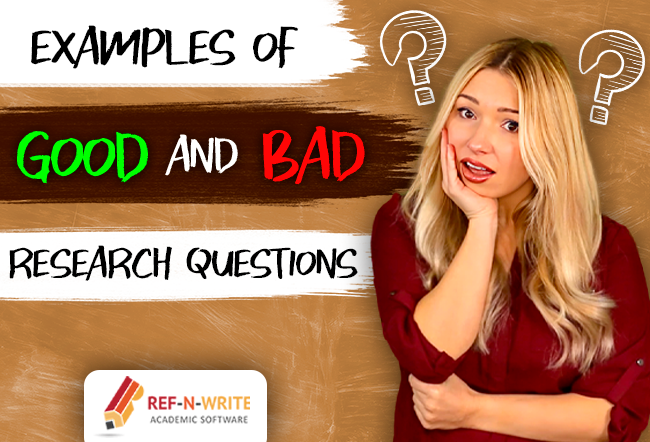
In this blog, we will look at some examples of good and bad research questions and learn how to formulate a strong research question.
Leave a Reply Cancel reply
- 2 Share Facebook
- 1 Share Twitter
- 0 Share LinkedIn
- 1 Share Email
- Writing Center
Beginner’s Guide to Research
Click here to download a .pdf copy of our Beginner’s Guide to Research !
Last updated : July 18, 2024
Consider keeping a printed copy to have when writing and revising your resume! If you have any additional questions, make an appointment or email us at [email protected] !
Most professors will require the use of academic (AKA peer-reviewed) sources for student writing. This is because these sources, written for academic audiences of specific fields, are helpful for developing your argument on many topics of interest in the academic realm, from history to biology. While popular sources like news articles also often discuss topics of interest within academic fields, peer-reviewed sources offer a depth of research and expertise that you cannot find in popular sources. Therefore, knowing how to (1) identify popular vs. academic sources, (2) differentiate between primary and secondary sources, and (3) find academic sources is a vital step in writing research. Below are definitions of the two ways scholars categorize types of sources based on when they were created (i.e. time and place) and how (i.e. methodology):
Popular vs. academic sources:
- Popular sources are publicly accessible periodicals–newspapers, magazines, and blogs–such as The Washington Post or The New Yorker . These sources are most often written for non-academic audiences, but can be helpful for finding general information and a variety of opinions on your topic.
- Academic sources , known also as peer reviewed or scholarly articles, are those that have undergone peer review before being published. Typically, these articles are written for other scholars in the field and are published in academic journals, like Feminist Studies or The American Journal of Psychology . Literature reviews, research projects, case studies, and notes from the field are common examples.
Primary vs. secondary sources:
- Primary sources are articles written by people directly involved in what they were writing about, including: News reports and photographs, diaries and novels, films and videos, speeches and autobiographies, as well as original research and statistics.
- Secondary sources , on the other hand, are second hand accounts written about a topic based on primary sources. Whether a journal article or other academic publication is considered a secondary source depends on how you use it.
How to Find Academic Sources
Finding appropriate academic sources from the hundreds of different journal publications can be daunting. Therefore, it is important to find databases –digital collections of articles–relevant to your topic to narrow your search. Albertson’s Library has access to several different databases, which can be located by clicking the “Articles and Databases” tab on the website’s homepage, and navigating to “Databases A-Z” to refine your search. Popular databases include: Academic Search Premier and Proquest Central (non-specific databases which include a wide variety of articles), JSTOR (humanities and social sciences, from literature to history), Web of Science (formal sciences and natural sciences such as biology and chemistry), and Google Scholar (a web search engine that searches scholarly literature and academic sources). If you are unable to access articles from other databases, make sure you’re signed in to Alberton’s Library through Boise State!
Performing a Database Search
Databases include many different types of sources besides academic journals, however, including book reviews and other periodicals. Using the search bar , you can limit search results to those containing specific keywords or phrases like “writing center” or “transfer theory.” Utilizing keywords in your search–names of key concepts, authors, or ideas–rather than questions is the most effective way to find articles in databases. When searching for a specific work by title, placing the title in quotation marks will ensure your search includes only results in that specific word order. In the example below, search terms including the author (“Virginia Woolf”) and subject (“feminism”) are entered into the popular database EBSCOhost:
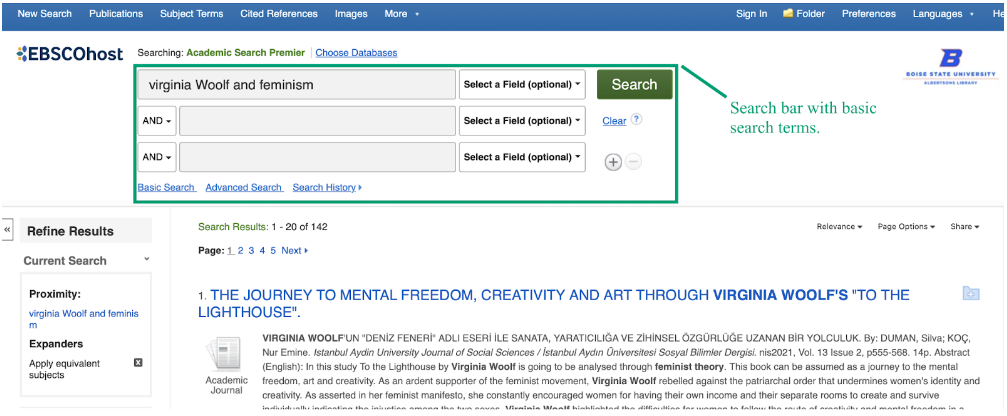
Refining Your Search Results
Many databases have a bar on the left of the screen where you can further refine your results. For example, if you are only interested in finding complete scholarly articles, or peer-reviewed ones, you can toggle these different options to further limit your search. These options are located under the “Refine Results” bar in EBSCOhost, divided into different sections, with a display of currently selected search filters and filter options to refine your search based on your specific needs, as seen in the figure below:
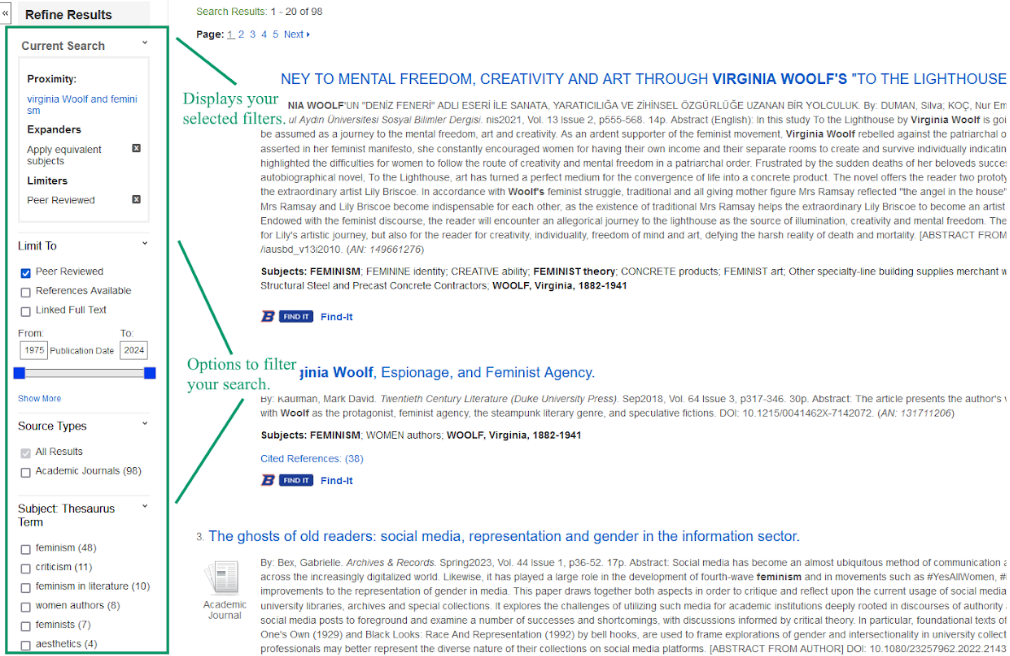
Search results can also be limited by subject : If you search “Romeo and Juliet” on Academic Search Premier to find literary analysis articles for your English class, you’ll find a lot of other sources that include this search term, such as ones about theater production or ballets based on Shakespeare’s play. However, if you’re writing a literary paper on the text of the play itself, you might limit your search results to “fiction” to see only articles that discuss the play within the field of literature. Alternatively, for a theater class discussing the play, you might limit your search results to “drama.”
The Writing Center

Research Paper Thesis
Ai generator.

In the realm of academic writing, a well-structured research paper thesis is a cornerstone. This article provides a comprehensive guide on crafting a research paper thesis, with over 21 examples in various formats such as PDF, Word, and Google Docs. We will also delve into the step-by-step process of writing a research paper thesis, answer some frequently asked questions, and provide links to related articles for further reading.
1. Research Paper Thesis
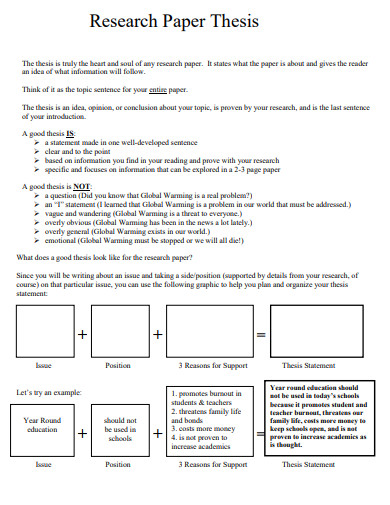
Size: 146 KB
2. Sample Research Paper Thesis
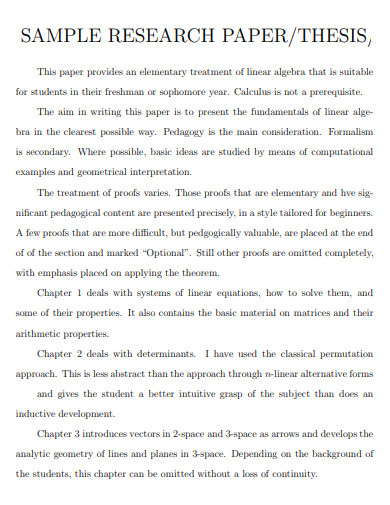
Size: 93 KB
3. Guidelines for Research Paper Thesis
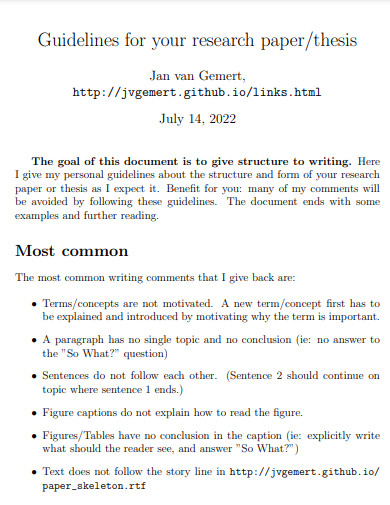
Size: 99 KB
4. Environmental Science Research Paper Thesis

Size: 558 KB
5. University Research Paper Thesis
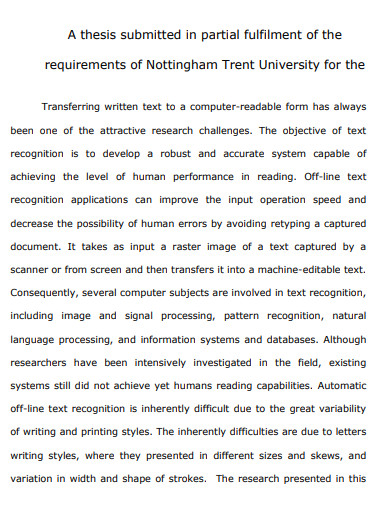
6. Research Paper Topic Sentence Thesis

Size: 435 KB
7. Writing Research Paper Thesis

Size: 66 KB
8. Key Points for Research Paper Thesis
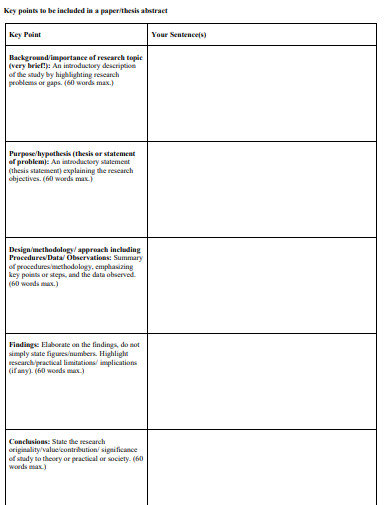
Size: 79 KB
9. Research Paper Organization Thesis
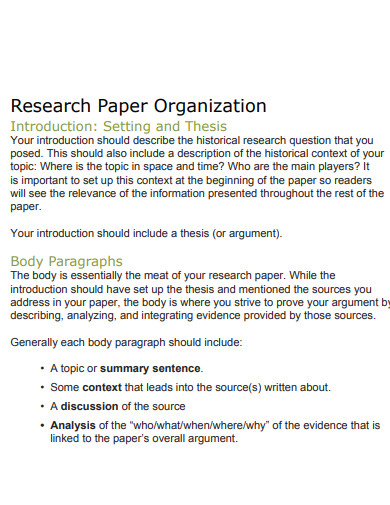
Size: 283 KB
10. Research Paper PhD Thesis
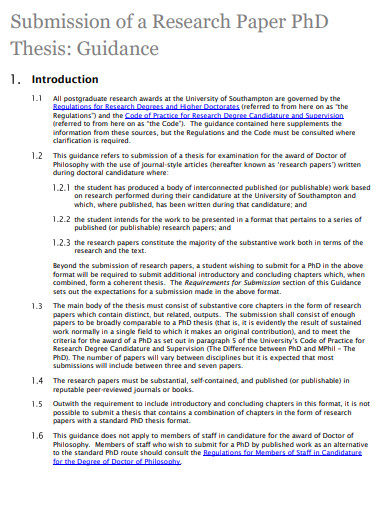
Size: 133 KB
11. Thesis Driven Research Paper
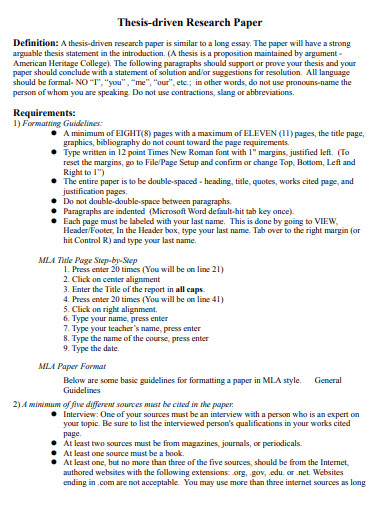
Size: 94 KB
12. Handbook Research Paper Thesis
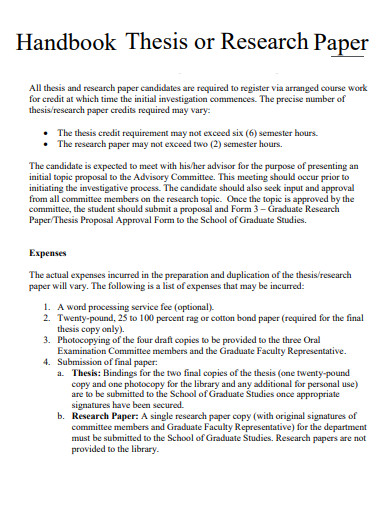
Size: 700 KB
13. Declaration of Research Paper Thesis
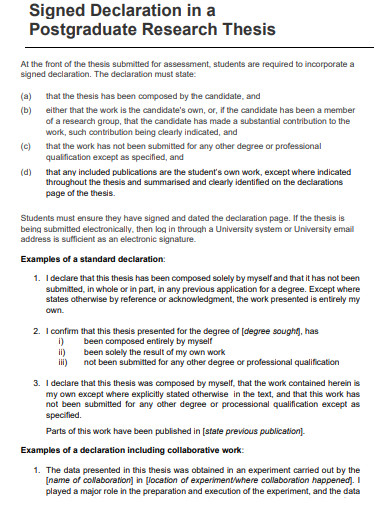
Size: 157 KB
14. Research Paper Thesis Statement
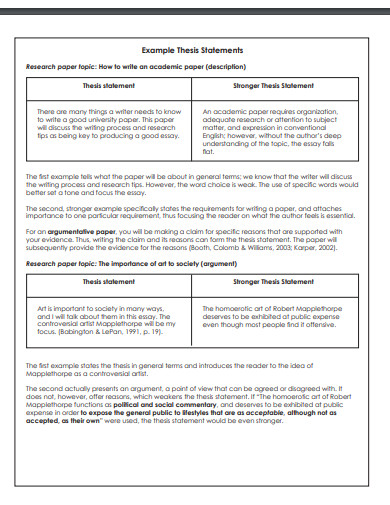
Size: 140 KB
15. Research Paper MA Thesis
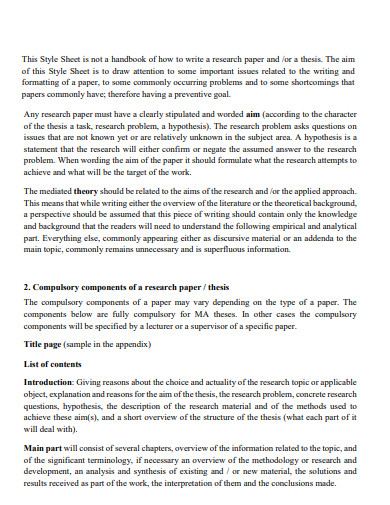
Size: 359 KB
16. Simple Research Paper Thesis
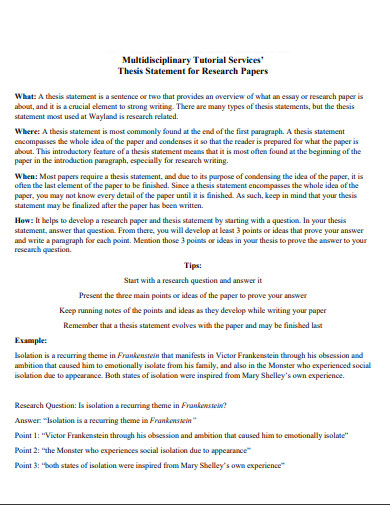
Size: 12 KB
17. Research Paper Thesis Outline
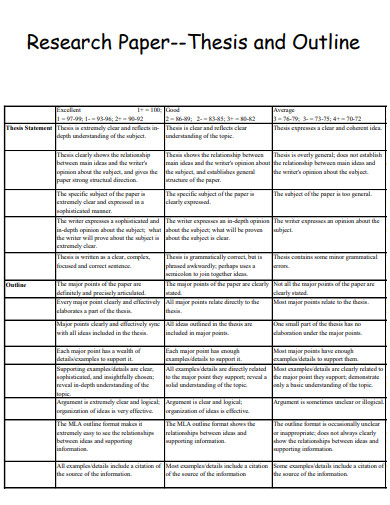
Size: 24 KB
18. Research Paper Thesis Proposal
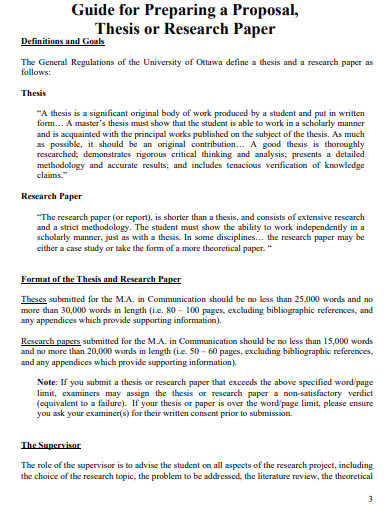
Size: 198 KB
19. Graduate Research Paper Thesis
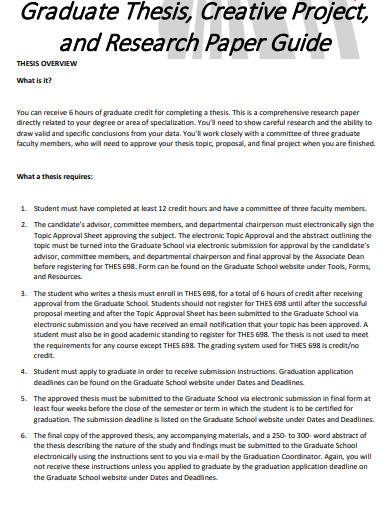
Size: 454 KB
20. Research Paper Thesis Important Points
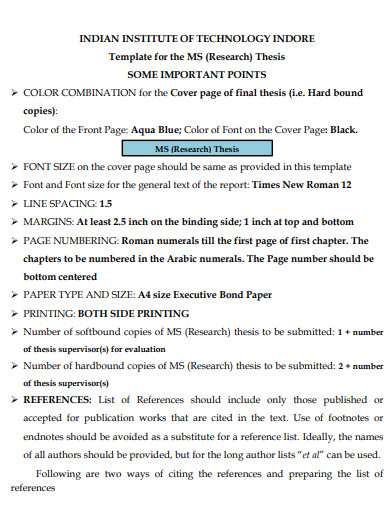
Size: 321 KB
21. Theoretical Research Paper Thesis
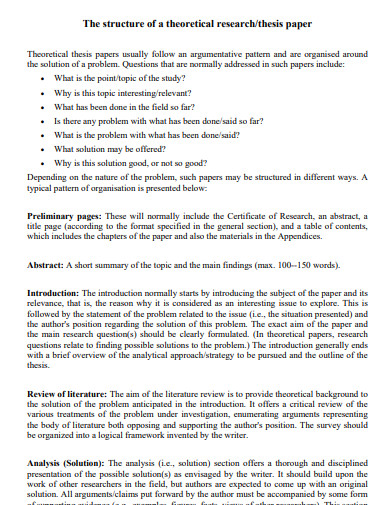
Size: 15 KB
22. Research Paper Thesis Checklist
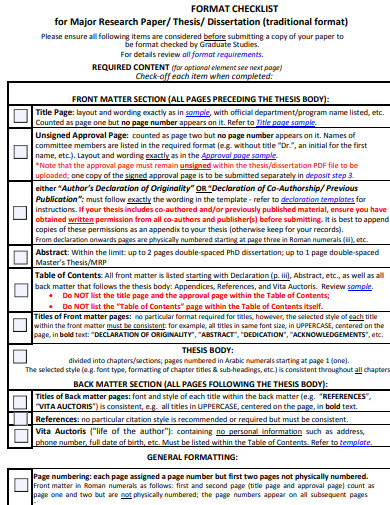
What is a Research Paper Thesis?
A research paper thesis is a concise statement that articulates the central argument or claim of your research paper. It serves as a roadmap, guiding the direction of your paper and keeping your argument focused. It is typically located at the end of the introduction section.
How to Write a Research Paper Thesis
Before we delve into the steps of creating a research paper thesis, it’s essential to understand its importance. A well-crafted thesis statement can make your research paper more effective and impactful.
Step 1: Understand your research topic:
Before you can write a thesis statement, you need to have a clear understanding of your research topic. This involves conducting preliminary research and identifying the key issues or questions related to your topic.
Step 2: Formulate your argument:
Based on your understanding of the topic, formulate a clear and concise argument that your research paper will explore.
Step 3: Write the thesis statement:
Your thesis statement should clearly articulate your argument. It should be specific, concise, and arguable. For more guidance, refer to our article on ‘ 26+ Research Paper Introduction Examples in PDF, Word, Google Docs, Apple Pages ‘.
Step 4: Revise and refine:
As your research progresses, you may need to revise and refine your thesis statement to ensure it accurately reflects the content of your paper.
What is a research paper thesis?
A research paper thesis is a concise statement that articulates the central argument or claim of your research paper.
How do I write a research paper thesis?
To write a research paper thesis, you need to understand your research topic, formulate your argument, write the thesis statement, and revise and refine as necessary.
Where can I find examples of research paper theses?
You can find examples of research paper theses in our ’21+ Research Paper Thesis Example in PDF, Word, Google Docs’ article.
In conclusion, a well-crafted research paper thesis is crucial for an effective and impactful research paper. By following the steps outlined in this guide and utilizing the provided examples, you can create a strong thesis statement that guides your research and strengthens your argument. For more information, check out our articles on ‘ 26+ MLA Research Paper in PDF ‘, ‘ 24+ Research Paper Abstract Examples in Word, Google Docs, PDF ‘, ‘ Research Paper Format ‘, ‘ 10+ Research Paper Checklist Examples [College, Grading, School ]’, ‘ 10+ APA Research Paper Examples ‘, ‘ Chicago Style Paper ‘, ‘ MLA Paper Format ‘, ‘ Research Design ‘, and ‘ 10+ Research Outline Examples in MS Word | PDF ‘.
Text prompt
- Instructive
- Professional
10 Examples of Public speaking
20 Examples of Gas lighting

Sign up for the Health News Florida newsletter
Too many pills how to talk to your doctor about reviewing what’s needed.

If you’re taking multiple meds, it’s smart to be aware of potential problems. One pill can lead to a side effect, leading to another pill and another side effect in what experts call a “prescribing cascade.”
Swallowing a handful of pills is a daily ritual for many people, from young adults coping with anxiety to older adults managing chronic conditions . Overall, 13% of people in the U.S. take five or more prescription drugs. For those 65 and older, that number is 42%.
Some drugs can cause harm if taken for years. Others stop working or interact badly with a new drug. A drug tolerated well at first can cause side effects later, leading to cognitive decline and injuries from falls.
“Our metabolism changes as we get older,” said Dr. Elizabeth Bayliss, who studies deprescribing at Kaiser Permanente’s Institute for Health Research in Aurora, Colorado. “Everyone’s ability to metabolize the medications they’ve been taking for a long time may change.”
The nonprofit Lown Institute calls the whole situation a medication overload that will cause 4.6 million hospital visits this decade.
If your daily pill routine is getting out of hand, ask for a medication review. Here’s how to get started with a process called “deprescribing."
Ask for a prescription checkup
Start with a professional you trust, like a doctor or pharmacist, said Lisa McCarthy, a pharmacist and deprescribing expert at the University of Toronto.
If you’re asking your doctor, don’t wait until the end of a 15-minute visit. Instead, make a dedicated appointment and tell them when booking you want to talk about your medicines, McCarthy said.
Your doctor may not have the full picture of what you’re taking if other prescribers are involved, and some doctors hesitate to manage drugs prescribed by others. That’s when a pharmacist can help by reviewing everything and writing up suggestions you can share with your doctors, said pharmacist Bradley Phillips of the University of Florida College of Pharmacy.
“We’re considered the medication experts,” Phillips said.
Could my medicine be causing a problem?
Swelling, incontinence, restlessness, insomnia — all are side effects caused by common medications that sometimes get treated with new drugs. McCarthy wants people to ask their doctors a simple question: Could this symptom be related to one of my medications?
“If we could teach the public to ask that question it would be very powerful,” McCarthy said. And for a follow-up question, she suggested: Do I still need this medicine?
Pharmacist Barbara Farrell sees dramatic changes in many people she helps at an outpatient geriatric center in Ottawa, Ontario. Some have emerged from a drug-induced dementia after their meds are reduced. A 77-year-old woman was able to leave her wheelchair and walk with a cane after cutting her daily pills from 32 to 17. She had arrived sedated and unable to communicate, and a few months later, she was back to her hobby of knitting.
Weaning off medication takes time
Some meds can be stopped abruptly but others require a slow taper to prevent uncomfortable withdrawal symptoms — or even life-threatening seizures. Tapering to progressively lower doses is particularly important with drugs for depression, insomnia and anxiety.
After two decades on various pills for these conditions, therapist Molly Bernardi of Spokane, Washington, began tapering down her doses.
The 45-year-old suspected the pills were the cause of her worsening problems with digestion, balance, memory, stiff muscles and flickering dots across her field of vision. When scans ruled out other illnesses, she gradually stopped each of four medications.
“It’s been by far the hardest thing I’ve ever done,” Bernardi said.
One of the final drugs she stopped was the toughest: a benzodiazepine, a class of sedatives that can be harmful if taken long term. Over the course of three months, she used a kitchen knife and a nail file to cut her 1 milligram daily pill into ever-smaller pieces.
She listened to her body, found support groups on Facebook and used breathwork and prayer to get through withdrawal symptoms.
“Now when I have a good day, a good hour, a good moment, it’s peace and presence like I’ve never known since before I was medicated,” Bernardi said. “I’m just experiencing a little bit of great. And a little bit of great is so great that it keeps me going.”
Be in charge of your medication list
Even in the best-connected health care systems, McCarthy said, information about prescriptions isn’t always shared among doctors. And they won’t know about your over-the-counter drugs, vitamins or nightly CBD gummy.
The only person who knows everything you take is you, McCarthy said. So keep a current list of what you take, why it was prescribed and when you started taking it.
For an example of a medication list, which McCarthy called a “tremendously powerful” tool, look at the workshop materials she and her colleagues designed.
Rick Hess Straight Up
Education policy maven Rick Hess of the American Enterprise Institute think tank offers straight talk on matters of policy, politics, research, and reform. Read more from this blog.
A Brief History of Grading—and What That Means for Schools Today

- Share article
Over the past several months, Joe Feldman, veteran educator and author of Grading for Equity , and I have been discussing equitable grading. We’ve touched on everything from grade inflation to whether this approach can ever really yield higher standards to what it takes for schools to responsibly pursue equitable grading. Today, we talk about what the research says about equitable grading, and Joe delivers a brief history of grading practices.
Rick: You’ve mentioned to me that there’s a mismatch between what the research on equitable grading says and the way the practice is regarded by its critics. Can you explain what you mean?
Joe: I get that “equity” has become a polarizing term of late, and I also recognize that there are probably bad or ineffective things happening under the banner of “equitable grading” that have little resemblance to the way that I’ve defined—and many others implement—those practices. But the work of more accurate and fair grading, whether you want to call it “equitable grading,” “standards-based grading,” or even “common-sense grading,” is about creating the conditions for deeper, more rigorous teaching and learning through clearer and more truthful reporting of student progress that doesn’t reward or punish students based on teacher biases or circumstances outside a student’s control.
Taking a critical view of how we traditionally grade can lead to profound and positive changes. The most convincing evidence is from teachers who share their experiences. Here’s one quote from Nick, a high school physics teacher, who told me, “I’ve told students that the homework, rather than being included in your grade, is your opportunity to practice and to see how well you understand things. Homework completion at first took a dip when I stopped counting it for points.”
But that’s not the end of the story. Before too long, Nick related, “They realized, ‘Oh, I want to get a good grade in this class. I need to understand the material,’ and then homework completion has shot up. It’s the opposite of what I feared would happen. Now they see that the purpose of homework is actually to learn the material.”
Rick: You’ve suggested that common grading practices should be regarded as the product of inertia more than evidence. Can you say more about what you mean?
Joe: Entrenched practices can persist despite compelling evidence for change. When it comes to grading, our long-held beliefs often diverge from the most recent evidence and real experiences of practitioners. This isn’t unique to education: Physicians are famously resistant when long-standing practices are upended by emerging research or new data, even by fellow physicians. One example is the adoption of handwashing in health-care settings. Ignaz Semmelweis, a Hungarian physician in the mid-19th century, discovered the importance of hand hygiene in preventing the spread of infectious diseases. Yet, despite Semmelweis’ findings and evidence, his ideas were initially met with skepticism and resistance from the medical community. It took several decades for handwashing to become widely accepted as a standard practice in health-care settings. I’m not going to claim that equitable grading is the same as handwashing, but I do think that equitable grading practices make grades less likely to be “infected” by teachers’ biases.
I have always approached this work as a dialogue—where you and I approach this work with mutual curiosity and openness. I’ve had many disagreements with skeptics that ended in our realizing that we are interested in the same goals for students—particularly those who have been historically underserved—and we agree more than we disagree about the benefits of equitable grading once we are clear about what it is and what it isn’t. I recall a Fox News interview where I was paired with a teacher who spoke about her adamant disagreement with “equitable grading.” When she shared her concerns, and I responded with clarifications, rationale, and evidence, she shifted to arguing that the biggest problem is that districts aren’t training all teachers to implement improved grading!
Rick: OK, let’s switch gears. We’ve had a number of conversations about grading as practiced today. Given all that, I’m always curious how we got here. You’ve noted in passing that the contemporary grading system grew out of the Industrial Revolution. Can you spell out what you mean by that?
Joe: Our current grading practices were developed over a century ago and shaped by that era’s beliefs about teaching, learning, and human potential—many of which have since been debunked. In the early 20th century, academics and educators believed intelligence was fixed and distributed across the population along a bell curve, with a few people at the high and low ends and most in the middle. Following the lead of universities, K–12 schools used norm-referenced grading, in which a student’s grade signified their achievement relative to others’ in the course.
Our traditional approach to grading largely stems from the century-old beliefs that too many A’s constitutes a weak, easy course and that fewer successful students indicates a rigorous course. That thinking flies in the face of what we now know about academic potential. Grades of A don’t have less value if more students achieve them. Equitable grading reinforces that the size of the bullseye doesn’t get smaller if more people hit the target. Rather, these practices reinforce the goal of great teachers, which is to get the largest number of students to hit the mark as possible.
A second example is that during the Industrial Revolution, animal trials by John Watson and B.F. Skinner supported the belief that humans were most effectively motivated by extrinsic rewards and punishments. This belief underlies the traditional grading practice of using points to incentivize—or some might say control—student behaviors, such as coming on time to class or completing homework.
But, over the past few decades, research from Edward L. Deci and colleagues and from Tony Docan-Morgan has demonstrated that this belief has severe limitations, one of which is that extrinsic rewards and punishments often undermine creative thinking and effective problem-solving. And while some might argue that using points to change behavior prepares students for the professional world, there’s no evidence I’m aware of that supports this. For example, there’s no evidence that employees who come on time to meetings do so because their teachers subtracted points for lateness or that employees who are habitually tardy had teachers with more lenient grading policies.
I believe a primary reason Industrial Revolution-era grading persists is that a critical understanding of grading research and practice hasn’t been included in teacher education or certification. For generations, teachers have had little choice but to replicate how they were graded, and many teachers were successful in school and ostensibly weren’t harmed by traditional grading—the reasoning goes something like, “I did fine, so why change anything?” We find that when teachers think critically about this underdeveloped aspect of their practice, they see the urgency to shift their grading to match modern, research-based understandings of student motivation.
Rick: You’ve previously raised the issue of grade deflation , arguing we focus too much on grade inflation and not enough on deflation. I’m not sure what to make of the argument but would love to hear you explain a little more. Can you expand on what you have in mind?
Joe: Let’s start by clarifying what we mean by grade inflation. Grade inflation occurs when a student’s grade is higher than their actual understanding. When grades are inflated, that student, their parents, college-admissions officers, and others are told that the student is prepared for a certain level of academic challenge when they actually aren’t. This inaccurate grade can have significant consequences, such as requiring unanticipated remediation, which, in college, can make students less likely to graduate on time, if at all.
Grade inflation has received particular attention since the pandemic. Interestingly, research by Seth Gershenson of the Fordham Institute published in 2018—before the pandemic—found that grade inflation was worse in schools attended by higher-income students, while research after the pandemic suggests that, more recently, there has been a disproportionate increase in the grade inflation of students of color and those from low-income families.
Grade deflation—and I have come to believe a more useful term might be “grade depression”—occurs when a teacher-assigned grade is lower than a student’s understanding of course content. Grade depression can be even more harmful than grade inflation. Rather than grade inflation, which opens doors for an opportunity a student is not prepared for, grade depression prevents students from pursuing opportunities—like advanced coursework or postsecondary opportunities—that they are fully prepared for.
We know that traditional grading practices can cause grade inflation and grade depression due to their reliance on the common practice of combining a student’s academic with nonacademic performance in their final grades. This practice renders grades inaccurate and unreliable. The student who doesn’t know the content particularly well but compensates for that weakness by following all class rules earns an inflated grade. On the other hand, the student who has an excellent understanding of the content but doesn’t adhere to all class rules receives a depressed grade. The student with an inflated grade is able to conceal the truth of their deficient academic understanding by pleasing the teacher, and the student with a depressed grade has their excellence hidden.
In a forthcoming paper by the Equitable Grading Project, my co-authors and I compare the teacher-assigned grades of secondary students from multiple states and districts with their corresponding standardized-test scores. The findings revealed a striking mismatch between grades and test scores. Of course, this could be caused by a host of reasons related to the weaknesses of standardized testing. However, we found that when teachers deviated from traditional methods of grading and used improved, more equitable grading practices, grade-test score consistency—i.e., the similarity between grades that teachers assign and test scores—increased, meaning that the use of those practices reduced both grade inflation and grade depression. These results match what we found in 2018.
There’s a lot to excavate about the forces influencing grade inflation and grade depression, but we know we can be confident that equitable grading practices dampen these forces and make grades more accurate and fairer.
The opinions expressed in Rick Hess Straight Up are strictly those of the author(s) and do not reflect the opinions or endorsement of Editorial Projects in Education, or any of its publications.
Sign Up for The Savvy Principal
Edweek top school jobs.

Sign Up & Sign In

The first question asks for a ready-made solution, and is not focused or researchable. The second question is a clearer comparative question, but note that it may not be practically feasible. For a smaller research project or thesis, it could be narrowed down further to focus on the effectiveness of drunk driving laws in just one or two countries.
A well-crafted research question (or set of questions) sets the stage for a robust study and meaningful insights. But, if you're new to research, it's not always clear what exactly constitutes a good research question. In this post, we'll provide you with clear examples of quality research questions across various disciplines, so that you can approach your research project with confidence!
The examples of research questions provided in this guide have illustrated what good research questions look like. The key points outlined below should help researchers in the pursuit: The development of a research question is an iterative process that involves continuously updating one's knowledge on the topic and refining ideas at all ...
A good research question is essential to guide your research paper, dissertation, or thesis. All research questions should be: Focused on a single problem or issue. Researchable using primary and/or secondary sources. Feasible to answer within the timeframe and practical constraints. Specific enough to answer thoroughly.
Definition: Research questions are the specific questions that guide a research study or inquiry. These questions help to define the scope of the research and provide a clear focus for the study. Research questions are usually developed at the beginning of a research project and are designed to address a particular research problem or objective.
As the name suggests, these types of research questions seek to explore the relationships between variables. Here, an example could be something like "What is the relationship between X and Y" or "Does A have an impact on B". As you can see, these types of research questions are interested in understanding how constructs or variables ...
Excellent research always starts with a compelling question.. However, developing a good research question is often challenging. But, doing appropriate data analysis or drawing meaningful conclusions from your investigation with a well-defined question make it easier.
There are two types of research: Qualitative research and Quantitative research. There must be research questions for every type of research. Your research question will be based on the type of research you want to conduct and the type of data collection. The first step in designing research involves identifying a gap and creating a focused ...
Assess your chosen research question using the FINER criteria that helps you evaluate whether the research is Feasible, Interesting, Novel, Ethical, and Relevant. 1; Formulate the final research question, while ensuring it is clear, well-written, and addresses all the key elements of a strong research question. Examples of research questions
Framing the research question is the first step in any research project, and you can learn how to write a research question that is focused, achievable, and answerable! Check this detailed article to know what a research question is, the different types, and a step-by-step process to formulate effective research questions, with examples.
Research Aims: Examples. True to the name, research aims usually start with the wording "this research aims to…", "this research seeks to…", and so on. For example: "This research aims to explore employee experiences of digital transformation in retail HR.". "This study sets out to assess the interaction between student ...
A qualitative research question is a type of systematic inquiry that aims at collecting qualitative data from research subjects. The aim of qualitative research questions is to gather non-statistical information pertaining to the experiences, observations, and perceptions of the research subjects in line with the objectives of the investigation.
A good research question should: Be clear and provide specific information so readers can easily understand the purpose. Be focused in its scope and narrow enough to be addressed in the space allowed by your paper. Be relevant and concise and express your main ideas in as few words as possible, like a hypothesis.
Research Question Example: Asking how a chemical is used or perceptions around a certain topic. ii. Predictive Questions. Predictive research questions are defined as survey questions that automatically predict the best possible response options based on text of the question. Moreover, these questions seek to understand the intent or future ...
In a research paper, the emphasis is on generating a unique question and then synthesizing diverse sources into a coherent essay that supports your argument about the topic. In other words, you integrate information from publications with your own thoughts in order to formulate an argument. Your topic is your starting place: from here, you will ...
Research questions: This article provides a practical explanation of the topic of research questions.The article begins with a general definition of the term "research question" and an explanation of the different types of research questions. You will also find several useful tips for developing your own research question and sub-questions, for example, for a thesis or other research project.
10. Demographic research question. Demographic questions are based on a person's age, gender, family income, race, ethnicity, education, and other defining factors. Research about whether a specific product will be effective with a particular age or gender group can be carried out using demographic research questions.
To write an effective research question, researchers should follow these steps: 1. Select a general topic of interest. 2. Ask questions about the topic. 3. Write an effective question based on the ...
Research question examples are sample questions you can reference to help you prepare your own inquiries. A research question is an inquiry into a specific concern or relevant issue. This question typically addresses something that a researcher aims to understand through analysis and data interpretation upon completing the project. It helps ...
A research question is the main query that researchers seek to answer in their study. It serves as the basis for a scholarly project such as research paper, thesis or dissertation. A good research question should be clear, relevant and specific enough to guide the research process.
Oftentimes, lecturers give their students the freedom to pick their own research questions. While this can be a good thing on its own, at other times, it can drain the brain. Having relevant sociology research question ideas and sociology research questions examples is the right way to start. In this article, you will be receiving 99 sociology ...
The research question is normally one of the major components of the final paragraph of the introduction section. We will look at the examples of the entire final paragraph of the introduction along with the research questions to put things into perspective. 2.1. Example #1 (Health sciences research paper)
Literature reviews, research projects, case studies, and notes from the field are common examples. Primary vs. secondary sources: Primary sources are articles written by people directly involved in what they were writing about, including: News reports and photographs, diaries and novels, films and videos, speeches and autobiographies, as well ...
Content validity is critical for making informed decisions and drawing accurate conclusions based on the research data. Content validity example A statistics professor creates a test to measure students' knowledge of internal validity. The test consists of 10 multiple-choice questions, and one of the questions is: "What is the difference ...
This article provides a comprehensive guide on crafting a research paper thesis, with over 21 examples in various formats such as PDF, Word, and Google Docs. We will also delve into the step-by-step process of writing a research paper thesis, answer some frequently asked questions, and provide links to related articles for further reading.
Swallowing a handful of pills is a daily ritual for many people, from young adults coping with anxiety to older adults managing chronic conditions. Overall, 13% of people in the U.S. take five or more prescription drugs. For those 65 and older, that number is 42%. If you're taking multiple meds ...
For example, our Similarity Report guidance on help.turnitin is repeated in numerous places to cater for each individual integration and license type. On guides.turnitin this content will exist in a single place to allow for users of all integrations and licenses to find it easily. We have made slight modifications to these guides to help you ...
A second example is that during the Industrial Revolution, animal trials by John Watson and B.F. Skinner supported the belief that humans were most effectively motivated by extrinsic rewards and ...
A six-month investigation reveals that many carbon credit ventures reap profits from public lands they have no right to and fail to share revenue with those protecting the forest.
- business plan
- course work
- research paper
Asia Chevron
Thailand Chevron
The Best Beaches in Southeast Asia

As summer begins to draw to a close, some of us may find that we aren’t ready yet to put away our beach towels and let go of sun-kissed days on beautiful white-sand beaches . Among the hundreds of thousands of beaches in the world, one region has a remarkable number of seaside paradises— Southeast Asia . After taking a look at some of the most spectacular beaches found there, it’s easy to understand how the region has emerged as one of the world’s most popular destinations.
Malaysia and Thailand lead the region in terms of annual visitors, followed by Vietnam, Indonesia, the Philippines, Cambodia, and Laos. All these countries have an enviable combination of appeals that help explain why they fascinate so many travelers. In terms of cultural tourism, these countries have remarkably varied histories and even languages while their architectural wonders including ancient palaces and temples inspire generations of travelers. And Southeast Asia’s natural beauty is also a draw with its verdant and green landscapes hugged by an almost uncountable number of beaches. The Philippines alone is home to more than 7,600 islands; some have beaches lined with resorts while on others you may find yourself alone with only the local seabirds as company. Whether by providing some much-needed R&R, thrilling adventure, or total immersion in wildlife, the diverse shorelines across Southeast Asia do their part in drawing in millions of travelers each year.
Tonsai Beach, Krabi, Thailand
Thailand is home to some of Southeast Asia’s most beautiful beaches, and Tonsai Beach earns its place at or near the top of many lists of the country’s most stunning ones. To get there, most visitors drive about a half-hour from the town of Krabi to Ao Nang. That’s where the road ends, and from there you’ll have to continue to Tonsai Beach by boat or on foot following the Monkey Trail. Ringed by towering karst mountains, Tonsai feels like—and is—a small remote village with only a handful of guesthouses and small shops. If you get bored with relaxing on the sand and swimming, opportunities to go rock climbing are just a few steps from the sand.

After driving from Krabi to Ao Nang, travelers have their choice of arriving at Tonsai Beach by boat, or by foot on the Monkey Trail.
Coral Bay, Perhentian Kecil, Malaysia
Pulau Perhentian Kecil (in English, Little Perhentian Island) is located off the northeast coast of Malaysia, next to its sister Pulau Perhentian Besar (Big Perhentian Island). For centuries, the Perhentian Islands were mostly visited by traders traveling between Thailand and Malaysia. That historical fact explains their name— perhentian means “resting place” in Malay. Long popular with backpackers, Perhentian Kecil is home to some of Malaysia’s most beautiful beaches. Coral Bay, on the west coast, is a stretch of white sand and crystal clear water, and a quieter alternative to the bustling Long Beach on the island’s east coast.
The coral reefs that surround both islands, as well as two shipwrecks, make the Perhentians one of the best places in Malaysia to go snorkeling and diving. Several excellent dive sites are located off of Coral Bay. In addition to sea turtles and clownfish, you can also spot black-tip reef sharks here.

With its diverse coral reefs teeming with colorful fish, the waters of Coral Bay are a diver's playground.
Bawah Reserve, Bawah Island, Indonesia
Bawah Island sits in the Anambas Archipelago of Indonesia , between the southern tip of Malaysia and Borneo. It’s an idyllic place to relax, connect with nature, and digitally detox. It took five years to build the Bawah Reserve resort by hand without using heavy machinery. It includes 36 individual suites, 11 of them overwater bungalows. The final result is a near perfect combination of nature and architecture. The gin-clear and calm water is teeming with a remarkable variety of corals and colorful marine life. It’s easy to explore the reef in a kayak with a transparent bottom or by snorkeling. The resort also offers opportunities to go windsurfing and try other water sports.

The Bawah Reserve resort is entirely hand-built and features 36 suites, 11 of them being overwater bungalows.
Cat Co 3, Cát Bà Island, Vietnam
Cát Bà is the largest island in Vietnam ’s Ha Long Bay and an excellent base for exploring this famous natural wonder. Much of the island is a national park with a wild and rugged natural beauty. There are also three small sandy beaches just a short walk from the town of Cát Bà, the largest settlement on the island. Cat Co 3 is a curve of fine sand and clear, calm water, overlooking one of the limestone islets of Lan Ha Bay. The beach is an ideal place to relax and swim. Although it is adjacent to a resort, the beach is open to the public.

Cat Co 3 is just a short walk from the main town of Cát Bà and the island's national park.
Saracen Bay, Koh Rong Samloem, Cambodia
Often overshadowed by the many beautiful beaches of Thailand, Cambodia ’s shores receive only a small fraction of the tourists who visit its neighbor. If you’re looking for a place to rest and relax away from the crowds, the island of Koh Rong Samloem is an excellent choice. The island paradise is located about half an hour by boat from Sihanoukville on the mainland. Its largest beach, Saracen Bay, is a stretch of dazzling white sand and warm, shallow, and clear water, providing a serene setting for a few days at the beach.
There is a good selection of accommodations and restaurants running along the bay, each offering picture-postcard views of the sea. For those looking for some exercise, you can rent a kayak, or stand-up paddle board, or head to Lazy Beach on the other side of the island—about 30 minutes on foot—to go snorkeling or swimming.

Cambodia's island of Koh Rong Samloem is home to Saracen Beach and Lazy Beach, which are best known as places to rest and relax away from the crowds.
Panagsama Beach, Moalboal, Cebu, Philippines
The rocky coastline of Moalboal’s Panagsama Beach, located just two and a half hours from the international airport in Cebu in the Philippines , may not be the best place to travel to if you are looking for a silky sand beach. (If that is what you’re searching for, we suggest visiting White Beach on the same island.) It’s not the beach itself, but what lies in the nearby in the sea that earns it a place as one of the best beaches in Southeast Asia.
Roughly 100 feet from the shore, the coral reef drops off dramatically, reaching a depth of up to 230 feet. The setting offers perfect conditions for observing the colorful and abundant marine life here. The star attraction are the many sardines that gather near Panagsama Beach. The schools can include millions of fish that move together as one in a fascinating display. Sardines can be found here all year round, although the peak season is from November to April .

Panagsama Beach is known for the colorful and abundant marine life that gathers in its waters.
Buffalo Bay, Koh Payam, Thailand
Returning to Thailand and visiting one of the islands that flies under the radar of most tourists, Koh Payam is located a stone’s throw from the border with Myanmar. Koh Payam can be reached after a long bus ride from Bangkok to the port of Ranong followed by a 40-minute boat ride. After you step on shore, head to the northwest corner of the island to find Buffalo Bay (or Ao Khao Kwai). The vast white-sand beach is lapped by the beautiful blue waters of the ocean. It is a perfect place to spend lazy days swimming or relaxing.
Although there are some lodging and dining options, much of the beach is undeveloped and tends to be blissfully uncrowded. The sunsets from the Hippy Bar, a favorite of the few backpackers who come here, are needed reminders of the simple pleasures of life.
This article originally appeared on Condé Nast Traveller Spain .
Trending Travel Destinations
Want to be the first to know? Sign up to our newsletters for travel inspiration and tips
The 23 Best Things to Do in New Orleans
21 Best Airbnbs in Puerto Rico , From San Juan to Rincón
11 Best Airbnbs in Oaxaca , Mexico
Where to Stay in London : Our Editors' Favorite Neighborhoods
Recommended

Mandarin Oriental, Bangkok

Absolute Sanctuary Koh Samui

Asia Travel Guide
By signing up you agree to our User Agreement (including the class action waiver and arbitration provisions ), our Privacy Policy & Cookie Statement and to receive marketing and account-related emails from Traveller. You can unsubscribe at any time. This site is protected by reCAPTCHA and the Google Privacy Policy and Terms of Service apply.
A billionaire hopes to change our understanding of sea life and save the oceans with a research vessel straight out of 'Star Trek'
- OceanXplorer, a 285-foot research vessel , contains cutting-edge tools for ocean science.
- Billionaire Ray Dalio bought the former oil ship and helped transform it into a world-leading research vessel.
- Ray Dalio's son wants the ship to inspire ocean conservation through advanced research and documentaries.

The OceanXplorer is both science and spectacle.
The 285-foot research vessel gives ocean scientists access to virtual reality, submersibles , a helicopter, and onboard laboratories, all in a setting designed to evoke a Marvel movie.
"It has basically every tool a researcher could dream of for exploring the deep," Eric Stackpole, a remotely operated vehicle expert, told Business Insider.
Stackpole is part of a team that traveled on the ship from a volcanic archipelago in the North Atlantic to just south of the North Pole for National Geographic's new show "OceanXplorers."
See what it was like to follow polar bears from the sky and study sharks from the seafloor.
OceanX converted a former oil vessel into a research ship.
Billionaire Ray Dalio bought the boat in 2016 . It was an oil ship at the time and he and his son Mark Dalio spent the next four years transforming it into a one-of-a-kind research vessel capable of real-time scientific analysis. Experts from the Woods Hole Oceanographic Institution consulted to ensure scientists would have everything they needed on board.
For example, it might take a typical research vehicle several years to get DNA sequencing results back and then return to the same location equipped with that data.
With OceanXplorer's onboard lab, researchers can collect samples, process the data in real-time, and then make informed decisions based on what they find.
"We feel like it's a lot more efficient," said Mark Dalio, co-CEO of OceanX, the company that owns OceanXplorer.
It's helping scientists solve some of the sea's greatest mysteries.
The vessel's pair of three-seater submersibles can descend over 3,000 feet and stay on the seafloor for 12 hours.
As a passenger in one, biologist Nigel Hussey witnessed something he'd never seen before, a Greenland shark feeding in its own habitat.
The sharks can live for over 400 years, the longest of any vertebrate, but they spend much of their time in deep, difficult-to-access waters of the Arctic.
"To actually witness and see an animal that you've committed a huge amount of time, blood, sweat, and tears to studying, it's indescribable how fabulous it is," Hussey said in National Geographic's show.
Seeing the cautious way the shark approached food could indicate one reason the species lives so long , Hussey said. Some researchers want to learn more about these animals in the hopes of lengthening human lifespans.
It was built for many kinds of science.
On board, scientists can use the four labs to analyze samples, sequence DNA, and study specimens. Meanwhile, ROVs explore the deep ; sonar maps the seafloor ; and a sampling tool measures the water's temperature, pressure, and salinity.
"I think the most unique kind of throughline is the cross-disciplinary nature of the ship," Mark Dalio said. Meaning researchers who study sharks, whales, squid, and polar bears can all make use of the vessel .
OceanX not only helps scientists reach locations from the subtropical Bahamas to freezing Svalbard, it brings along filmmakers and photographers to document the work as it's taking place.
The National Geographic show highlights the work of researchers who used the ship's helicopters to study polar bears ' disappearing habitats and another group who dove deep in submersibles to study sperm whales' prey.
"Ultimately, our goal is to help raise awareness of what this majority of our planet is like," Stackpole said. "If you don't understand it, you can't affect it."
Some of the technology feels like living in the future.
OceanX partnered with Microsoft to create a "holographic laboratory" on the ship. The cutting-edge technology makes complex data easy to visualize.
Scientists wearing HoloLens headsets can view a simulated ocean floor. It can help turn numbers in a graph into a representation of an underwater environment, incorporating data from sperm whale location tags, sonar readings, and temperature and salinity information.
"We were able to stand around this table and in three dimensions, manipulate a map of what the bottom looks like," Stackpole said of an ocean-floor visualization. "It felt like living in the future."
There are some bonuses to being on a billionaire's boat.
The vessel was built for scientists, but it still has some amenities you might not typically find on a research ship.
"There was a drawer that was just filled with ice cream you could get whenever you want," Stackpole said. "That felt like an indulgence for an open ocean expedition."
It's not quite like going on a luxury cruise , though. There's room for about 72 people on board, but passengers have to share rooms with bunk beds.
The ship is supposed to look like something out of 'Star Trek.'
Mark Dalio worked as a National Geographic filmmaker in the past and always wanted the OceanXplorer to be used for scientific storytelling.
Director James Cameron and his team — who have experience designing the filmmaker's former research vessel — offered advice about creating spaces that were both functional and futuristic. Specifically, Cameron suggested they take inspiration from a " Star Trek " spacecraft.
"If you're going to do all that work, make it look and feel like something like the 'Starship Enterprise' of the oceans," Dalio said. "Make it inspirational and aspirational for the next generation of scientists and students and educators."
Art director Page Buckner, who worked on "Iron Man 2," "Jurassic World," and other movies, also helped make the ship camera-ready.
"Everything can be ready to go from a filmmaking standpoint" when scientists are seeing something new or exciting, Dalio said. "It allows us to be a lot more in the moment during that and really capture that in a way that is very authentic."
In fact, most of the ship was designed with documentaries in mind.
The next big project is a focus on fish.
Mark Dalio plans to keep the ship in Southeast Asian waters for the next five years. The Phillippines is a hot spot for a variety of marine life.
One goal is to learn more about the region's biodiversity to help find ways to protect vulnerable species.
Techniques like whole genome sequencing will give scientists a clearer picture of what fish are present and what animals are eating them.
Other research will focus on gathering data to document climate change, studying coral reefs , and finding potential areas for preservation that could be used for carbon credits.
All this feeds into OceanX's overarching goal, which is to foster the next generation of ocean scientists. "We need a next generation of ocean scientists and ocean storytellers," Dalio said.
- Main content

IMAGES
COMMENTS
Credit: Ahoy Club. The completion of Coral Ocean 's rebuild was celebrated at the 2022 Monaco Grand Prix, with a guest list of 100 that included the senior team from the German superyacht builder. Philipp von Arnim, head of business development at Lürssen, was there and says what he saw was a different yacht.
The 73 metre Lürssen superyacht Coral Ocean has been pictured for the first time following a major €35 million refit at the Astilleros de Mallorca shipyard. She was delivered as Coral Island by Lürssen in 1994 and was one of the yard's biggest projects at the time. Jon Bannenberg, often considered the godfather of modern yacht design, was ...
Following the refit, she was renamed Coral Ocean and made available for charter through Burgess. In 2019, Australian waste entrepreneur Ian Malouf acquired the luxury yacht, investing in a $35 million refit at STP shipyard in Mallorca. The refit included a new white hull, a refreshed interior, an updated sundeck, and an increased volume of 150gt.
Her owner, the head of the peer-to-peer yacht-charter company Ahoy Club, envisioned ways to augment her already-storied status. Coral Ocean' s €35-million refit ($36.4 million) keeps the nearly 30-year-old yacht current in a competitive class of large yachts. The 238-footer (72.55-meter) initially saw delivery from Lürssen back in 1994.
Undertaking a €35M Refit. Known for its historical significance and innovative design, CORAL OCEAN underwent a significant refit under the ownership of Ahoy Club. The project involved transforming the yacht's original Jon Bannenberg interior and updating various features to meet modern standards.
Delivered in 1994 by the esteemed German shipyard Lürssen, CORAL OCEAN (formerly known as Coral Island) is arguably one of the defining masterpieces of the late and legendary yacht designer Jon Bannenberg. In 2022, the yacht received an impressive makeover that garnered her a special judges gong at the World Superyacht Awards 2023.
CORAL OCEAN is a 73m luxury motor mega yacht available for charter built in 1994, refitted in 2022. Charter up to 12 guests in 7 cabins (1 Master, 1 VIP, 1 Single & 5 Double) with a crew of 22. ... Best Refit Finalist; BROCHURE Download PDF Coral Ocean Awards & Nominations. The World Superyacht Awards 2023 ...
An iconic 73m superyacht delivered as Coral Island by Lürssen back in 1994 (one of the yard's biggest projects at the time) with an exterior profile designed by the godfather of modern yacht design Jon Bannenberg, Coral Ocean was purchased by Malouf in 2020 and, having recently undergone a 35million euro refit in 2022 at the Astilleros de Mallorca shipyard, she is now one of the most in ...
CORAL OCEAN is an iconic 73m Superyacht, built by Lurssen and designed by the revered Jon Bannenberg. Formerly known as Coral Island, this is the yacht that changed Superyacht design forever. CORAL OCEAN underwent a transformative refit in 2022 with no expense spared, and no detail overlooked. Whether an intimate family charter or cruising with ...
The 22-year old Coral Ocean (also built by Lürssen and launched as Coral Island) had an extensive refit. The yacht was designed by the legendary Jon Bannenberg. Pictures: Jeff Brown. During her life, Coral Ocean got several refits, so the owner enjoyed a well-maintained yacht. In the last winter, the yacht got some updates to meet charter ...
CORAL OCEAN. CORAL OCEAN is an iconic 73m superyacht, built by Lürssen and designed by Jon Bannenberg the godfather of modern yacht design. Originally built in 1994, CORAL OCEAN was loved by private hands for most of her life and has now undergone an amazing 35 million Euro rebuild, arguably making her one of the most opulent and iconic superyachts available for charter.
By Nina Done 15 April 2022. After emerging from her transformative refit in 2022, the iconic 73m (238ft) Lürssen superyacht CORAL OCEAN (ex-Coral Island) is looking every inch the star as she gears up for her debut onto the charter fleet in the Mediterranean this summer. One of the most impressive transformations to her silhouette is her ...
Motor Yacht CORAL OCEAN for Charter. At 237.9 ft / 72.5 m, the CORAL OCEAN yacht for charter was built by Lurssen, and launched in 1994, and refit in 2022. Accommodating 12 guests in 7 staterooms, her exquisite interior styling is by IBL Design, while her exterior lines were drawn by Jon Bannenberg, resulting in an elegant, and stately yacht ...
SYT take an exclusive look at the 73m Lürssen superyacht Coral Ocean following the completion of a major refit. See more. Coral Ocean reborn: Iconic 73m Lürssen superyacht completes €35 million refit . Written by Francesca Webster. Wed, 22 Jun 2022 | 10:00.
CORAL OCEAN yacht price. CORAL OCEAN was last refit in 2016 and now has an estimated value of US $50 Million with an annual running fee of $3-5 Million. Toys. CORAL OCEAN has a wide array of water toys and accessories to keep guests entertained. She is home to two F5S SEABOBS as well as Jobe Defiant waterskis that are a pleasure regardless of ...
CORAL OCEAN is an iconic 73m (238ft) superyacht, built by world's leading shipyard Lurssen and designed by Jon Bannenberg. Formerly known as Coral Island, this is the yacht that changed the superyachts' design forever. CORAL OCEAN underwent a transformative refit in 2022 with no expense spared, and no detail left incomplete.
CORAL OCEAN, the 73m superyacht by Lürssen delivers unmatched elegance, class, and sophistication for intimate family charters or cruising with friends. ... Formerly known as Coral Island, CORAL OCEAN has redefined superyacht design. After undergoing a refit in 2022, it remains at the forefront of setting the benchmark for luxury and ...
Coral Ocean is the iconic 73m (238ft) superyacht charter, built by world's leading shipyard Lurssen and designed by Jon Bannenberg. Formerly known as Coral Island, this is the yacht that changed the superyachts' design forever. The luxurious Coral Ocean superyacht charter has recently completed a remarkable transformation in 2022, sparing no expense and ensuring no detail is left unfinished.
The spread generally seems to follow ocean currents, but it sometimes jumps between distant places, said Marilyn Brandt, a coral scientist at the University of the Virgin Islands.
Coral Ocean is an iconic 73m (238ft) superyacht, built by Lürssen and designed by the revered Jon Bannenberg. Formerly known as Coral Island, this is the yacht that changed superyacht design forever. Coral Ocean has recently undergone a transformative refit in 2022 with no expense spared, and no detail overlooked.
Length377′7″ / 115.1m. BuilderLurssen. Charter from€2,600,000p/w. VIEW MORE YACHTS FOR CHARTER. Integrity and the relentless pursuit of the deal defines Moran Yacht & Ship - I am grateful that you were on this journey with me. This magical machine KISMET is the second yacht I've had built with Moran Yacht & Ship.
When turning superyacht dreams into reality, finding the right yacht designer is crucial. US-based Verge Yacht Design, founded in 2021 by principal interior designer Anita Rivera Turcotte, has quickly proven itself as a leader in the industry despite its relatively young age.The firm has already worked on an impressive array of projects, collaborating with renowned shipyards such as Feadship ...
The Ferretti Group, one of the world top companies specializing in the design, building and sale of motor yachts, with an amazing portfolio of eight of the most exclusive and prominent brands, is thrilled to announce its participation in the Moscow Boat Show 2013. From 12 to 17 March, two of the Group fleet's most successful yachts will be presented as absolute premieres for the Russian ...
The Paolo Scanu-designed Sunrise 45 yacht is an ocean-going cruising yacht that was released in 2009 to much acclaim at this was the group's first-ever model. ... x 16m (53ft) fully acclimatized paint shed that can accommodate new-build and refit projects up to 65m (213ft) in length and 1,200 tonnes displacement.
Then, mask off the areas to be made nonskid, and lay on a heavy coat of the same finish. Heavily sprinkle it with coarse salt; we use a grinder held 2 to 3 feet above the surface.
Roughly 100 feet from the shore, the coral reef drops off dramatically, reaching a depth of up to 230 feet. The setting offers perfect conditions for observing the colorful and abundant marine ...
The helicopter approaches the OceanXplorer off the coast of Svalbard. Mario Tadinac/National Geographic Billionaire Ray Dalio bought the boat in 2016.It was an oil ship at the time and he and his ...